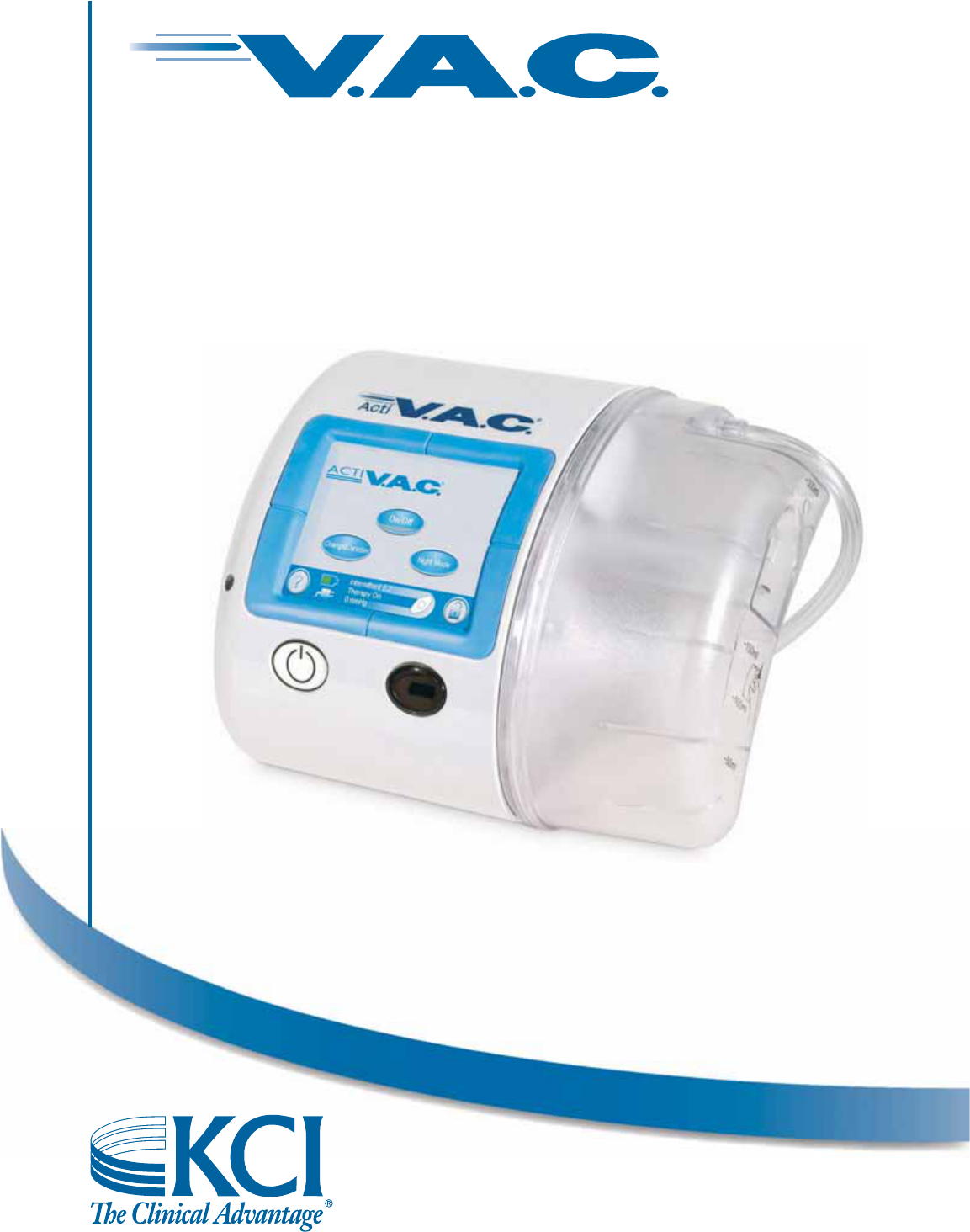
340076 Rev B
July 2007
International User Manual
English
®
A
c
t
i
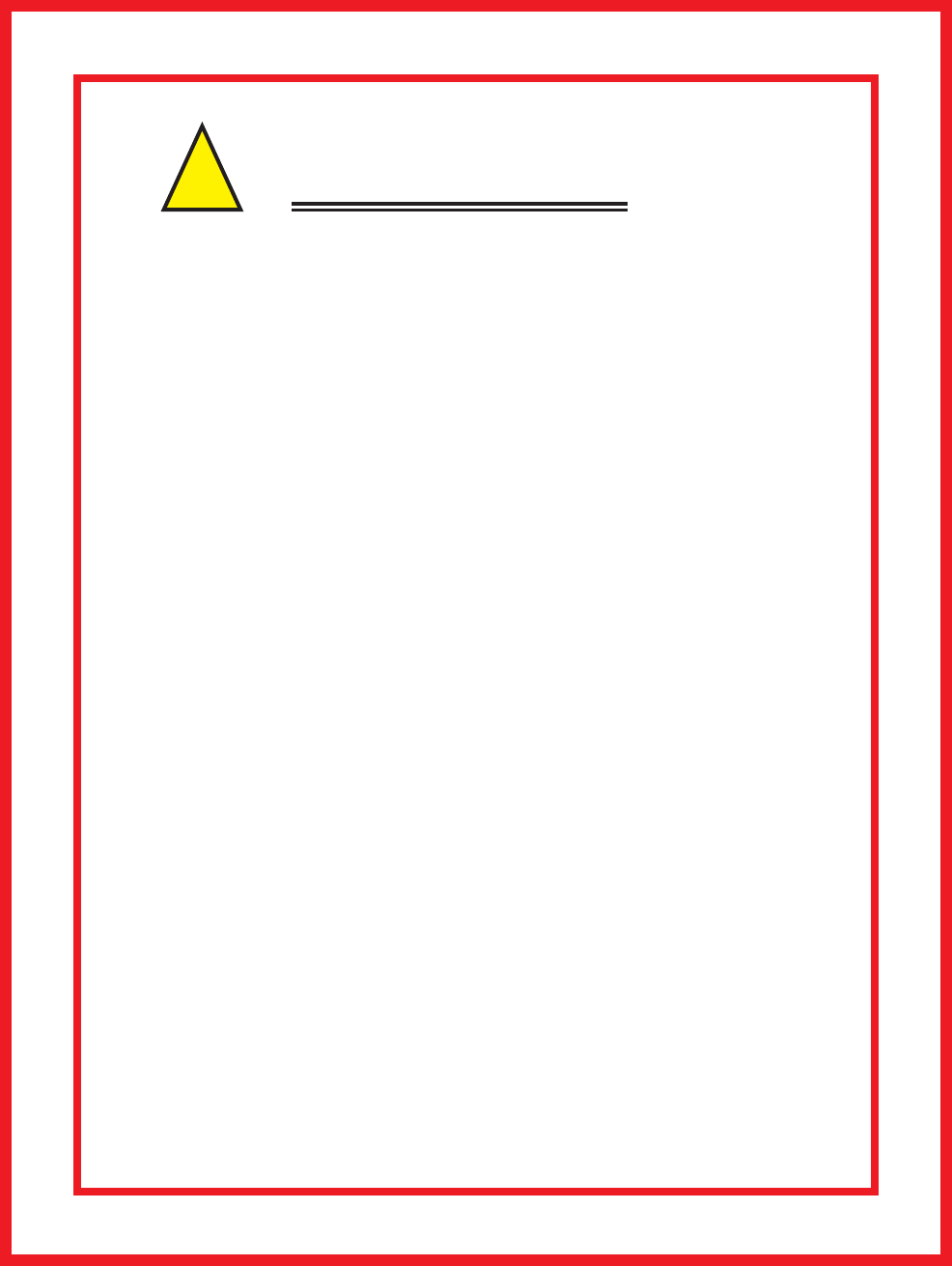
If there are questions or if the
missing,
immediately contact KCI. See back cover of this User
Manual for country specific contact information.
V.A.C. Therapy Safety
Information Sheet or Quick Reference Guide are
®
WARNING
Important Safety Information
accompanies this device.
Indications, Contraindications,
Warnings, Precautions and other
Safety Information are contained in the
V.A.C. Therapy Safety Information Sheet,
located in the transit case.
®
To reduce risk of serious or fatal injury, all
caregivers and patients must carefully read
and follow all user instructions and safety
information that accompany KCI products.
The ActiV.A.C. Quick Reference Guide
is located in a pocket on the inside of the
Front Flap of the Carrying Case.
®
!

Table of Contents
(Continued on next page)
Important Safety Information Statement ..........Inside Front Cover
Important Safeguards ....................3
ActiV.A.C. Therapy System Overview ...............4
Introduction .......................6
Patient Mode .......................8
Patient Operating Instructions .................10
Help Menu........................11
Battery Charging Instructions ..................12
Canister Changes .....................14
Inserting the Therapy Unit into the Carrying Case ............20
Carrying Case Configurations ..................21
®
Clinician Mode ......................22
Clinician Operating Instructions .................24
Patient 'Home' Screen ...................8
Common Screen Control Buttons ................8
Navigation Buttons ....................9
Power the ActiV.A.C. Therapy Unit On or Off .............10
Therapy On or Off ....................10
Audio Pause ......................10
Changing Languages ....................11
On-screen Operating Instructions ................11
Battery Charging Indicator Light ................13
Battery Charge Level Indicator .................13
Identifying Canister and Related Parts ...............14
Changing the Canister ...................15
Carrying Case Parts Identification ................16
Canister Change (in Carrying Case)................17
®
Clinician Mode Home Screen .................22
Common Screen Control Buttons ................22
Navigation Buttons ....................23
Power the ActiV.A.C. Therapy Unit On or Off ............24
Accessing Manual Therapy Settings ...............25
Settings ......................25
Pressure Settings ...................26
Intensity Control ....................26
'Continuous' and 'Intermittent' Modes ..............27
Intermittent Settings ...................27
Settings Confirmation ..................28
®
1
®
A
c
t
i

Table of Contents (cont.)
Clinician Operating Instructions (cont.)
Starting Therapy .....................31
View or Export Therapy History .................35
Clinician Help Menu ....................37
Clinician Utilities .....................38
Alerts and Alarms .....................40
Important Information About Alerts and Alarms ............40
Frequently Asked Questions ..................50
Standard Precautions ....................52
Care and Cleaning .....................53
Manufacturer Information ...................55
Explanation of Symbols Used ..................56
Specifications ......................57
Customer Contact Information ..............Back Cover
Settings Guide ......................28
Settings Guide Confirmation ................30
Seal Check™ Overview ...................31
How to Use Seal Check™ (When Starting Therapy)...........32
Finding the Leak Using Seal Check™ ...............32
Log Tool Overview ....................33
How to Use Log Tool (When Starting Therapy) ............33
View Therapy History ...................35
Export Therapy History Report .................36
Troubleshooting USB or Infrared Export Problems ...........36
Changing to Patient or Clinician Mode...............37
Changing Time and Date ..................38
Changing Pressure Units and Date Format .............39
Changing Screen Brightness .................39
Changing AC Light ....................39
Index of Alerts and Alarms ..................40
2
®
A
c
t
i
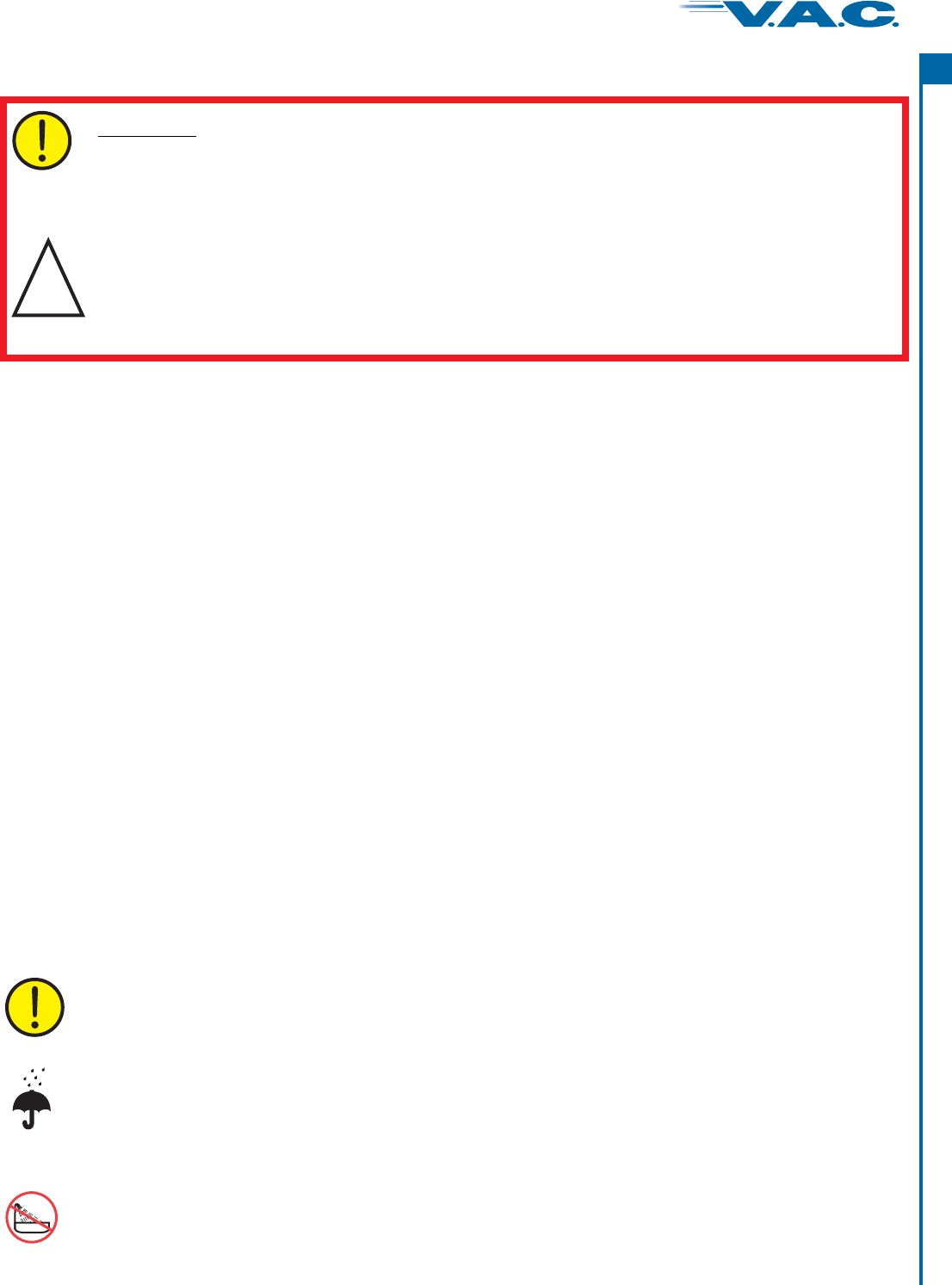
Important Safeguards
In order for KCI products to provide safe and proper performance:
The product must be used in accordance with this manual.
It is recommended that the ActiV.A.C. Therapy Unit always be kept in the Carrying Case when in use.
The ActiV.A.C. Therapy System may present a tripping hazard if placed on the floor. Ensure that the
ActiV.A.C. Therapy Unit is not placed in areas where people may walk.
To help provide safe and effective use, V.A.C. Dressings are only to be used with
V.A.C. Therapy Units.
All assembly, adjustment, modification, maintenance and/or repair should be carried out by qualified
personnel authorized by KCI.
The electrical installation of the room must comply with the appropriate electrical wiring standards.
Refer to the section of this manual for information on infection control
procedures. Refer to the section for recommended daily and weekly cleaning
for the ActiV.A.C. Therapy Unit.
Never operate this product if it has a damaged power cord, power supply or plug. Should the power
cord, power supply or plug be found to be worn or damaged, contact KCI. See back cover.
Never drop or insert any object into any opening or tubing of the ActiV.A.C. Therapy System.
Do not connect or attach V.A.C. Therapy units or its components, to devices not recommended by KCI.
Keep the ActiV.A.C. Therapy System away from heated surfaces.
Although the ActiV.A.C. Therapy System conforms to the intent of the standard IEC 60601-1-2 in
relation to Electromagnetic Compatibility, electrical equipment may produce interference. If
interference is suspected, separate the equipment and contact KCI.
·
·
·
·
·
·
·
·
·
·
·
®
®
®
®
®
®
®
®
®
®
Please note:
Standard Precautions
Care and Cleaning
·
See back cover.
WARNING: As with all prescription medical devices, failure to follow product
instructions or adjusting settings and performing therapy applications without the
express direction and/or supervision of your trained clinical caregiver may lead to
improper product performance and the potential for serious or fatal injury. For medical
questions, please consult a physician.
Important Safety Information is located in the transit case and the ActiV.A.C. Quick
Reference Guide is located in a pocket on the inside of the Front Flap of the Carrying Case.
If the V.A.C. Therapy Safety Information Sheet or Quick Reference Guide are missing,
immediately contact KCI for a replacement. See back cover for contact information.
®
®
!
Liquids remaining on the electronic controls can cause corrosion that may cause the
electronic components to fail. Component failures may cause the unit to operate
erratically, possibly producing potential hazards to patient and staff.
·
·
·
·
Avoid spilling fluids on any part of the ActiV.A.C. Therapy Unit.
If spills do occur, unplug the unit immediately if plugged into electrical source and clean the unit
with an absorbent cloth. Ensure there is no moisture in or near the Power Connection and
Power Supply Components before reconnecting power. If the ActiV.A.C. Therapy Unit is not
working properly, contact KCI. See back cover of this User Manual for country specific contact
information.
Do not use ActiV.A.C. Therapy Unit while bathing/showering or where it can fall or be pulled
into a tub, shower or sink.
Do not reach for a product that has fallen into water. Unplug the unit immediately if plugged into
electrical source. Disconnect the unit from dressing and contact KCI. See back cover.
®
®
®
3
®
A
c
t
i
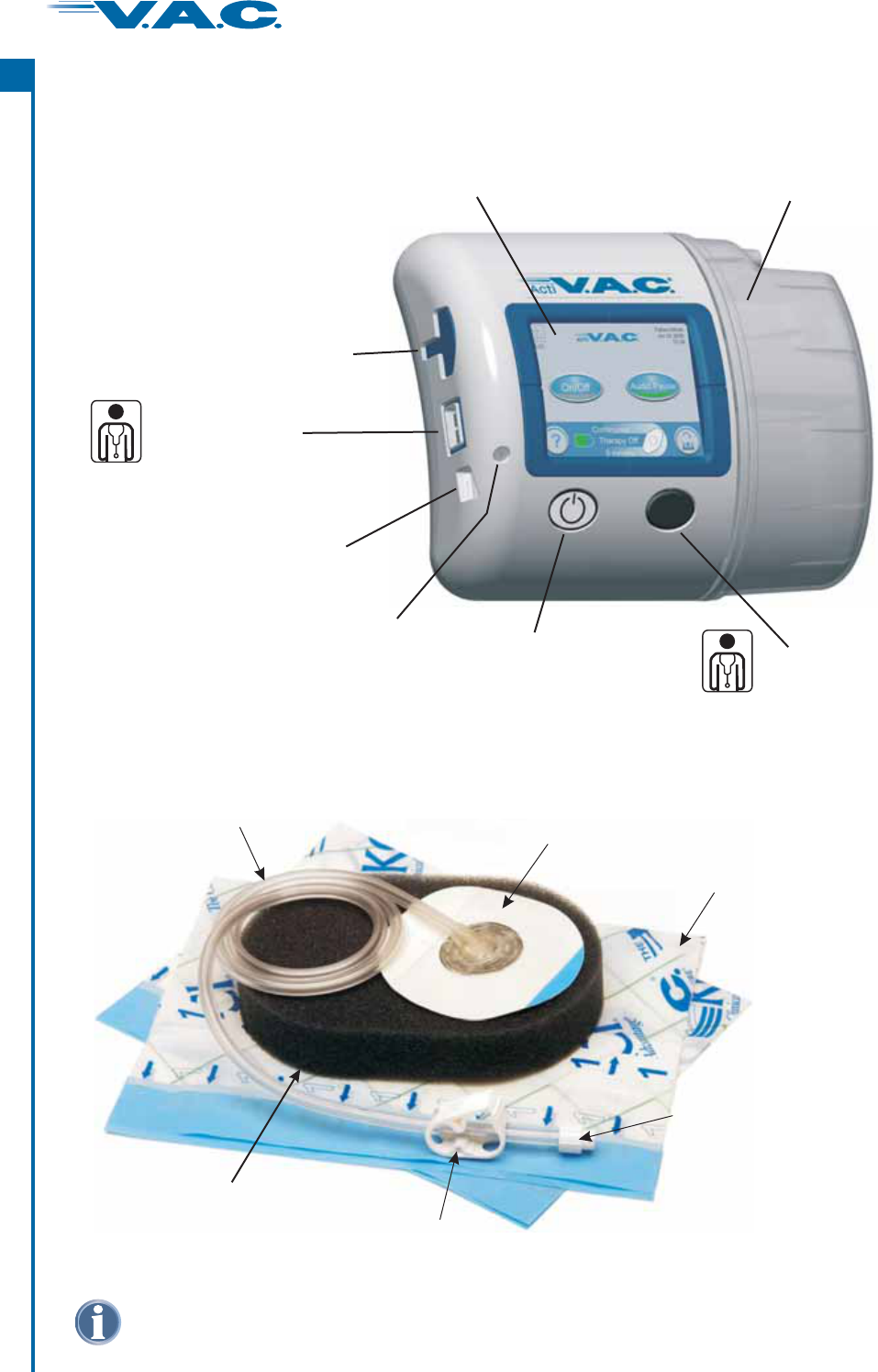
ActiV.A.C. Therapy System Overview
®
Typical V.A.C. Dressing
®
(Not included with therapy unit)
V.A.C. Drape
®
V.A.C. GranuFoam Dressing
®®
SensaT.R.A.C. Pad
®
Tubing
Connector
SensaT.R.A.C. Pad
®
Tubing Clamp
SensaT.R.A.C. Pad
®
Tubing
(dressing tubing)
SensaT.R.A.C. Pad
®
Specific features are detailed in the Patient Feature Identification section of this manual.
Touch Screen User Interface
USB Data Port
Power Connection
Battery Charging
Indicator Light
Infrared Data Port
Power On/Off Button
ActiV.A.C. Canister
®
KCI Authorized
Maintenance
Access Only
A variety of V.A.C. Dressings are available for use with the
®
ActiV.A.C. Therapy System.
®
4
®
A
c
t
i
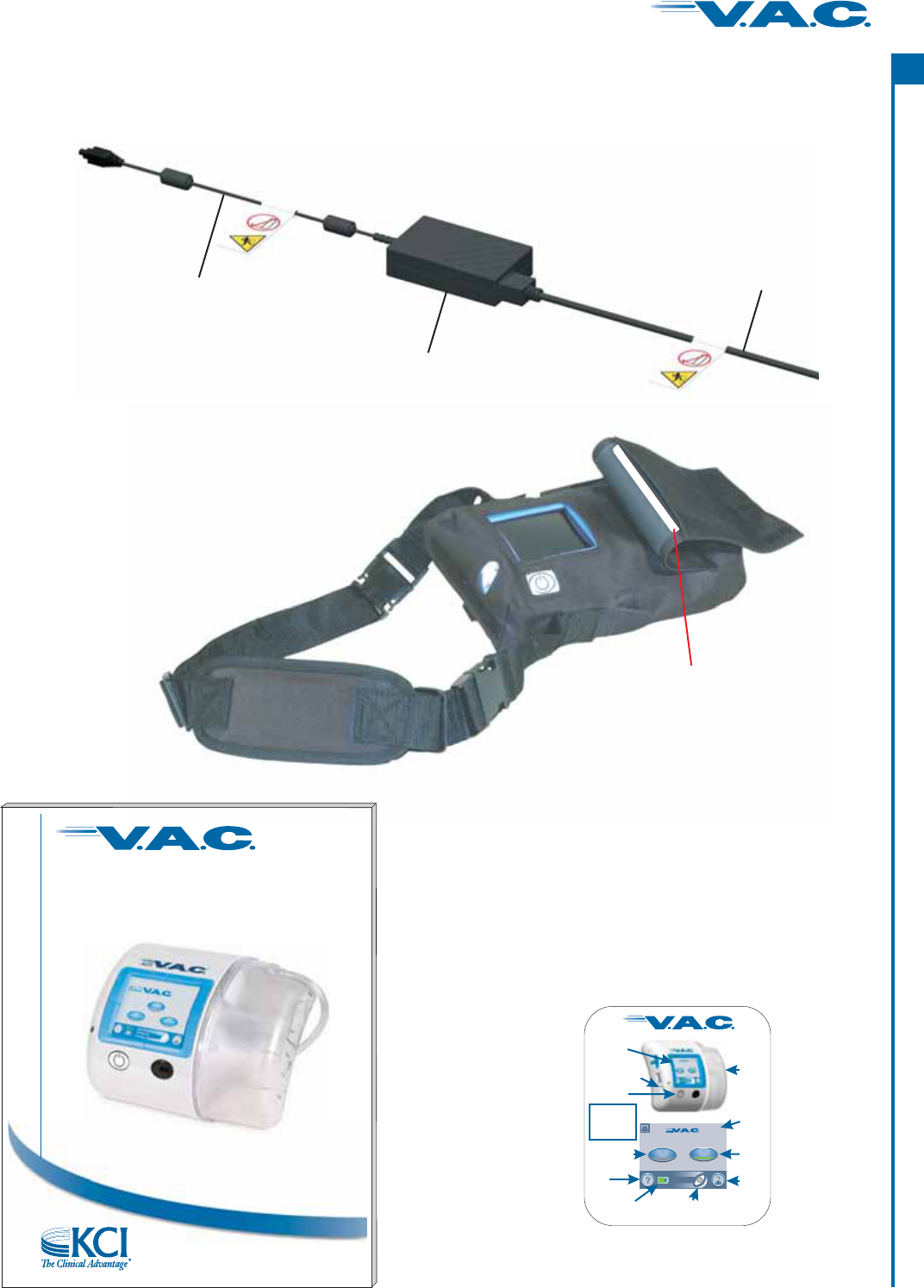
ActiV.A.C. Therapy System Overview
®
ActiV.A.C. Charging Cord
®
DC Power Supply “Brick”
AC Power Cord
ActiV.A.C. Power Supply Components
®
ActiV.A.C.
Quick Reference Guide
®
On/Off
Audio Pause
Patient Mode
Jun 22 2007
15:38
58:23
Continuous
0 mmHg
Therapy Off
®
This icon rotates when
the unit is applying
negative pressure.
Mode
Indicator
with time
and date
Screen
Guard
Pause
Alarms or
Alerts
Battery
Level
Indicator
Help
Button
Therapy On/Off
Power On/Off
Power Connection
Touch Screen
Canister
®
A
c
t
i
Please consult the
User Manual
and Safety Information
Sheet for further
information on the
operation of the
ActiV.A.C.
®
ActiV.A.C. unit.
®
ActiV.A.C. Carrying Case
®
and Adjustable Strap
Storage Pocket for the
ActiV.A.C. uick eference uide
®
QR G
340076 Rev B
July 2007
International User Manual
English
®
A
c
t
i
5
®
A
c
t
i

Introduction
V.A.C. is short for Vacuum Assisted Closure. V.A.C. Therapy is a system that uses controlled
negative pressure (vacuum) to create an environment that promotes wound healing by bringing
the wound edges together, reducing edema, promoting granulation tissue formation and
perfusion, and by removing wound fluids and infectious material. It is a flexible therapy in that,
with appropriate precautions in place, may be used in most instances in both hospital and
community settings. This advanced wound healing technology, coupled with microprocessor-
controlled therapy units, and first-class technical back-up, helps provide peace of mind for both
clinicians and patients.
The V.A.C. family of devices is used to help promote wound healing through multiple
mechanisms of action under the influence of continuous and/or intermittent negative pressure in
association with wound-site feedback control (SensaT.R.A.C. technology). The ActiV.A.C.
Therapy System is a Vacuum Assisted Closure System that provides Negative Pressure Wound
Therapy (NPWT) and Therapeutic Regulated Acute Care (SensaT.R.A.C. ) for use on a variety
of chronic and acute wound types.
® ®
®
®®
®
®
Touch Screen User Interface
Battery Operation
On-Screen Operating Instructions
Seal Check Tool
Carrying Case
The Touch Screen User Interface allows for easy navigation through operational and help
menus. A Screen Guard is available to help prevent unintentional changes.
In order to facilitate mobility and help patients return to daily activities, battery operation is
available with the ActiV.A.C. Therapy Unit. During typical usage, the battery may provide up to
14 hours of operation before needing to be recharged.
Abbreviated “Operating Instructions” are available on-screen. Always familiarize yourself with
and refer to this manual for detailed and specific information for use.
This tool assists in finding air leaks in the SensaT.R.A.C. System and dressing through the use
of audible tones and on-screen visual aids during the troubleshooting process.
A convenient Carrying Case is provided to allow discreet delivery of therapy. It is recommended
that the ActiV.A.C. Therapy Unit always be kept in the Carrying Case.
®
™
®
®
V.A.C. Therapy is prescribed by a physician or other licensed prescriber. The
therapy should only be administered by a medical practitioner. Patients should not
attempt to perform a change of settings and/or therapy application without the
express permission of the treating physician and/or under the supervision of a
trained clinical caregiver.
®
Important product and therapy indications, contraindications, precautions and
safety information apply. Please consult your clinician, the accompanying V.A.C.
Therapy Safety Information Sheet, Quick Reference
Guide (located in the pocket on the inside of the Front Flap of the Carrying Case)
and this User Manual prior to use.
®
(located in the transit case)
ActiV.A.C. Therapy System Key Features
®
6
®
A
c
t
I
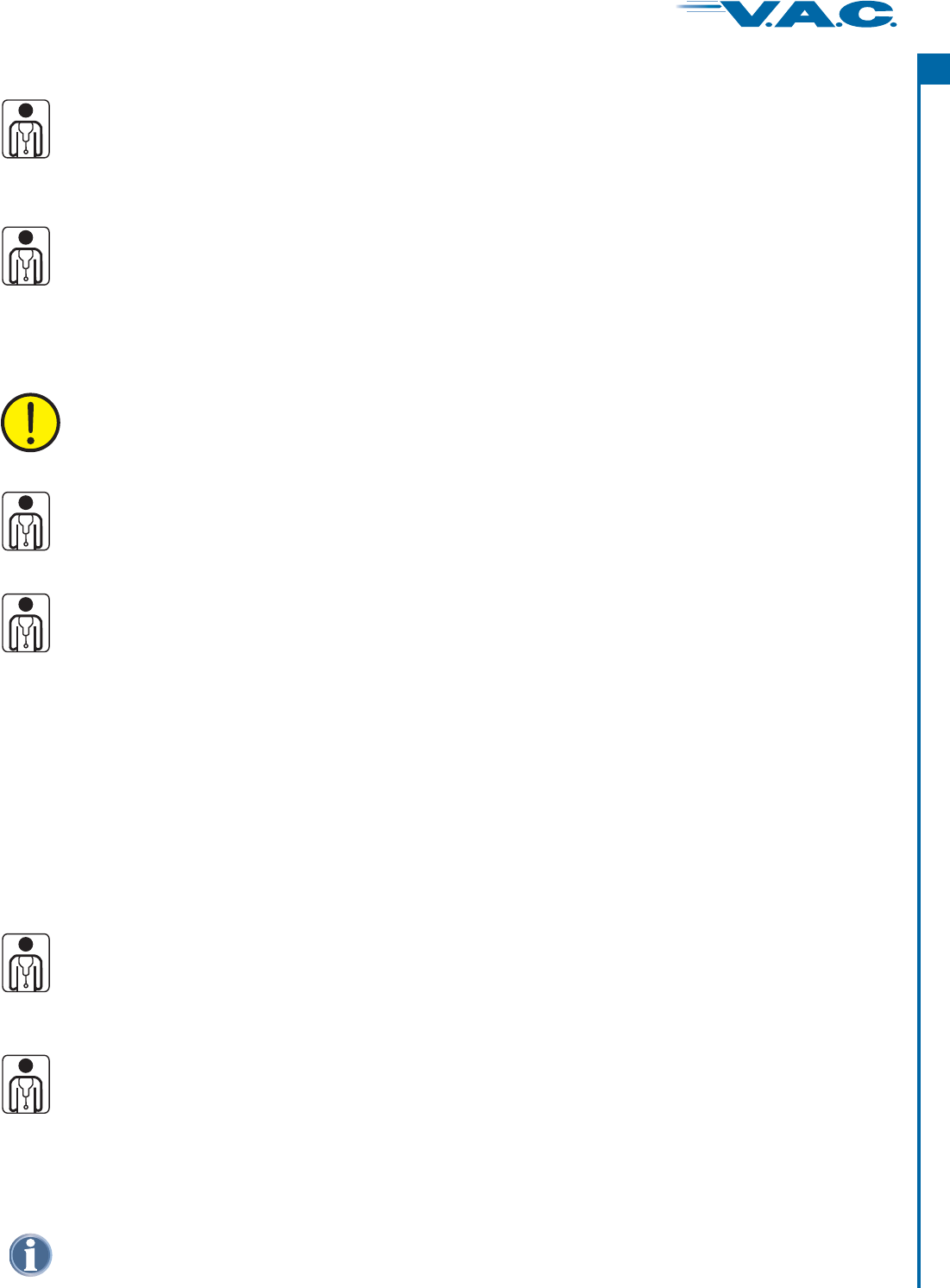
Introduction (cont.)
Patient Mode Control
Therapy History Report
Settings Guide
SensaT.R.A.C. System
Selection of Patient Mode by the clinician can help prevent unauthorized access to
therapy set-up screens. Patient Mode allows the patient to have access to appropriate
screen menus.
A chronological log with date and times for therapy starts/stops, therapy settings, alarm
occurrences, and canister/dressing changes can be reviewed on-screen or transferred
from the ActiV.A.C. Therapy Unit electronically in the form of a Therapy History Report.
This electronic transfer can be accomplished by accessing the Infrared Data Port or by
inserting a USB flash memory stick into the USB Data Port.
V.A.C. Therapy set-up menus are available on-screen to assist in the selection of
therapy settings by wound type.
The SensaT.R.A.C. System monitors and maintains target pressure at the wound site,
helping to deliver consistent therapy. This system includes therapy unit hardware,
software, wound exudate collection canister, canister detection method, multi-lumen
tubing, connector and SensaT.R.A.C. Pad.
®
®
®
®
The USB Data Port is to be used with non-powered memory sticks and drives only.
No AC or battery powered drives, computers, computer equipment, or other
devices may be used.
®
In-Line Canister/Dressing Connectors
300 ml Canister
The SensaT.R.A.C. System incorporates an in-line dressing connector and tubing clamps to
conveniently allow the wound dressing to be temporarily disconnected from the ActiV.A.C.
Therapy Unit.
The ActiV.A.C. Therapy Unit offers a single use, latex-free, sterile 300 ml wound exudate
collection canister.
®
®
®
V.A.C. Dressings
®
A variety of V.A.C. Dressings are available for use with the ActiV.A.C. Therapy System.
®®
Intensity Setting
Therapy Days Display
Intensity is related to the time it takes to reach the target therapy level after the initiation
of therapy. The lower the intensity setting, the slower the target therapy level will be
reached.
Screen will display the number of days since V.A.C. Therapy was first initiated on the
patient.
®
Refer to the Standard Precautions section of this manual for information on infection
control procedures. Refer to the Care and Cleaning section for recommended daily and
weekly cleaning for the ActiV.A.C. Therapy Unit.
®
7
®
A
c
t
I
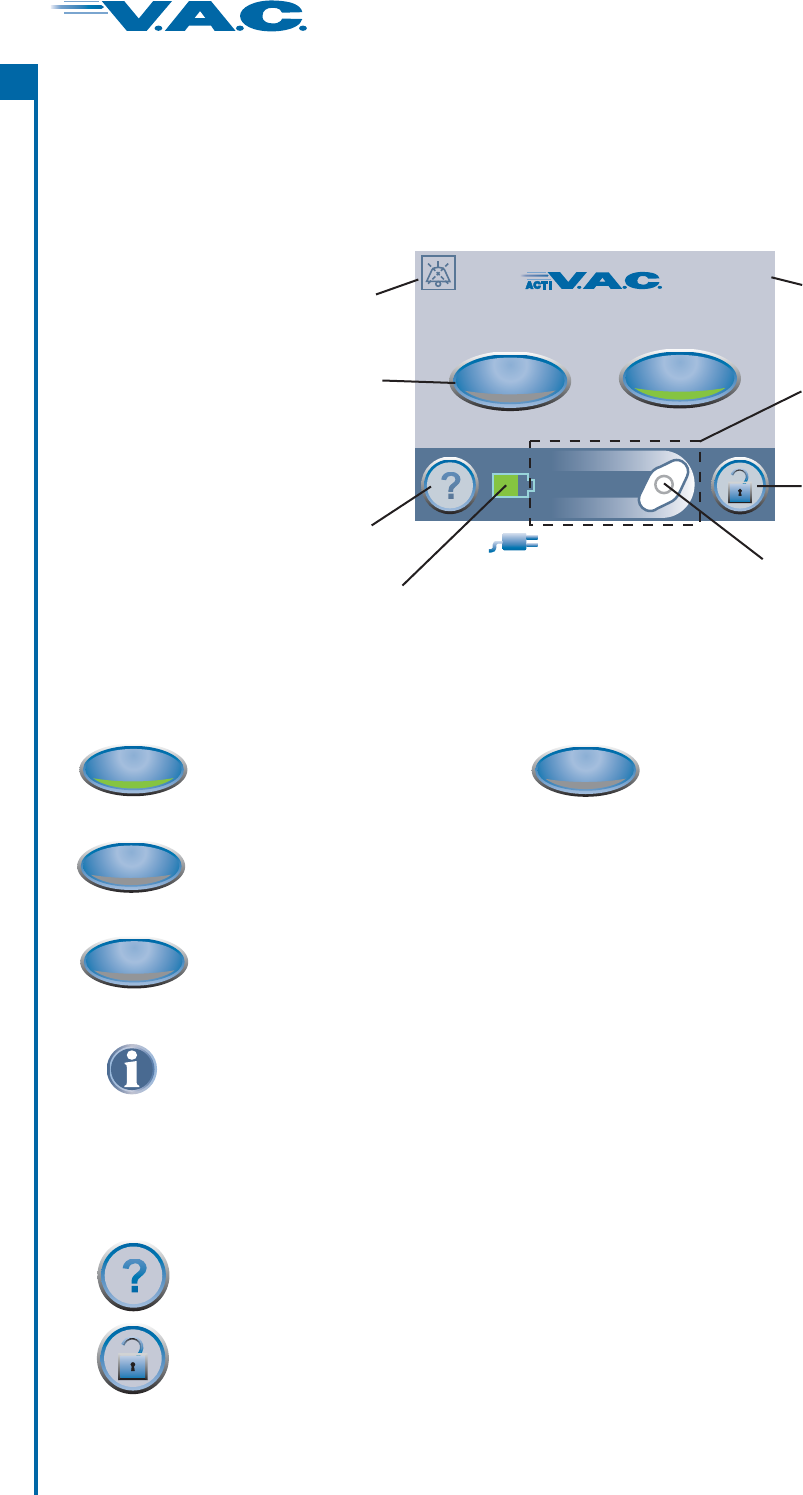
On/Off
Audio Pause
Patient Mode
Jun 22 2006
15:38
58:23
Continuous
0 mmHg
Therapy Off
®
Patient Mode
This icon rotates when the
ActiV.A.C. Therapy Unit is
applying negative pressure.
®
Audio Pause
Indicator with
Countdown Timer
Mode Indicator
Current Date
Current Time
Therapy Status
Bar and Display
Area.
Screen Guard
Battery Level Indicator
Help Button
Therapy On/Off
Button
This “plug” indicator
while plugged
into .
appears
a wall outlet
Patient ‘Home’ Screen
Common Screen Control Buttons
accesses screensHelp .
activates the feature .Screen Guard to help prevent unintentional changes This
feature should be used when cleaning the Touch Screen User Interface.
To release Screen Guard, press ‘1’ and then ‘2’.
A green lighted crescent
means the function is on.
An unlit crescent
means the function is off.
On/Off
starts or stops V.A.C. Therapy.
®
Audio Pause
When the Audio Pause button is selected, alerts that do not need immediate
attention will be silenced for 60 minutes. A Countdown Timer and Audio Pause
Indicator will be displayed in the upper left hand corner of the screen.
Alarms needing immediate attention override this feature.
Most screens have one or more common control buttons. These are:
8
®
A
c
t
I
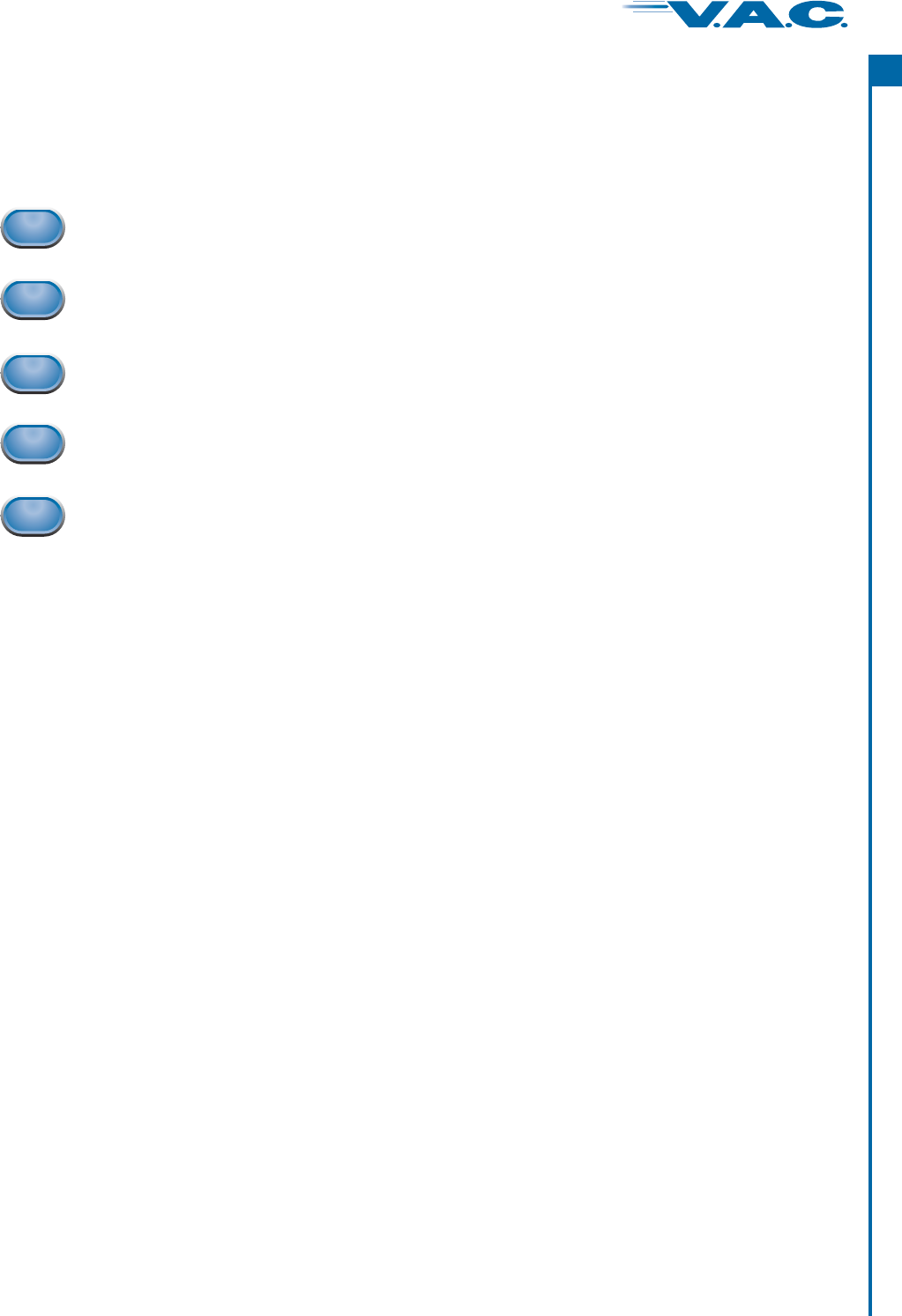
Patient Mode (cont.)
One or more of these buttons may appear on a screen.
returns to the previous screen of that particular procedure.
Back
goes to the next screen of that particular procedure.
Next
stops action in progress.
Cancel
leaves that particular screen.
Exit
Navigation Buttons
acknowledges the action is complete and displays the next screen.
OK
9
®
A
c
t
I
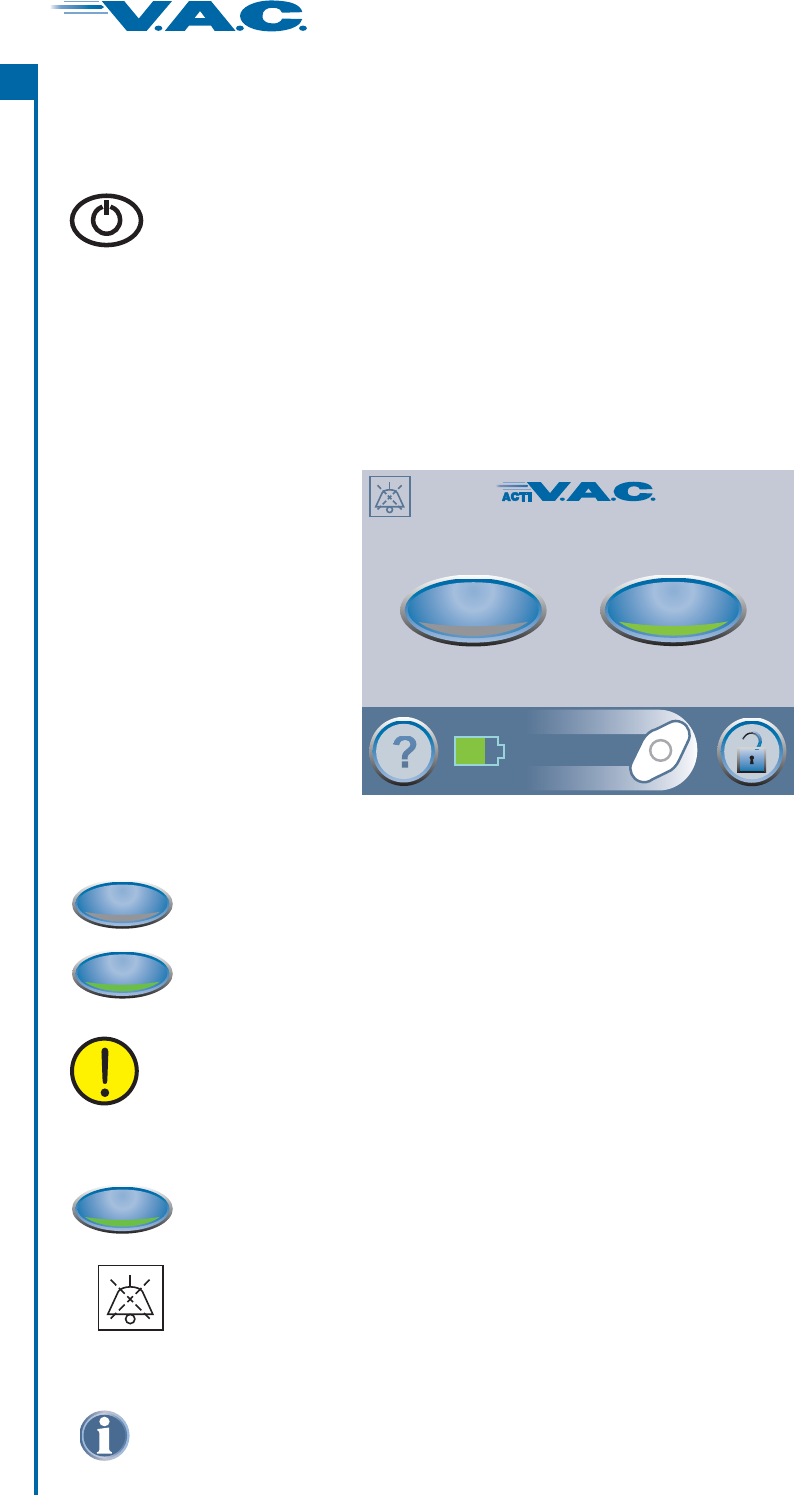
Power the ActiV.A.C. Therapy Unit On or Off
®
Patient Operating Instructions
Press and hold the button for approximately 2 seconds to turn the
ActiV.A.C. Therapy Unit On or Off.
Power On/Off
®
Therapy On or Off
green crescent on the On/Off button means V.A.C. Therapy is on.
®
On/Off
On/Off
Alarms needing immediate attention override the Audio Pause feature. See the Alerts and
Alarms section of this manual for details on alarms and how to resolve them.
Audio Pause
When the Audio Pause button is selected, alerts that do not need immediate
attention will be silenced for 60 minutes.
Audio Pause
On/Off
Audio Pause
Patient Mode
Jun 22 2006
15:38
58:23
Continuous
0 mmHg
Therapy Off
®
58:23
A Countdown Timer and Audio Pause Indicator will be displayed in the upper left
hand corner of the screen
The ActiV.A.C. Therapy Unit will go through a self-check routine and then presents a ‘
’ screen. Press ‘ ’ to continue to the Patient Mode Home screen (shown below).
®
Warning
Message OK
The Power On/Off button is located immediately below and to the left of the Touch
Screen User Interface. Refer to the Patient Feature Identification section for more information.
starts or stops V.A.C. Therapy.
®
WARNING: Under clinician supervision, replace V.A.C. Dressing with alternate
dressing if therapy is interrupted for more than two hours.
®
10
®
A
c
t
I
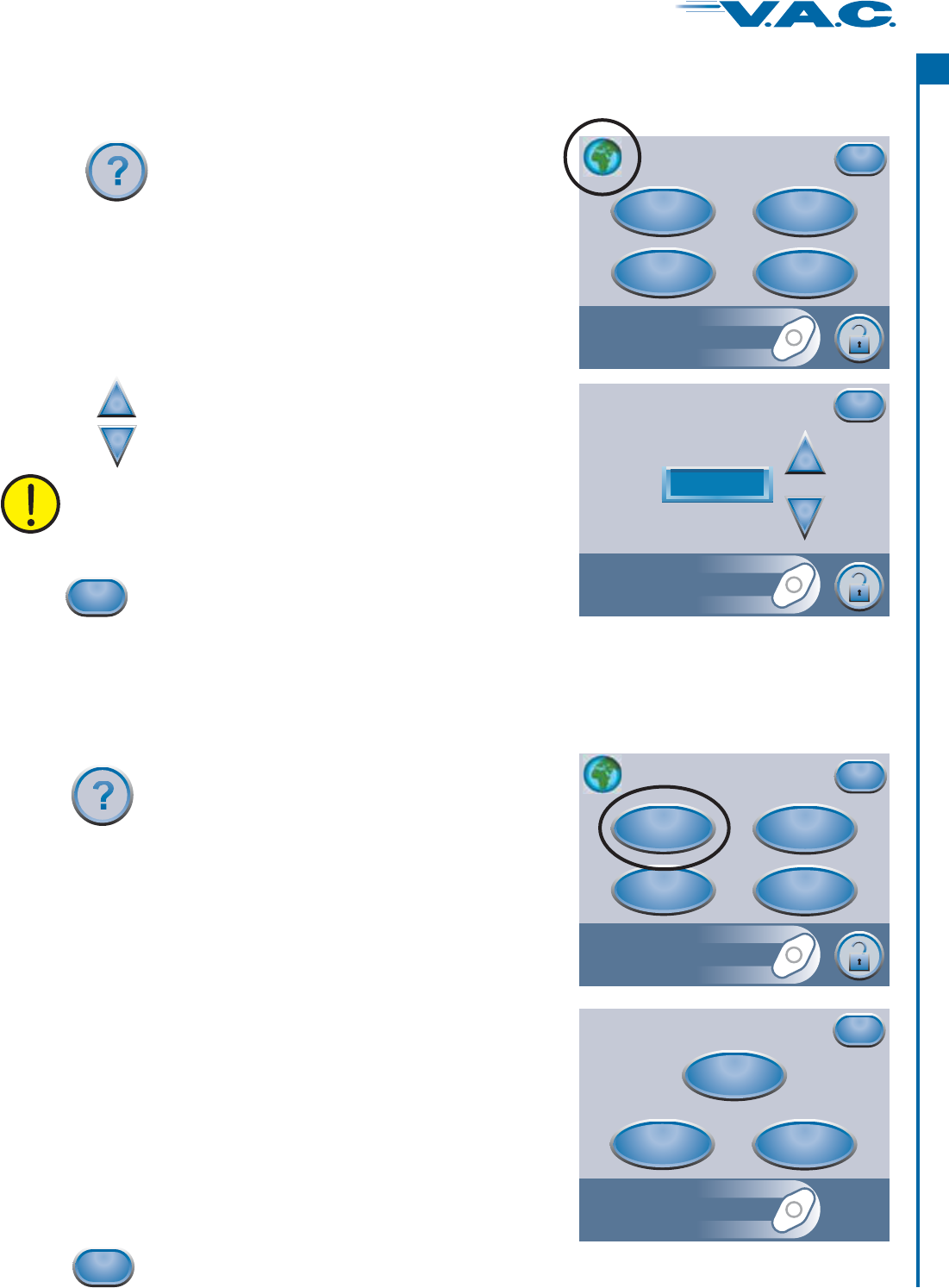
WARNING: Languages should only be selected
according to local regulatory requirements.
On-screen Operating Instructions
Press ‘ ’ to access the ‘
’ selection screen.
Operating Instructions Operating
Instructions
Help Menu
Operating
Instructions
Contact
Information
About
Exit
Clinician
Mode
Operation
Cleaning
Alarms
Exit
Operating Instructions
From this ‘ ’ screen, one can browse
the various ‘ ’ that are available.
Choose from:
‘’ ,
‘ ’ instructions and
‘ ’ for alarm descriptions and their suggested
resolutions.
Operating Instructions
Help Screens
Operation
Cleaning
Alarms
• instructions
•
•
when finished.Press
Exit
Press
to access the ‘ ’.Help Menu
Changing Languages
Press the ‘ ’ (upper left) to access the ‘ ’
screen.
Globe Language
Press
to access the ‘ ’.Help Menu
Help Menu
Operating
Instructions
Contact
Information
About
Exit
Clinician
Mode
when finished.Press
Exit
Language
Exit
English
+
_
Help Menu
Use the buttons to select the required language.
+
_
11
®
A
c
t
I

Battery Charging Instructions
Use only the power supply provided with the ActiV.A.C. Therapy Unit. Using any
other power supply may damage the ActiV.A.C. Therapy Unit.
®
®
If environmental conditions (specifically, low humidity) pose a risk of static electricity,
care should be taken when handling the ActiV.A.C. Therapy Unit when it is out of the
Carrying Case and plugged into an AC wall outlet. In rare instances, discharge of static
electricity when in contact with the therapy unit may cause the Touch Screen User
Interface to darken, the therapy unit to reset or the therapy unit to turn off. If unable to
restart therapy by powering the therapy unit off and then on, immediately contact KCI.
See back cover of this User Manual for country specific contact information.
®
P mayower cords present a tripping hazard. Ensure that all cords are out of
areas where people may walk.
The comes with a rechargeable battery. The battery is not user
accessible or serviceable.
ActiV.A.C. Therapy Unit
®
The power supply has a two-part cord; one that plugs into an AC wall outlet and one that
plugs into the ActiV.A.C. Therapy Unit.
®
WARNING: Under clinician supervision, replace V.A.C. Dressing with alternate
dressing if therapy is interrupted for more than two hours.
®
AC Wall Plug
Plug to DC Power
Supply “Brick”
Charging
Cord
Connector
Battery
Charging
Indicator Light
Tripping Hazard
No bathing or
showering
8
2
1
4
Battery Level
Indicator location
AC Power Cord
Tripping Hazard
No bathing or
showering
3
12
®
A
c
t
I
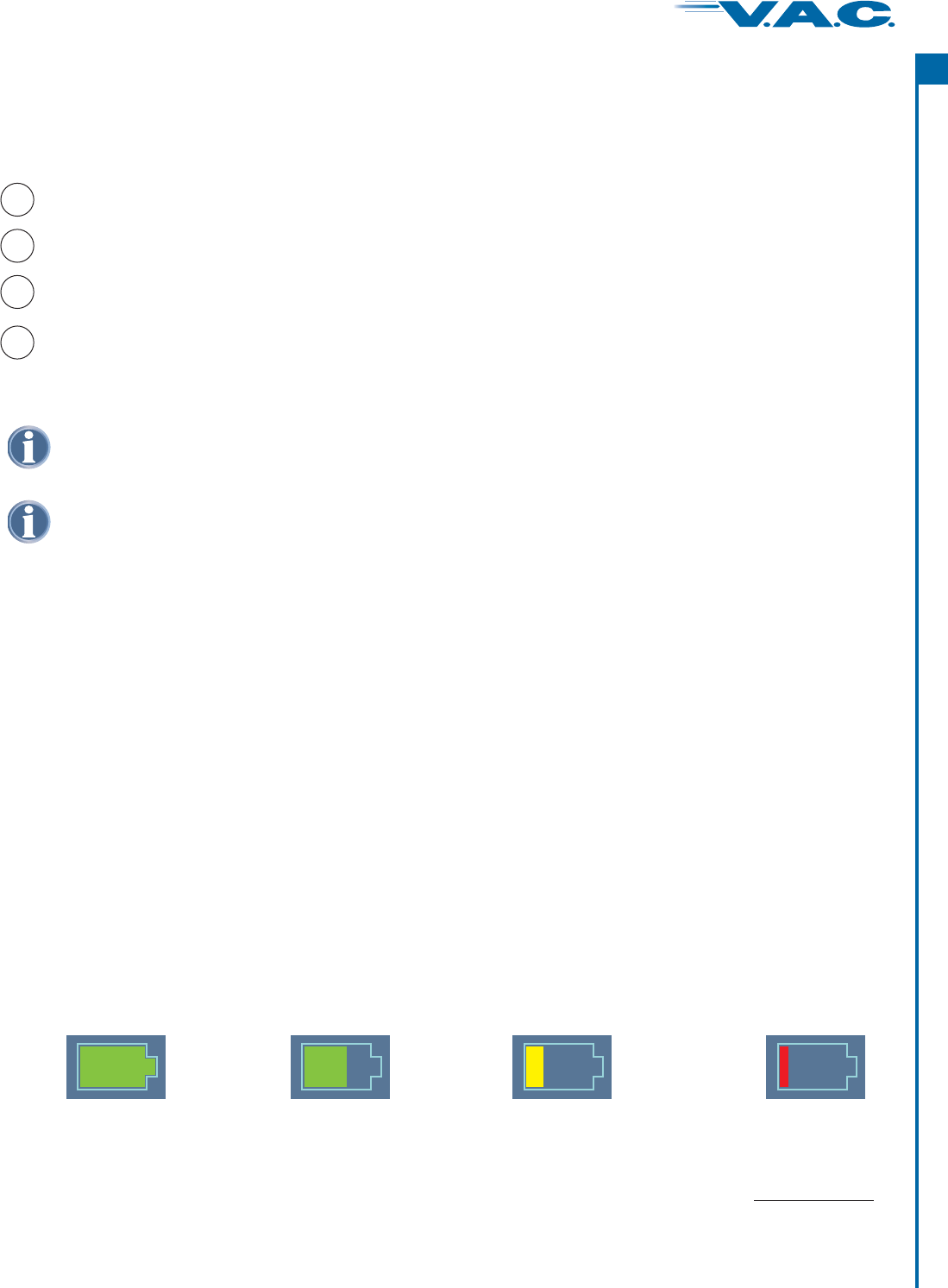
It should take approximately 6 hours to fully recharge the battery from a completely
discharged state.
To maximize battery life, keep the unit plugged in when the patient is not mobile for
significant periods.
Battery Charging Instructions (cont.)
2
1
3
4
Plug the AC Power Cord into the DC Power Supply “Brick”.
Plug the AC Wall Plug into an AC wall outlet.
Locate the “Arrow” on the ActiV.A.C. Charging Cord Connector.
With ActiV.A.C. Touch Screen User Interface facing up, the “Arrow” should also be up as the
Charging Cord Connector is plugged into the Power Connection on the ActiV.A.C. Therapy
Unit.
®
®
®
The battery level is shown on the bottom of the Touch Screen User Interface.
When the ActiV.A.C. Therapy Unit is correctly plugged into the ActiV.A.C. Power Supply, the
will glow as the battery is charging.
When the battery has reached full charge the will glow
® ®
Battery Charging Indicator Light Amber
Battery Charging Indicator Light Green.
Battery Charging Indicator Light
Battery Level Indicator
Fully
Charged
Battery
Critical
Battery
Low
(Charge battery soon)
(Charge battery
)immediately
In
Use
Steps are numbered in order. See picture on previous page.
13
®
A
c
t
I
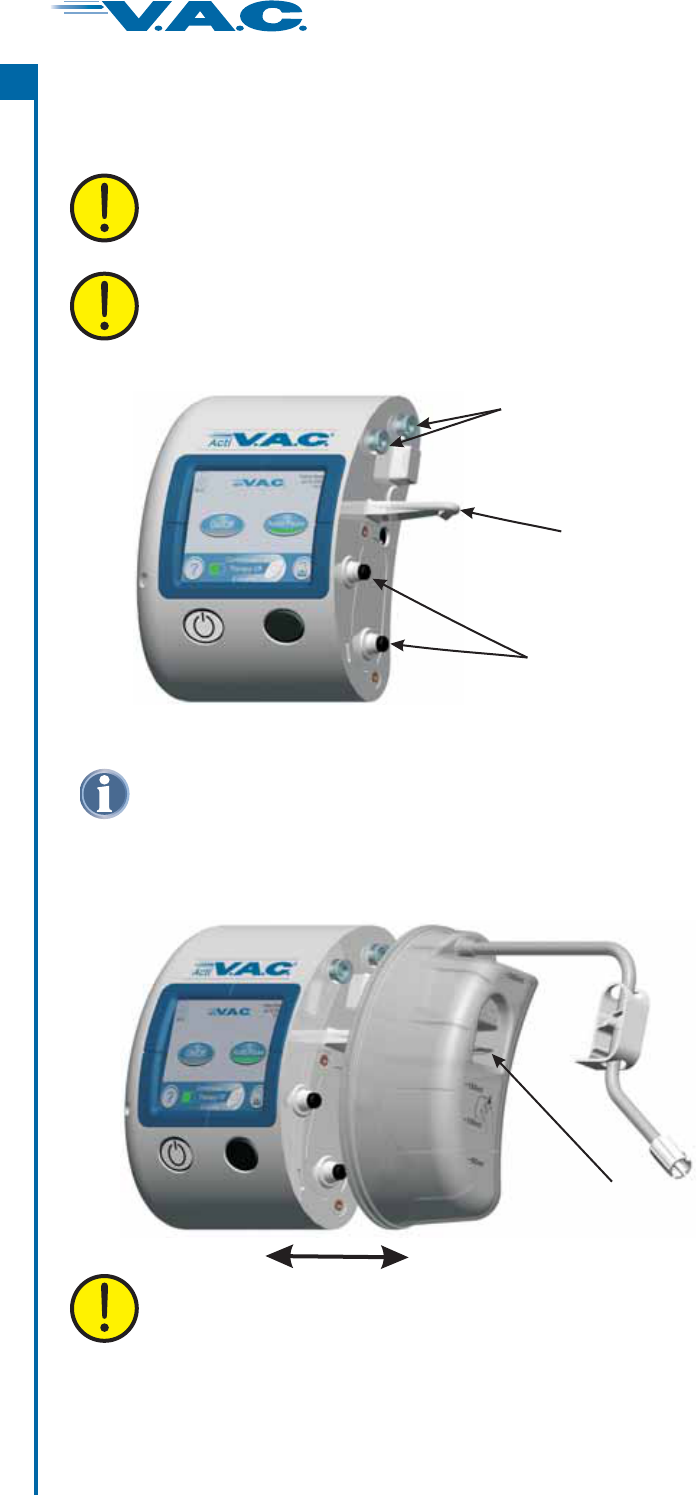
Identifying Canister and Related Parts
Canister Latch Guide on the therapy unit may have sharp edges. Do not handle
the ActiV.A.C. Therapy Unit by the Canister Latch Guide.
When not in use, always store the ActiV.A.C. Therapy Unit in the Carrying Case
without a canister in place.
®
®
Canister Latch Guide
Canister Stabilization Bumpers
Canister Latch Release
Silicone Seals
Canister is always applied straight on and straight off the ActiV.A.C. .
Do not twist or turn canister when installing or removing.
®
Therapy Unit
Contact KCI if the Silicone Seals, Canister Latch Guide or the Canister Stabilization
Bumpers are damaged or missing. See back cover of this User Manual for country
specific contact information.
Canister Changes
14
®
A
c
t
I

5
2
6
3
(1.)
(2.)
4
Changing the Canister
See section for change instructions when in the
Carrying Case.
Canister Change (in Carrying Case)
Do not turn power off to the Therapy Unit.
ActiV.A.C.
®
1. Stop V.A.C. Therapy by pressing on the Touch Screen User Interface.
®
On/Off
Dispose of the canister according to institution and local
environmental regulations.
The ActiV. .C. Canister should be changed when full (the alarm will sound), or at least
once a week to control odor.
®
A
2 Slide both tubing clamps toward the tubing connector
picture .
. . See
2
3. Tightly close both tubing clamps. (Several clicks should be
heard). See picture .
3
4. Disconnect the dressing tubing from the canister tubing by:
(1.) twisting the tubing connectors until the locking tabs are
disengaged,
(2.) pulling the connector apart. See picture .
4
5 e picture .. Depress the Canister Latch Release. Se
5
6 therapy
e picture .
. Remove the canister from the unit by pulling the
canister directly away from the unit. Se
6
V.A.C. Therapy is already off if addressing a Canister Full Alarm.
®
15
®
A
c
t
I
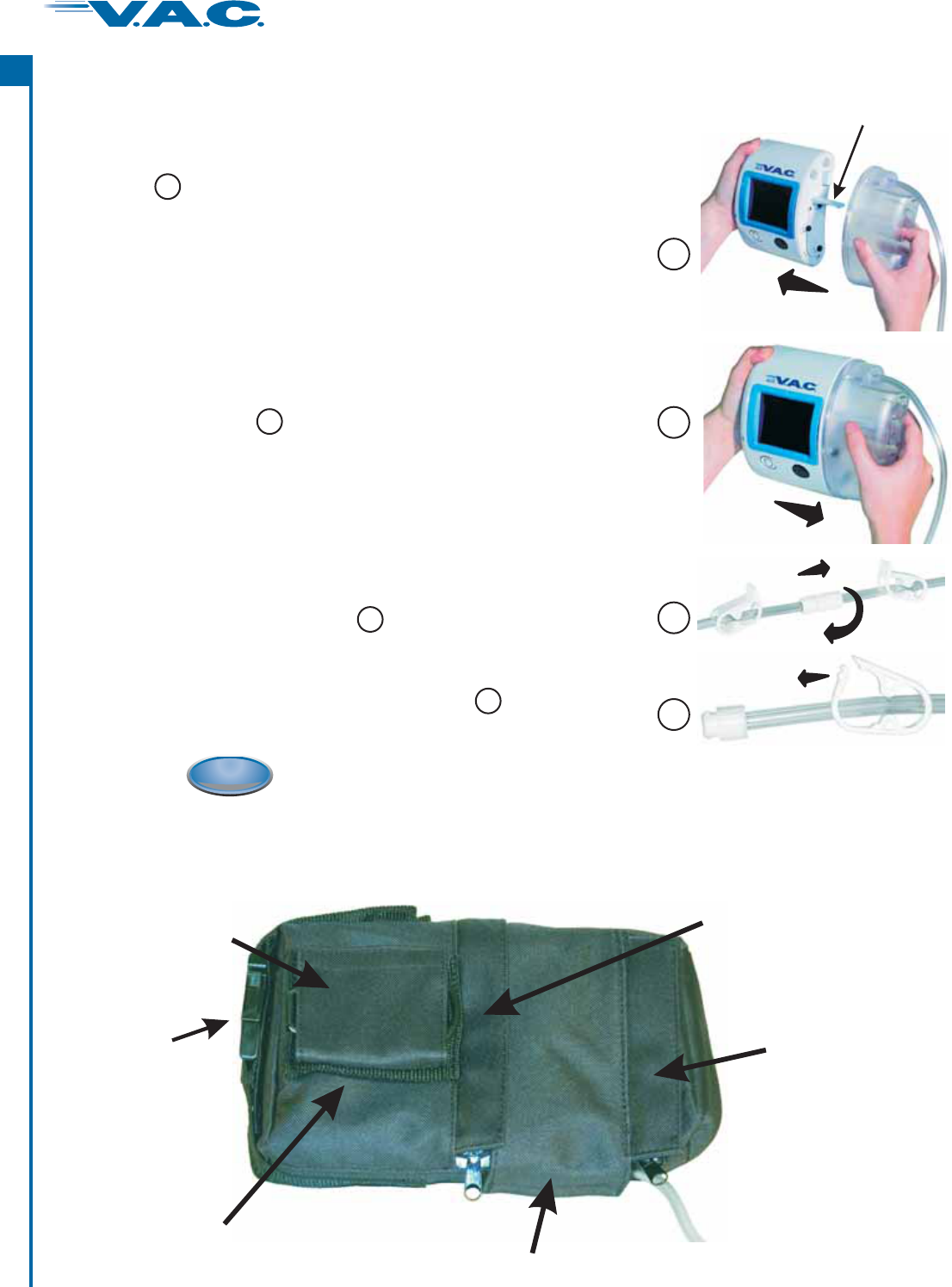
1 . Press to restart V.A.C. Therapy1 on the Touch Screen User Interface . Verify
the dressing compresses.
®
On/Off
Canister Latch Guide
7
8
(1.)
(2.)
9
Flap covering
Multi-function Hook
Built-in
Belt Loop
(underneath)
Buckles
(shown connected)
Center Zipper
with Covering Flap
Access Flap with Hook
and Loop Fastener
Tubing Storage
Pocket with Zipper
and Covering Flap
Carrying Case Parts Identification (rear view)
7 therapy
i Guide
t c therapy
picture .
An audible “click” should be heard when canister is properly
installed.
. Install the new canister onto the unit by sliding the
opening n the canister over the Canister Latch . Ensure
he anister is installed directly onto the unit. See
Do not twist or turn the canister as it is being installed.
7
8 therapy
e picture .
. Ensure the canister is securely installed on the unit.
If the canister is properly installed, the canister cannot be
removed by gently pulling the canister directly away from the
unit. Se
8
9 dressing tubing :
(1.) the connectors
(2.) wisting the connectors
See picture .
. Reconnect the new canister tubing to the by
pushing together and
t until the locking tabs are fully
engaged.
9
10
10 both e picture .. Open tubing clamps. Se
10
Changing the Canister (cont.)
16
®
A
c
t
I
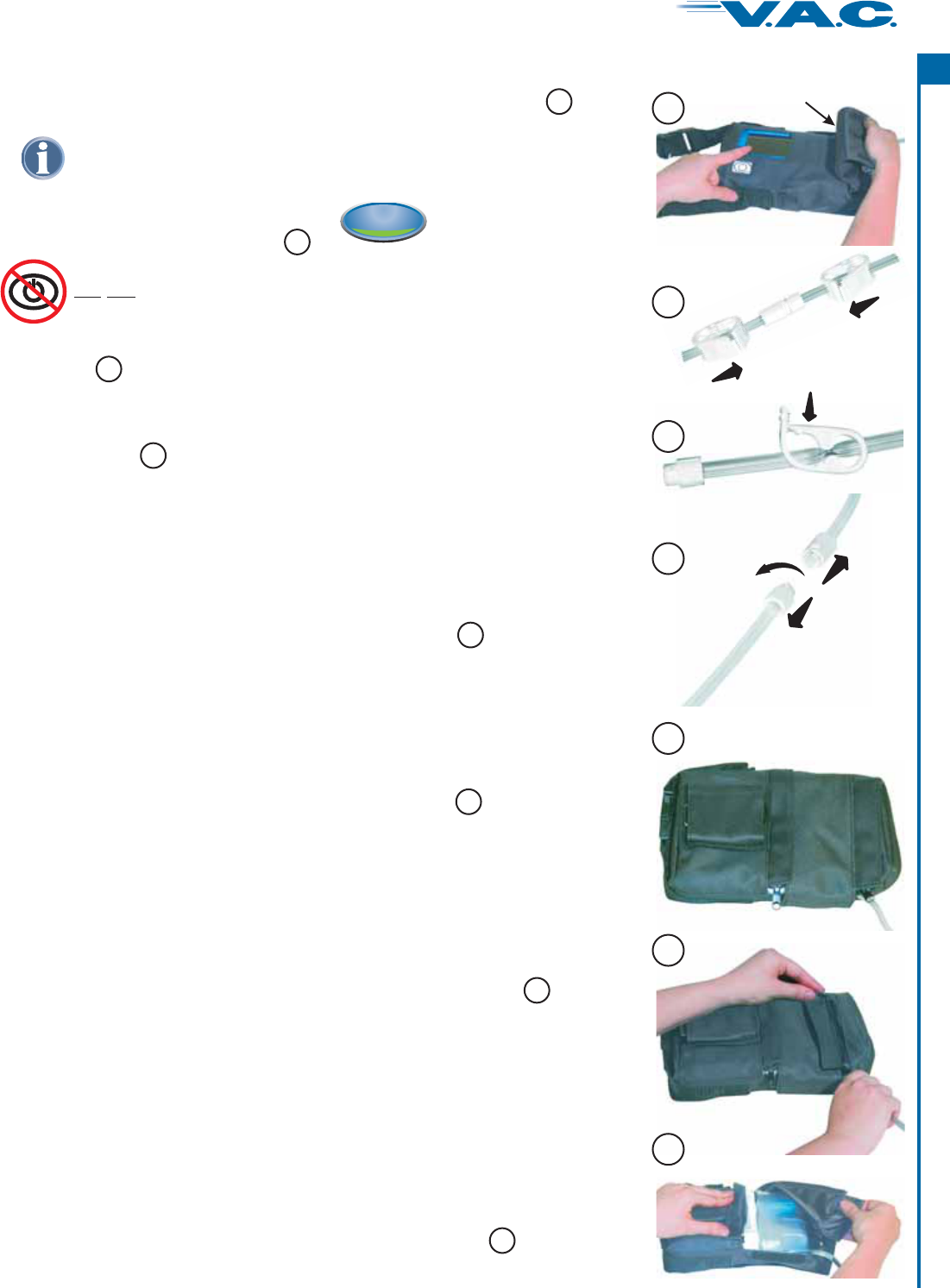
(1.)
(2.)
4
2
1
Front Flap
3
Canister Change (in Carrying Case)
Do not turn power off to the Therapy Unit.ActiV.A.C.
®
4. Disconnect the dressing tubing from the canister tubing by:
(1.) twisting the tubing connectors until the locking tabs are
disengaged,
(2.) pulling the connector apart. See picture .
4
5
5. Close the Front Flap and turn the ActiV.A.C. Therapy Unit over so
that its Front Flap is facing down. See picture .
®
5
6
Remove the tubing from the Tubing Storage Pocket.
6. Unzip the Tubing Storage Pocket Zipper. See picture .
6
7
7. Unzip the Center Zipper on the back of the case. Undo the Hook
and Loop Fastener on the Access Flap and fold the Access Flap
back to begin to expose the canister. See picture .
7
2 Slide both tubing clamps toward the tubing connector. . See
picture .
2
1. Open the Front Flap on the Carrying Case. See picture .
f addressing a Canister
Full Alarm.
Stop V.A.C. Therapy by pressing on the Touch Screen
User Interface. See picture .
V.A.C. Therapy is already off i
®
®
On/Off
1
1
3. Tightly close both tubing clamps. (Several clicks should be heard).
See picture .
3
17
®
A
c
t
I

Canister Change (in Carrying Case) cont.
8 Grasp the ActiV.A.C. Therapy Unit in one
hand and turn the unit and case so that the
canister is facing up. Continue to fold the
Access Flap back until the is
.
See pictures and .
®
.
canister fully
exposed
8a
8b
9a
9b
9
Press the Canister Latch Release and
remove the canister from the therapy unit.
ActiV.A.C. Therapy Unit so that
the Canister Latch Release can be pressed
toward the 50ml graduation mark.
See picture .
See pictures and .
®
. Position the
9a
9a
9b
10a 10b
10. Install the new canister onto the ActiV.A.C.
Therapy Unit by sliding the opening in the
canister over the Canister Latch Guide. Do
not twist or turn the canister as it is being
installed. See picture
Push the canister onto the therapy unit. An
audible “click” should be heard.
See picture .
®
.
10a
10b
Ensure that no part of the case is
between the canister and the
ActiV.A.C. Therapy Unit.
®
11. Ensure the canister is securely installed on
the therapy unit. If the canister is properly
installed, the canister cannot be removed by
gently pulling the canister directly away from
the therapy unit.
8a
Canister
8b
Canister
12. Pull the Access Flap back over the
canister and ActiV.A.C. Therapy Unit so
that the canister is covered by the case.
See pictures and .
®
12a
12b
12a
Access
Flap
12b
Dispose of the canister according to
institution and local environmental
regulations.
18
®
A
c
t
I
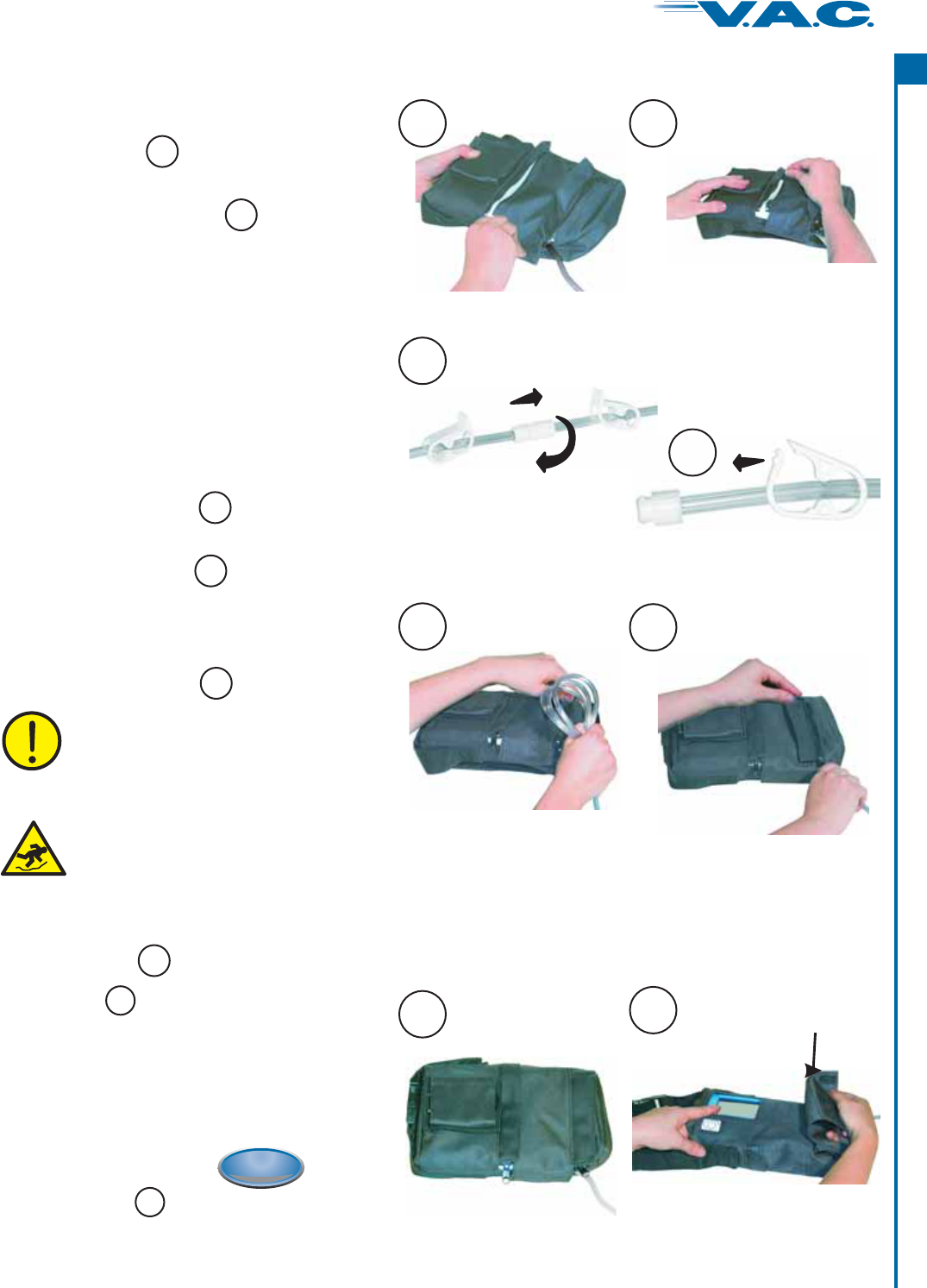
Canister Change (in Carrying Case) cont.
14a
14b
14 Reconnect the new canister tubing to
the dressing tubing by:
(1.) pushing the connectors together
and
(2.) twisting the connectors until the
locking tabs are fully engaged.
See picture .
Open both tubing clamps.
See picture .
.
14a
14b
13b
15a
13a
16
15b
15. Wrap any excess tubing into a bundle and
put the tubing into the Tubing Storage
Pocket on the bottom of the Carrying
Case. See picture .
Ensure there are no kinks or the
tubing is not pinched as it is put in
the Tubing Storage Pocket.
15a
18. When finished, close the Front Flap.
17. Turn the Carrying Case front side up.
Open the Front Flap and restart V.A.C.
®
Therapy by pressing .
On/Off
See picture .
17
17
Front Flap
13. Secure the Hook and Loop Fastener.
See Picture .
Close the Center Zipper over the
canister. See picture .
13a
13b
16
16. Picture shows the Carrying Case with
the zippers and flaps in their final position.
15b
Close the Tubing Storage Pocket Zipper.
See picture .
Excess tubing may present a tripping
hazard. Ensure that excess tubing is
stored in the tubing pocket and is out
of areas where people may walk.
(1.)
(2.)
19
®
A
c
t
I
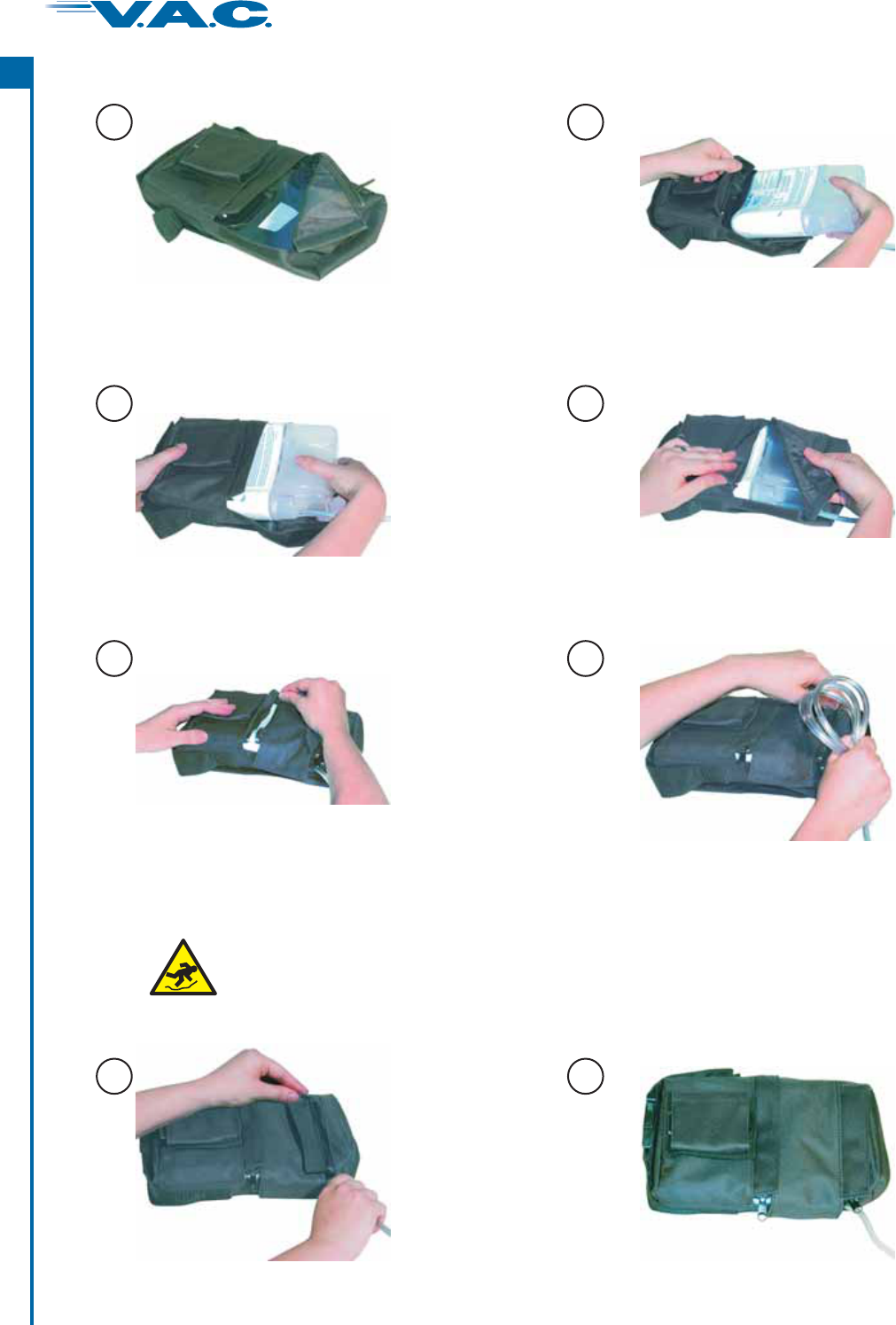
3
2
Start with the empty case.
Open the Center Zipper and Access Flap.
Continue to slide the unit into the case
until it fits.
Hold the case open, and with a canister attached
and the Touch Screen User Interface facing down,
slide the ActiV.A.C. Therapy Unit into the case.
®
After the ActiV.A.C. Therapy Unit is completely in the
case, fold the Access Flap over the therapy unit.
®
Inserting the Therapy Unit into the Carrying Case
5
Close the Center Zipper.
6
Wrap any excess tubing into a bundle. Put the tubing
into the Tubing Storage Pocket on the bottom of the
Carrying Case. Ensure there are no kinks or the tubing
is not pinched as it is put in the Tubing Storage Pocket.
7
Close Tubing Storage Pocket Zipper.
8
Finished position with zippers and flaps closed.
4
Excess tubing may present a tripping hazard. Ensure that excess tubing is
stored in the tubing pocket and is out of areas where people may walk.
1
20
®
A
c
t
I
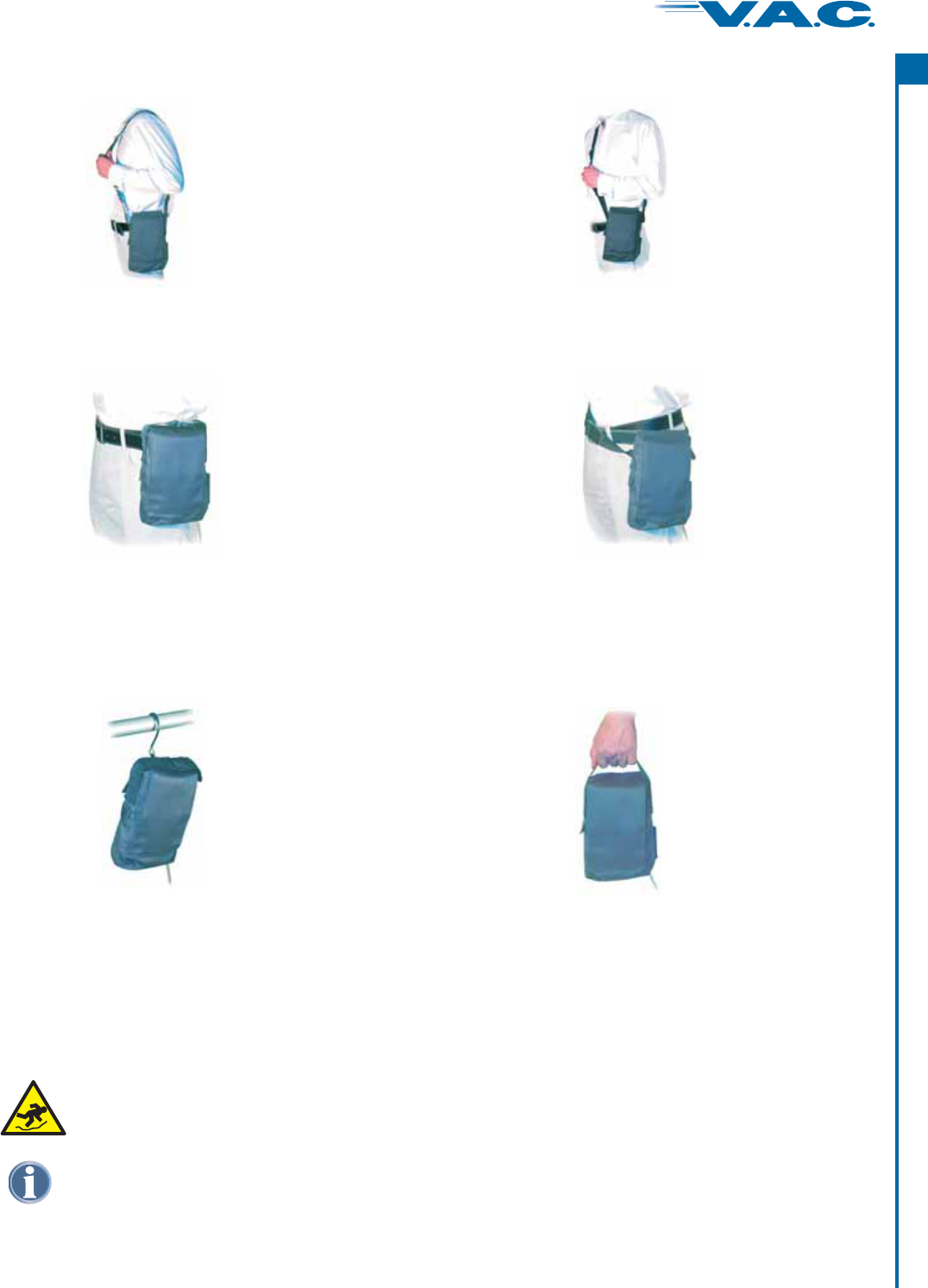
Carrying Case Configurations
The case can be worn over the
shoulder with the strap adjusted
for comfort.
The case can be worn over the
shoulder with the strap
adjusted for comfort.
opposite
A personal belt can be
Strap
threaded through
the Built-in Belt Loop on the back of the
case. The Shoulder should be
removed and the loose Buckles connected
over the top of the case.
The ActiV.A.C. Therapy Unit can be
carried in the hand by removing the
shoulder strap and connecting the
loose Buckles over the top of the case.
®
The case
Multi-function H
has a built-in Multi-function
Hook located under a flap on the back
of the case. The case can be used with
the Shoulder Strap removed, the loose
Buckles connected over the top of the
case, and the ook over
the top of a chair or other secure location.
When worn or carried, therapy unit should always have the canister pointing down.
Ensure that the Buckles are properly snapped together.
Excess tubing may present a tripping hazard. Ensure that excess tubing is
stored in the tubing pocket and is out of areas where people may walk.
The attached Strap
threaded
through the Built-in Belt Loop on the
back of the case. he Buckles
connected over the top of
the case.
Shoulder can be
removed from the Buckles and
T loose
should be
21
®
A
c
t
I

®
A
c
t
I
On/Off
Therapy
Utilities
Clinician Mode
Jun 22 2006
15:38
Continuous
0 mmHg
Therapy Off
Clinician Mode Home screen
Clinician Mode
Therapy On/Off
Button
Help Button
Screen Guard
This “plug” indicator
while plugged
into .
appears
a wall outlet
Battery Level Indicator
This icon rotates when the
ActiV.A.C. Therapy Unit is
applying negative pressure.
®
Therapy Status
Bar and Display
Area.
Mode Indicator
Current Date
Current Time
Screen Guard is not a patient lock-out feature.
Common Screen Control Buttons
accesses screens when available.Help
activates the feature .Screen Guard to help prevent unintentional changes This
feature should be used when cleaning the Touch Screen User Interface.
To release Screen Guard, press ‘1’ and then ‘2’.
On/Off
starts or stops V.A.C. Therapy.
®
Most screens have one or more common control buttons. These are:
Utilities
accesses ‘Region Settings’ and ‘Time/Date’ , ‘Screen
Brightness’ and ‘AC Light’ buttons.
access buttons
Therapy
accesses ‘Settings’, ‘Seal Check™’ Tool, ‘Settings Guide’, and ‘History’ access
buttons.
A green lighted crescent
means the function is on.
An unlit crescent
means the function is off.
22
®
A
c
t
I
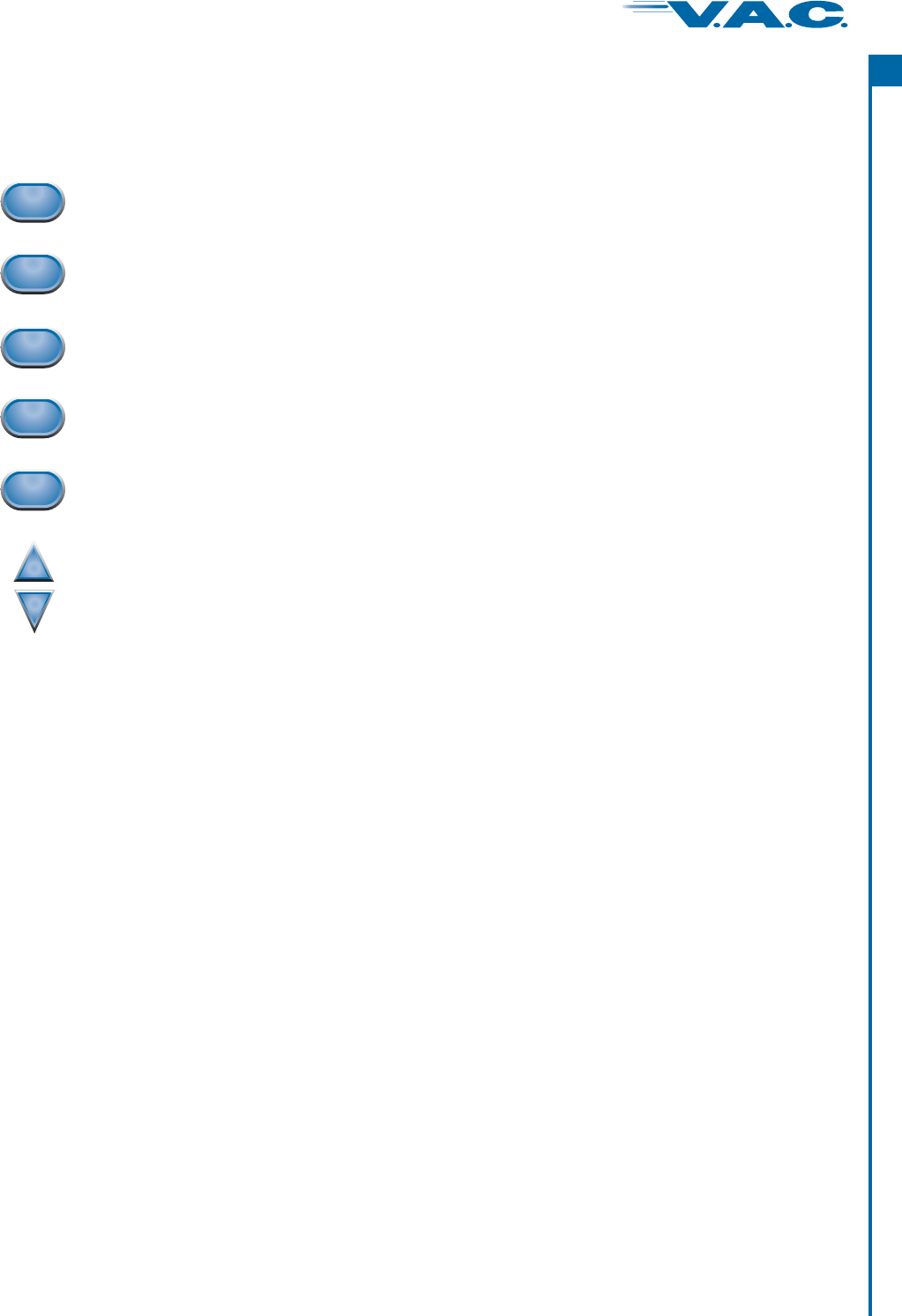
Clinician Mode (cont.)
One or more of these buttons may appear on a screen.
returns to the previous screen of that particular procedure.
Back
goes on to the next screen of that particular procedure.
Next
stops action in progress.
Cancel
leaves that particular screen.
Exit
Navigation Buttons
acknowledges the action is complete and displays the next screen.
OK
Holding these b will rapidly scroll through available selections.uttons
+
_
23
®
A
c
t
I
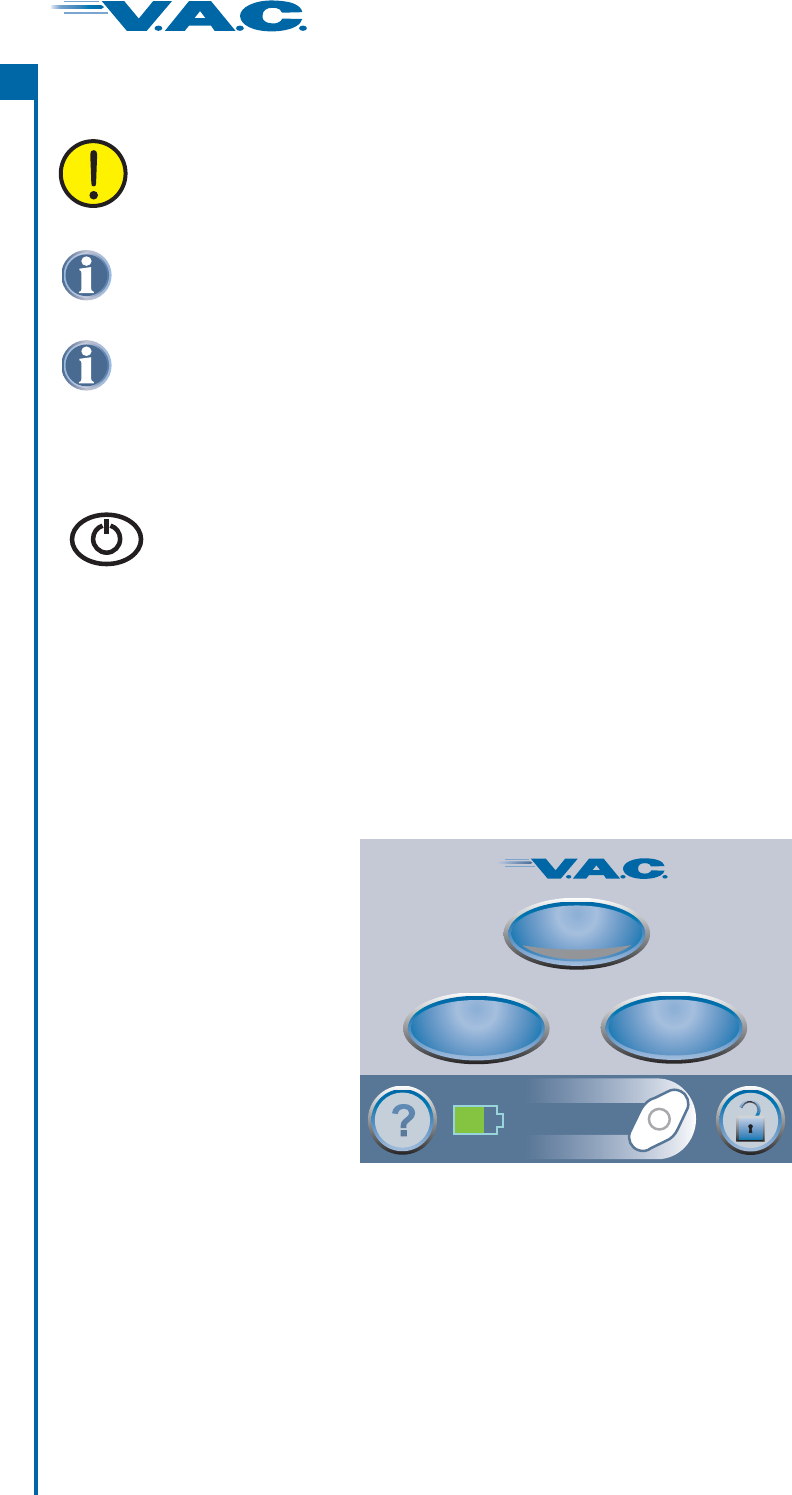
Clinician Operating Instructions
The ActiV.A.C. Therapy Unit should be delivered already set to the Clinician Mode.
®
The ActiV.A.C. Therapy Unit will return to the Patient Mode after about 15 minutes of
Touch Screen User Interface inactivity. Refer to Clinician Help Menu section of this manual
if necessary.
®
The ActiV.A.C. Therapy Unit will go through a self-check routine and then presents a ‘
’ screen. Press ‘ ’ to continue to this Clinician Mode Home screen (shown below).
®
Warning
Message OK
Power the ActiV.A.C. Therapy Unit On or Off
®
®
A
c
t
I
On/Off
Therapy
Utilities
Clinician Mode
Jun 22 2006
15:38
Continuous
0 mmHg
Therapy Off
Press and hold the button for approximately 2 seconds to turn the
ActiV.A.C. Therapy Unit On or Off.
Power On/Off
®
The Power On/Off button is located immediately below and to the left of the Touch
Screen User Interface.
CAUTION NOTICE TO PATIENTS:
This section contains specific information intended for clinicians ONLY. Do not
attempt to perform any applications or setting adjustments in this section without
the express direction and supervision of your treating physician.
24
®
A
c
t
I
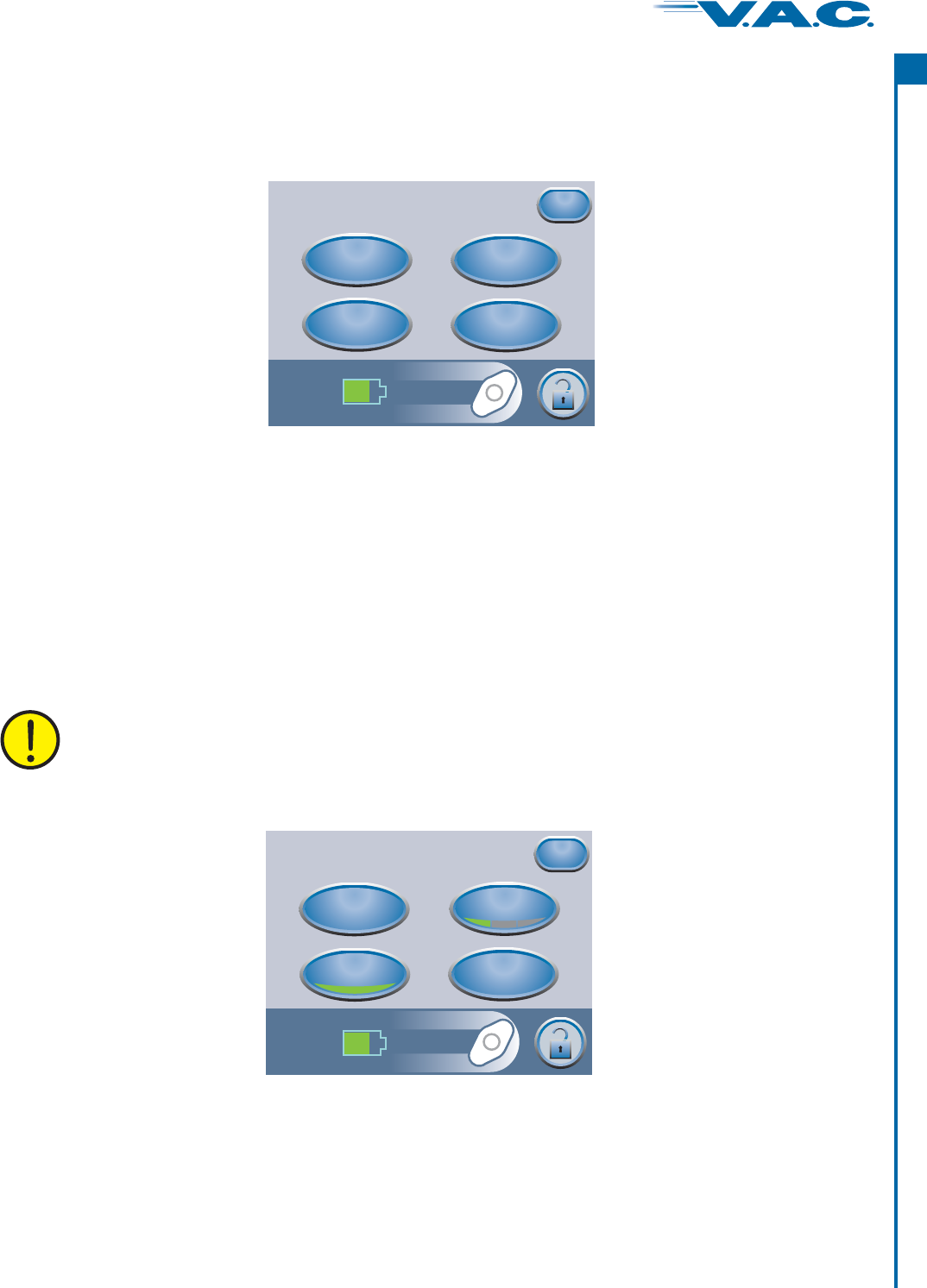
Therapy
From the ‘ ’ screen the clinician can access:Therapy
·
·
·
·
Settings
Seal Check™
Settings Guide
History
Exit
‘ ’ - Manually set therapy.
‘ ’ - Assists in finding leaks.
‘ ’ - Guide for preset therapy settings.
‘ ’ - View or export therapy history.
Press ‘ ’ to return to the Clinician Home screen.
Accessing Manual Therapy Settings
Therapy
Settings
Seal Check™
History
Exit
Settings
Guide
Settings
From the ‘ ’ screen the clinician can:Settings
Settings changed manually take immediate effect when therapy is on.
Settings
Pressure
Continuous
Intermittent
Exit
Intensity
·
·
·
·
Change settings.
Change .
Toggle between and therapy.
Set therapy times.
‘Pressure’
‘Intensity’
‘Continuous’ ‘Intermittent’
‘Intermittent’
From the Clinician Mode Home screen, press ‘ ’, then to access
the Settings screen.
Therapy then ‘ ’, ‘ ’Next Settings
From the Clinician Mode Home screen, press ‘ ’, then ‘ ’ to access the Therapy screen.Therapy Next
Press ‘ ’ when finished with the ‘Settings’ screen and go to the ‘Confirm’ screen.Exit
25
®
A
c
t
I
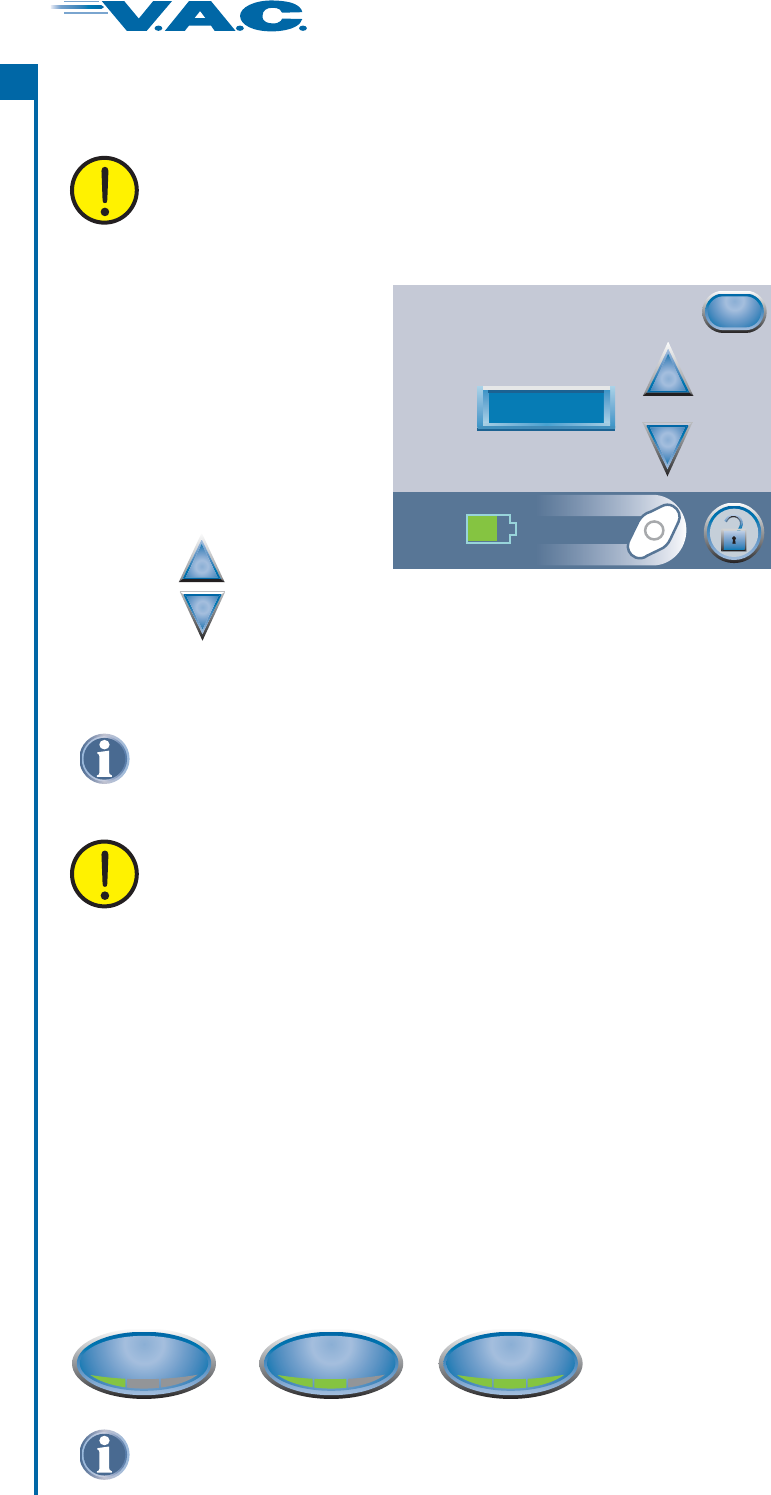
26
Intensity Control
·
·
·
·
Intensity is related to the time it takes to reach the target therapy level after the initiation of
therapy.
The lower the intensity setting, the slower the target therapy level will be reached.
It is recommended that new patients begin therapy at the lowest intensity setting as this
allows for slower increase of negative pressure once the foam is compressed in the
wound.
The intensity can remain at the minimum setting throughout the entire length of treatment, if
desired.
IntensityIntensity
Intensity
Low
Medium High
Press to change levels. Green crescent changes with each setting.
Default setting is: Low
From the Clinician Mode Home screen, press ‘ ’, then to access
th
Therapy then ‘ ’, ‘ ’
e Intensity button.
Next Settings
Settings changed manually take immediate effect when therapy is on.
Settings (cont.)
Pressure Settings
Exit
Pressure
125 mmHg
+
_
Press ‘ ’ to return to the ‘Settings’ screen.Exit
From the Clinician Mode Home screen, press ‘ ’, then
to access th
Therapy then ‘ ’, ‘ ’, then
e Pressure screen.
Next Settings
‘Pressure’
Settings changed manually take immediate effect when therapy is on.
Use the buttons to change to the desired pressure.
Pressure can be set from 25 to 200 mmHg in increments of 25 mmHg.
+
_
D setting is: 125 mmHgefault
26
®
A
c
t
I

27
Changing Intermittent time intervals will take effect next cycle.
From the Clinician Mode Home screen, press ‘ ’, then press
to access th
Therapy ‘ ’, then press
is screen.
Settings
‘Intermittent’
From the Clinician Mode Home screen, press ‘ ’, then ‘ ’, then ‘ ’ to access
this screen.
Therapy Next Settings
‘Continuous’ and ‘Intermittent’ Modes
When the Green Crescent is , the ActiV.A.C. Therapy Unit is in ‘ ’
mode.
lit
®
Continuous
Continuous
When the Green Crescent is , the is in ‘ ’
mode.
unlit IntermittentActiV.A.C. Therapy Unit
®
Continuous
Continuous
to switch between ‘ ’ and Therapy.Continuous ‘Intermittent’
Press
Settings (cont.)
Press ‘ ’ to return to the ‘Settings’ screen.Exit
Intermittent Settings
Exit
Intermittent
+
_
+
_
On Time
Minutes
On Time
Minutes
Off Time
Minutes
Off Time
Minutes
2
5
Settings
Pressure
Continuous
Intermittent
Exit
Intensity
The words
or will
appear in this area
as modes are switched.
Continuous
Intermittent
Use the buttons to change the desired On and Off Time (in minutes).
Both On and Off Times can be set from 1 minute to 10 minutes in 1 minute increments.
+
_
Default is: On Time = 5 minutes. Off Time = 2 minutes.setting
Default setting is: Continuous.
Press ‘ ’ when finished with the ‘Settings’ screen and go to the ‘Confirm’ screen.Exit
27
®
A
c
t
I
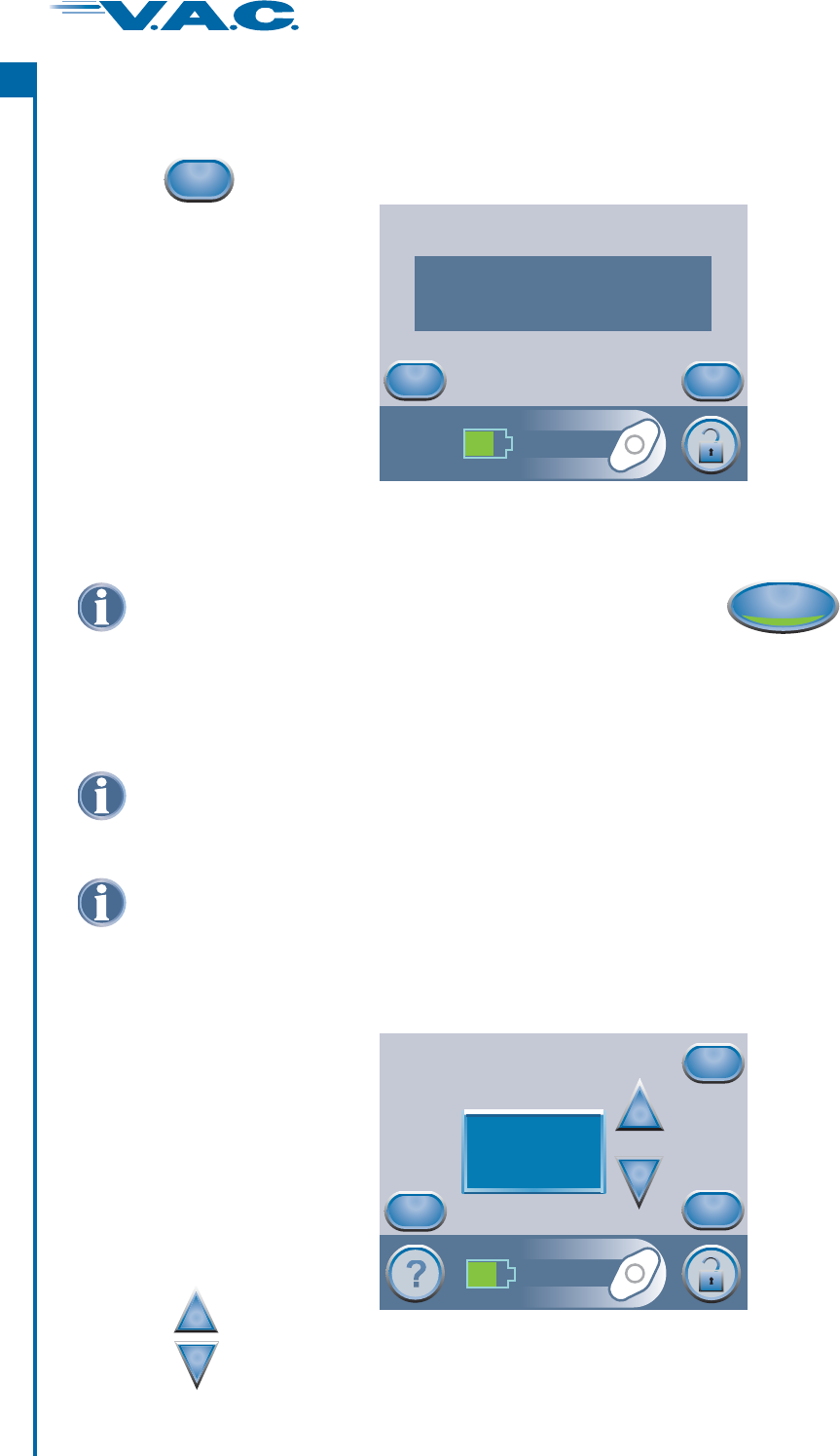
28
Settings Confirmation
If the displayed settings are as desired, press ‘ ’ to continue to the Clinician Mode Home
screen. Otherwise, press ‘ ’ to change any settings that are incorrect.
OK
Back
when finished with the ‘Settings’ screen leads to this ‘ ’ screen.Confirm
Pressing
Exit
Settings (cont.)
Confirm
Back
OK
Pressure: 125mmHg
Mode: Continuous
Intensity: Low
Settings Guide
From the Clinician Mode Home screen, press ‘ ’, then ‘ ’, thenTherapy Next ‘ ’, and
then ‘ ’ to access this screen.
Settings Guide
OK
Press when finished with this screen.‘Next’
Use the buttons to select from the available wound type selections.
+
_
Select Wound
Cancel
Next
Back
+
_
Partial Thickness
Burns
If settings were changed with V.A.C. Therapy off, press to start therapy.
®
On/Off
Should physician orders fall outside the pre-set therapy ranges, select ‘ ’ in this
mode or use Manual Therapy Settings detailed earlier in the Clinician section of this
manual.
Other
The Settings Guide tool helps the clinician select from pre-set therapy ranges according
to wound type and treating physician’s orders. Selected ranges are a guide based on
common settings for different wound types. Individual patient conditions may vary.
Consult physician to verify settings for each patient.
®
A
c
t
I
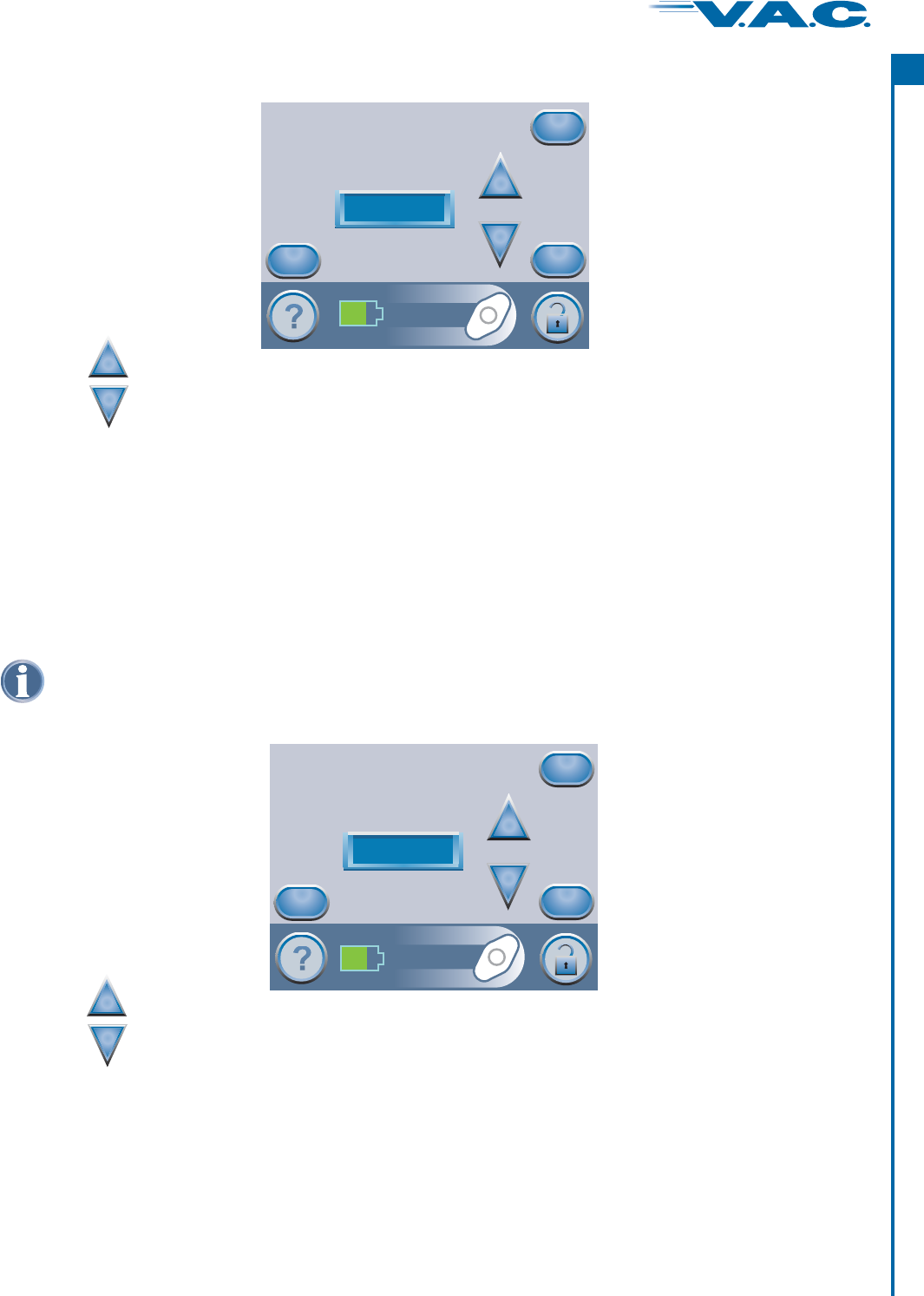
29
Pressure selections are in ranges for the wound type selected on the previous screen.
Settings Guide (cont.)
Press when finished with this screen.‘Next’
For wound types for which ‘Intermittent’ is an option, this ‘ ’ screen will
appear.
If ‘Intermittent’ is not an option, the ‘Confirm’ screen will appear (see next page).
Select Mode
Press when finished with this screen.‘Next’
Use the buttons to select from the available pressure selections.
+
_
Use the buttons to choose ‘ ’ or ‘ ’ Therapy.Continuous Intermittent
+
_
Select Mode
Intermittent
+
_
Cancel
Back
Next
Select Pressure
125 mmHg
+
_
Cancel
Back
Next
®
A
c
t
I
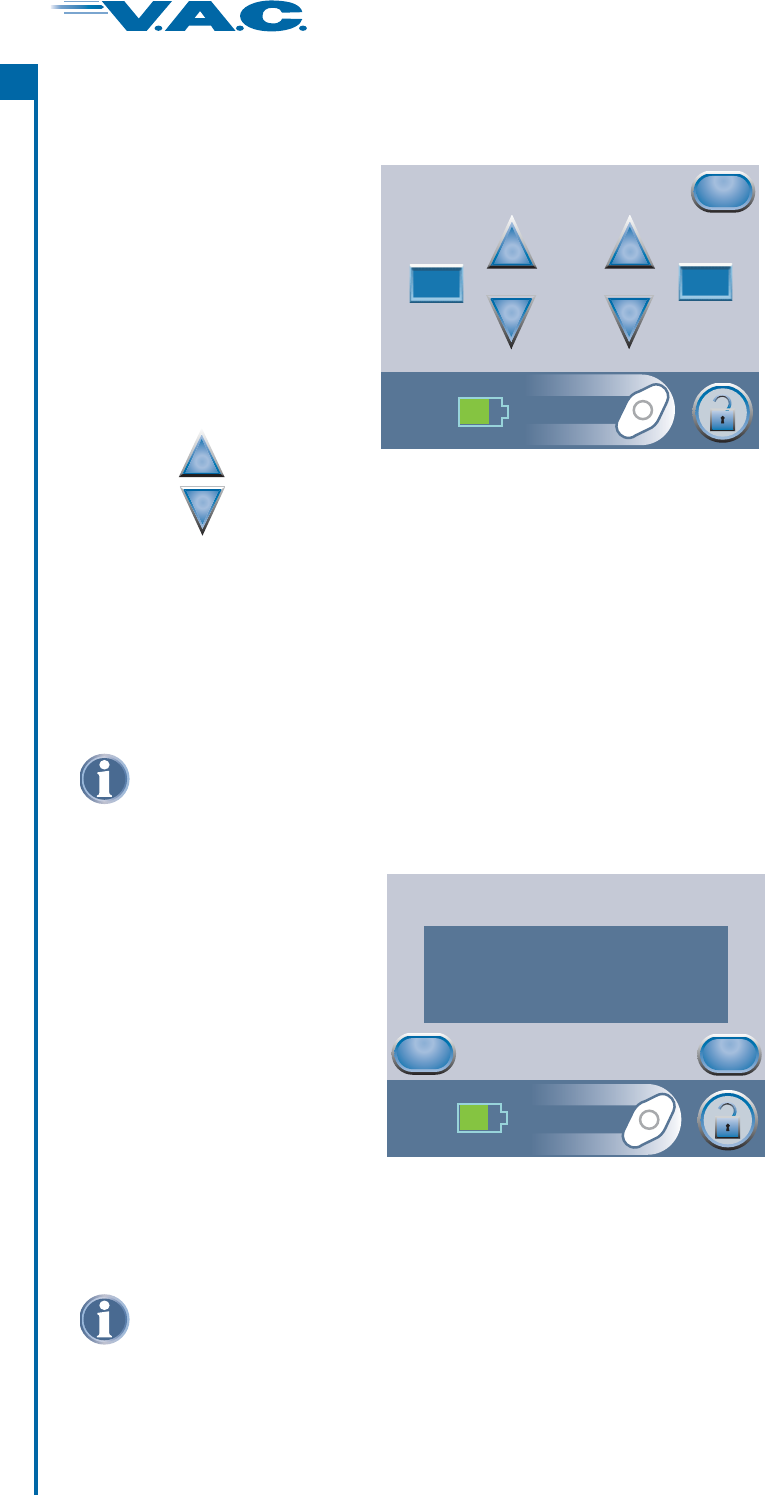
If ‘Intermittent’ Therapy was chosen on the previous screen, this ‘ ’ screen will appear.Intermittent
Press when finished with this screen.‘Exit’
Settings Guide (cont.)
Confirm
Back
OK
Partial Thickness Burns
Pressure: 125 mmHg
Mode: Intermittent
Intensity: Low
Settings Guide Confirmation
Once the settings are chosen, this ‘ ’ screen will appear.Confirm
Exit
Intermittent
+
_
+
_
On Time
Minutes
On Time
Minutes
Off Time
Minutes
Off Time
Minutes
2
5
Settings take effect after ‘ ’ is pressed.OK
Settings Guide Intensity default is low. Intensity can only be changed using the Manual
Therapy Settings.
Use the buttons to change the desired On and Off Time (in minutes).
Both On and Off Times can be set from 1 minute to 10 minutes in 1 minute increments.
+
_
If the displayed settings are as desired, press ‘ ’ to continue to the Clinician Mode Home
screen. Otherwise, press ‘ ’ to change any settings that are incorrect.
OK
Back
®
A
c
t
I
30
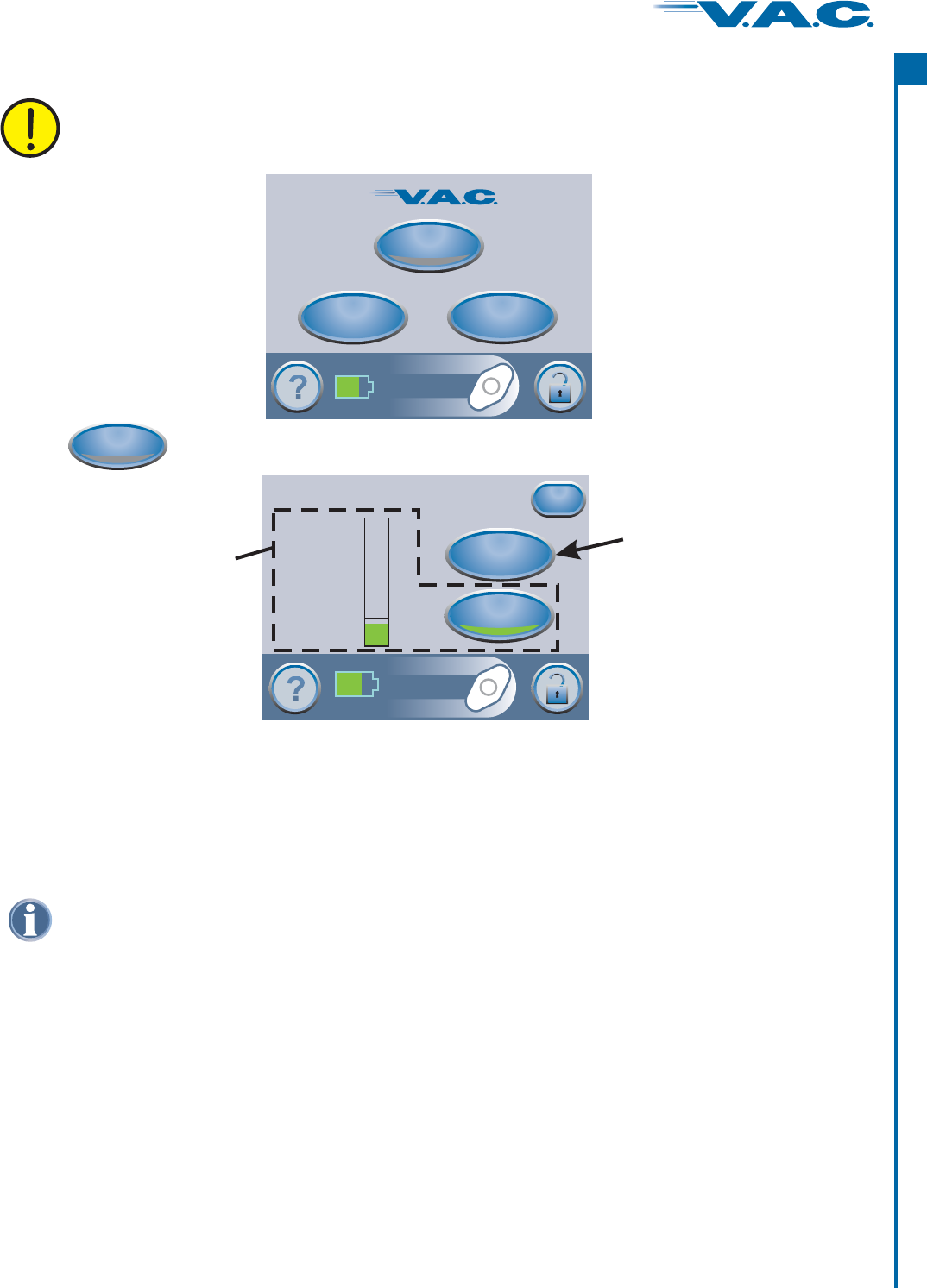
16
On/Off
to start therapy .and this ‘ ’ screen will appearTherapy StartPress
Starting Therapy
®
A
c
t
I
On/Off
Therapy
Utilities
Clinician Mode
Jun 22 2006
15:38
Continuous
0 mmHg
Therapy Off
Seal Check Overview
™
Patients only have access to the Seal Check Tool through the ‘ ’ screen
when the ActiV.A.C. Therapy Unit detects a possible leak.
™
Leak Alarm
®
·
·
·
Seal Check
Seal Check
Seal Check
™
™
™
is used to help find air leaks.
features an audible tone that speeds up or slows down as the leakage rate
changes. Pressing the Seal Audio button will switch between the audible tone being On or
Off.
also features a real time bar graph that gives a visual indication of the
leakage rate.
The Tool appears three (3) different ways:
3. the ‘Leak Alarm’ screen after
Seal Check
™
™
™ ®
1. When therapy is started from the Clinician Mode Home screen, discussed on the following
pages.
2. When the button is pressed from the ‘Therapy’ screen.
When the button is pressed on the ActiV.A.C.
Therapy Unit detects a possible leak.
Seal Check
Seal Check
From this screen the clinician can use the Tool to view the integrity of the V.A.C.
Dressing. The clinician can also use the Tool to record a canister change or the number of
foam pieces used during a dressing change.
‘Seal Check ’
‘Log’
™ ®
Therapy Start
About
Exit
Log
Leak Rate
Low
High
Seal Audio
Seal Check Tool
™
Log Tool
WARNING: Ensure that a new V.A.C. Dressing was applied and therapy settings
have been selected per physician’s orders before starting therapy.
®
®
A
c
t
I
31

How to Use Seal Check™ (When Starting Therapy)
Finding the Leak Using Seal Check
™
Starting Therapy (cont.)
Most leaks occur:
where the drape meets the skin.
where the SensaT.R.A.C. Pad is attached to the drape.
at tubing connections.
·
·
·
®
1. Ensure connector between dressing tubing and canister tubing is properly locked.
2. Ensure the canister is securely installed on the therapy unit. If the canister is properly installed, the
canister cannot be removed by gently pulling the canister directly away from the unit
3. While therapy is on and using light pressure, move your hand and fingers slowly around the edges
of the drape and the SensaT.R.A.C. Pad. The bar graph will lower and the audible tone (if
is on) will slow down when the leak is found.
4. Refer to the provided with V.A.C. Dressings for information on using
excess V.A.C. Drape material to seal the leak area.
®
®
®
Seal
Audio
Application Instructions
When finished with this screen, press ‘ ’ to return to the Clinician Mode Home screen.Exit
Therapy Start
About
Exit
Leak Rate
Low
High
Seal Audio
Log
Orange bar graph
indicates a significant leak.
Green bar graph indicates
that the ActiV.A.C.
Therapy System is
operating normally.
®
Press to turn the Seal Audio
tone On or Off.
The feature provides an audible tone and a bar graph to assist in finding leaks.
The frequency of the audible tone and the height of the bar graph will reflect the leak rate.
The audible tone slows down and the bar graph decreases in height as the leak is found.
Seal Check
™
·
·
During initial dressing draw down, the bar graph should turn orange and then return to a
green state if there are no significant leaks.
Seal Check™ Tool
Line on bar graph is the
transition point from green to
orange and vice-versa.
Pressing located on the Clinician Mode Home screen will immediately display
this ‘ ’ screen.Therapy Start
On/Off
®
A
c
t
I
32
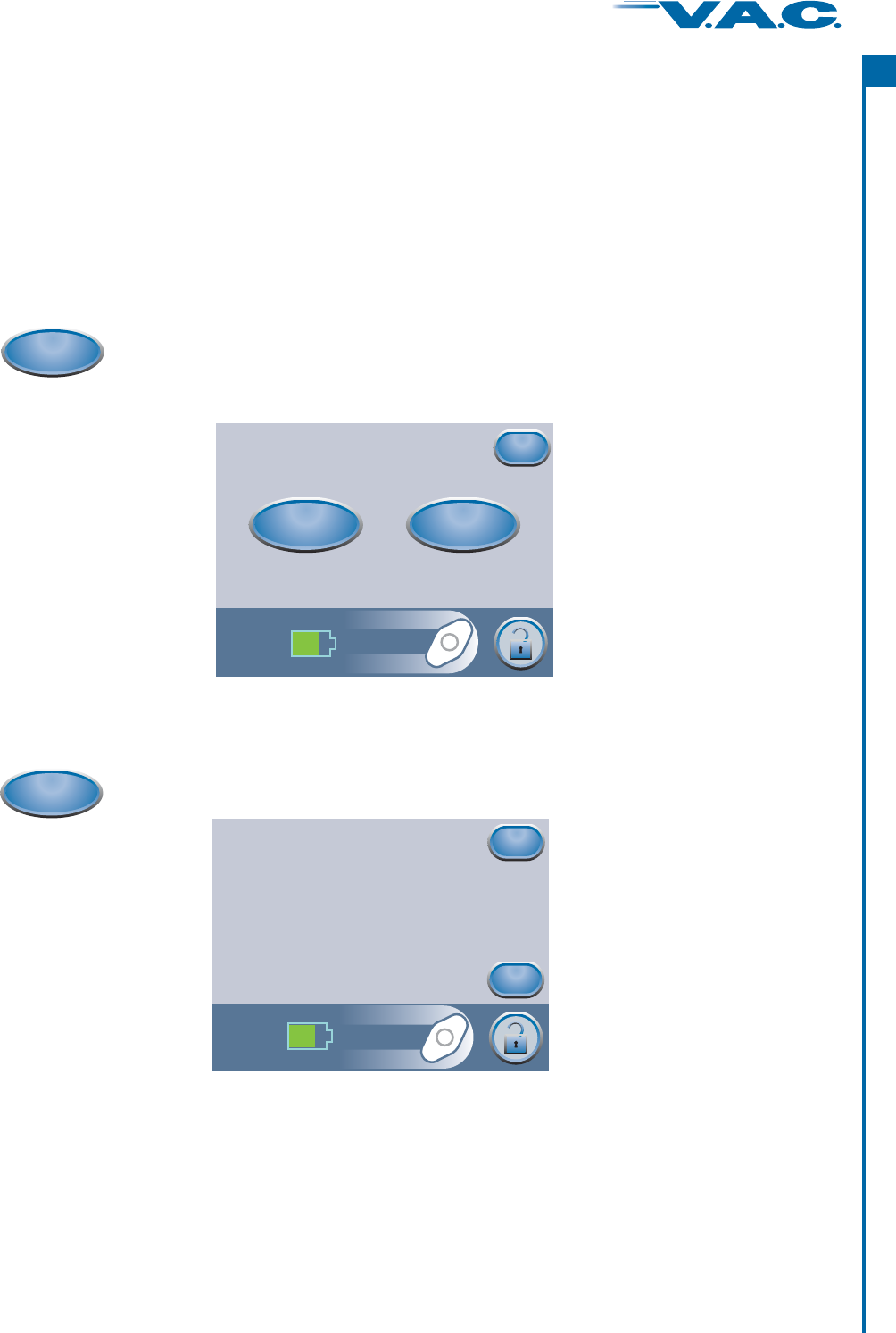
Log Tool Overview
·
·
·
Log Tool can be used to record the number of foam pieces used during a dressing change.
Log Tool can be used to record canister changes.
Logged information is viewable and exportable on the Therapy History screens.
Starting Therapy (cont.)
How to Use Log Tool (When Starting Therapy)
Press ‘ ’ to return to the Clinician Mode Home screen.Exit
Item to Log
For Dressing, also note the No. of foam
pieces in patient chart and on the drape.
Dressing
Canister
Exit
Choose ‘ ’ or ‘ ’.Canister Dressing
Log
on the screen to accessTherapy Start‘ ’ this ‘ ’ screen.Item to LogPress
Press ‘ ’ to log that the canister has been replaced and return to the ‘Item to Log’ screen.
The current time and date will be recorded.
Press ‘ ’ to return to the ‘Item to Log’ screen without logging an entry.
OK
Cancel
Canister
to access this ‘ ’ screen.Canister ReplacedPress
Canister Replaced
Press OK to log that the
canister has been changed
(Will use the current time and date)
OK
Cancel
®
A
c
t
I
33
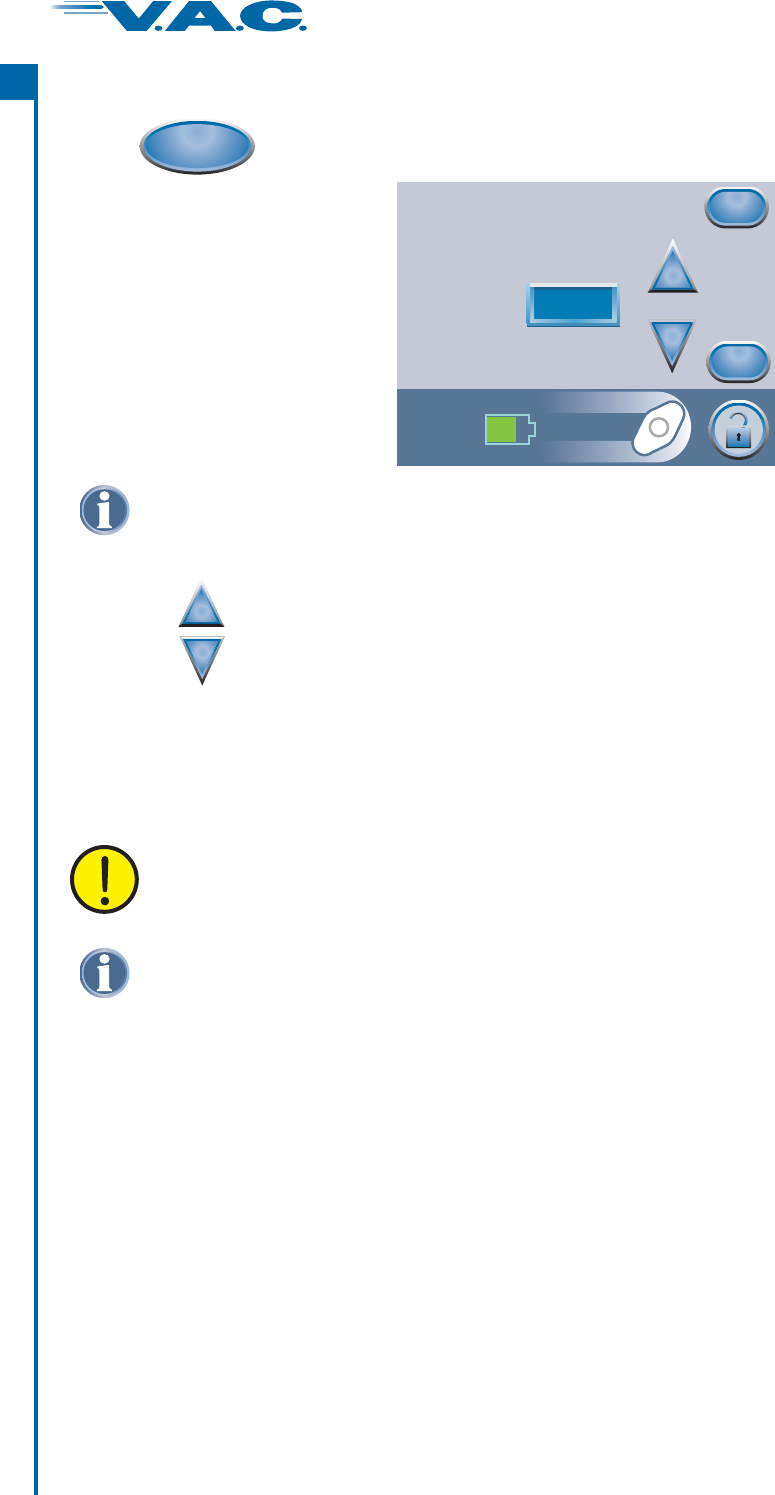
Always document the number of foam pieces used in patient chart and on the
V.A.C. Drape.
®
Information displayed represents the last logged entry.
Dressing
to access this ‘ ’ screen.Foam PiecesPress
Use the buttons to change the number of pieces of foam used during the current
dressing change.
+
_
OK
Foam Pieces
Press OK to log number of
foam pieces and time/date
Last recorded
on 15:55 12/06/06
4
+
_
Cancel
Starting Therapy (cont.)
Logged information will appear in Therapy History as follows:
Where the numeral after “Dressing Changed” is the number of foam pieces recorded on
the above screen.
12/06/06 15:54 Canister Changed
12/06/06 15:55 Dressing Changed, 4
dd/mm/yy Time Event
Press ‘ ’ to log the number of foam pieces used and return to the ‘Item to Log’ screen. The
current time and date will be recorded.
Press ‘ ’ to return to the ‘Item to Log’ screen without logging an entry.
OK
Cancel
®
A
c
t
I
34
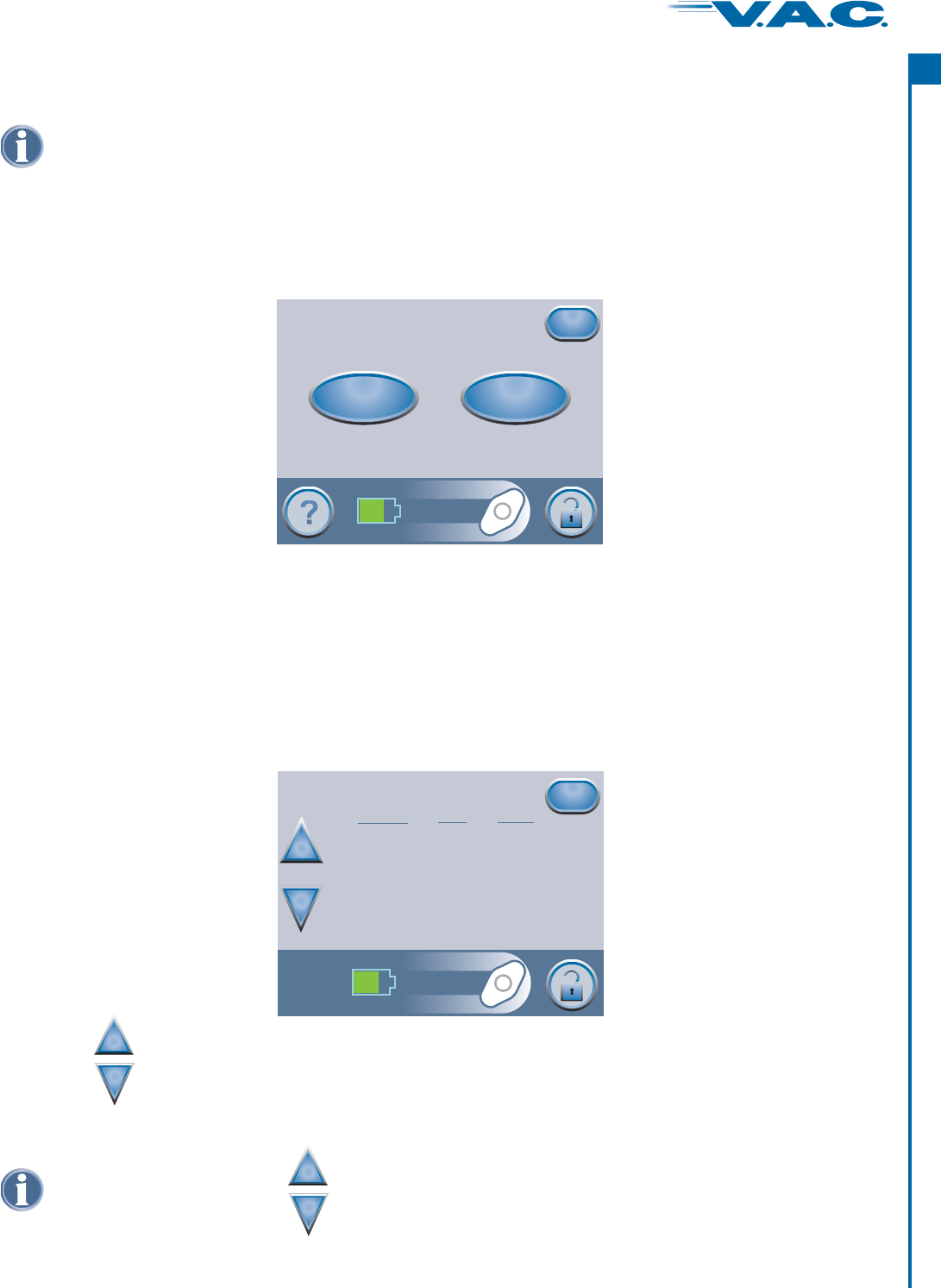
View or Export Therapy History
Starting from the Clinician Mode Home screen, press ‘ ’, then then ‘ ’ to
access this screen.
Therapy ‘Next’ History
The screen has two options:
View Therapy History on screen.
‘Therapy History’
‘View History’:·
· Export History’:‘ Access to screens where the Therapy History Report can be transferred
via USB or IR (Infrared).
Therapy History
Export History
View History
Exit
View Therapy History
Press the ‘ ’ button on the screen to access this on-screen
therapy history display.
View History ‘Therapy History’
Press ‘ ’ to return to the ‘ ’ screen.Exit Therapy History
Use the buttons to scroll through the Therapy History Report.
+
_
Holding these b will rapidly scroll through the Therapy History Report.uttons
+
_
History
+
_
Exit
dd/mm/yy Time Event
12/06/06 15:48 Unit On
12/06/06
12/06/06
12/06/06 15:55 Dressing Changed, 4
12/06/06 22:23
12/06/06 22:23 Therapy Off
12/06/06 22:27 Therapy On
12/06/06 22:29
15:48 Therapy On
15:54 Canister Changed
Canister Full
Auto Therapy Off Leak
12/06/06 22:32 Therapy On
Therapy History is a chronological log with dates and times for therapy starts/stops,
therapy settings, alarm occurrences, and canister/dressing changes. Data can be
reviewed on-screen or transferred from the ActiV.A.C. Therapy Unit electronically in the
form of a Therapy History Report.
®
®
A
c
t
I
35
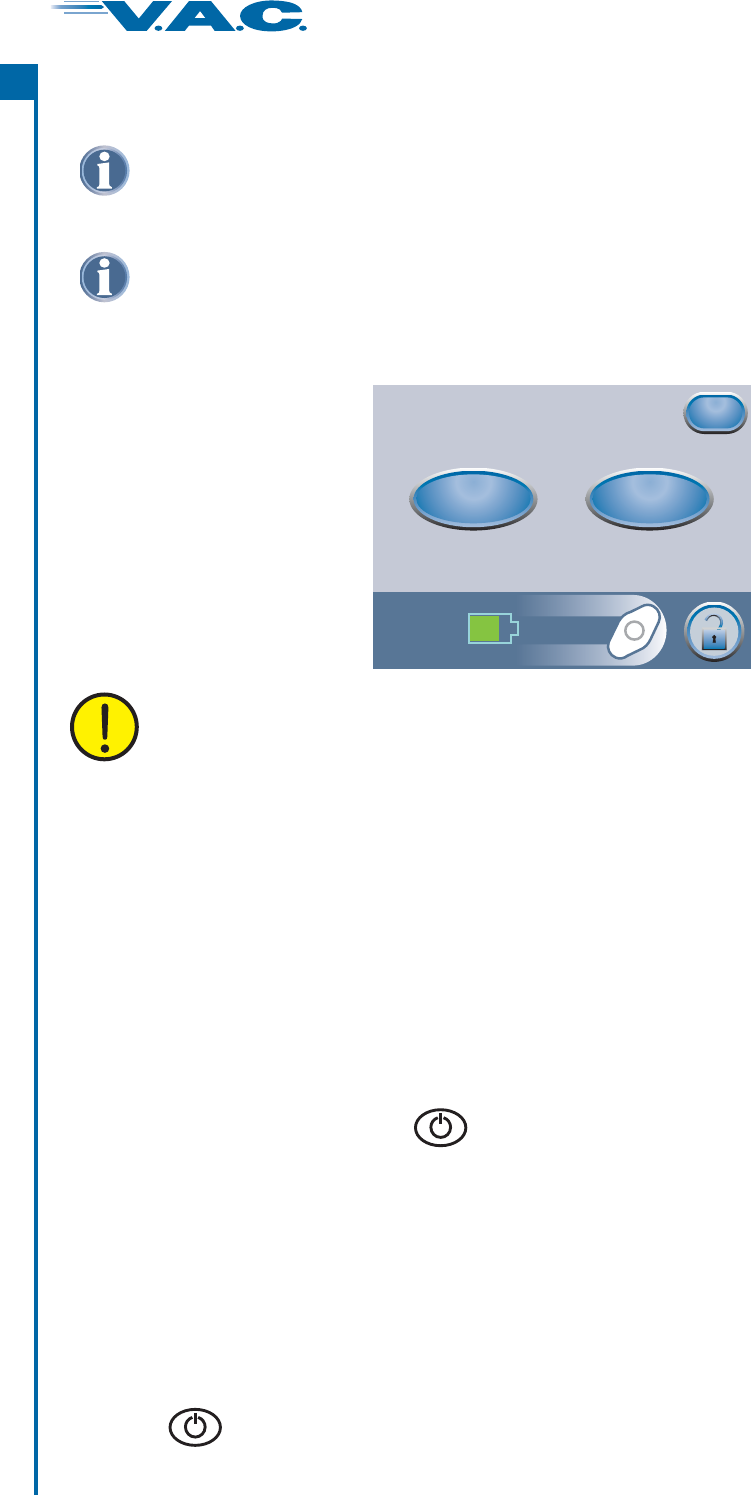
Export Therapy History Report
Press ‘ ’ to use USB transfer. Follow screen directions.
Press ‘ ’ to use IR (Infrared) transfer. Follow screen directions.
Export to USB
Export to IR
Export History
Data is exported with unit serial number,
but without patient identifier.
Export to IR
Export to USB
Exit
Press the ‘ ’ button on the screen to access this screen.Export History ‘Therapy History’
Press ‘ ’ to return to the screen.Exit ‘Therapy History’
Troubleshooting USB or Infrared Export Problems
The USB Data Port is to be used with non-powered memory sticks and drives only. No AC
or battery powered drives, computers, computer equipment, or other devices may be
used.
USB:
Infrared:
·
·
·
·
·
·
·
·
·
·
Ensure that the USB flash drive (memory stick) being used is USB 2.0 compatible.
Ensure that the flash drive is fully plugged into the therapy unit. It may be necessary to unplug and
re-plug the flash drive into the therapy unit.
Try using a different USB flash drive.
Remove the flash drive. Press to power the unit off and then on. Retry exporting Therapy
History.
If the above steps do not resolve the problem, contact KCI. See back cover of this User Manual for
country specific contact information.
Ensure that the Infrared Data Port on the receiving device is turned on and is in the receiving mode.
Ensure that the two Infrared Data Ports are properly aligned (pointed directly at each other) and are
within 1 meter (3 feet) of each other.
Ensure that the lenses of the Infrared Data Ports are clean, not significantly scratched or damaged.
Press to power the unit off and then on. Retry exporting Therapy History.
If the above steps do not resolve the problem, contact KCI. See back cover of this User Manual for
country specific contact information.
NOTICE: This data is protected by copyright law and is likely to be confidential. It is intended
only for use by or for KCI or clinicians using KCI products. This data is not directly associated
with a particular patient. Since this data can be altered if transferred to a different media, the
data may only be considered original when downloaded directly from the ActiV.A.C. unit.
®
To access the USB or Infrared Data Ports, the ActiV.A.C. Therapy Unit must be removed from
the Carrying Case.
®
36
®
A
c
t
I
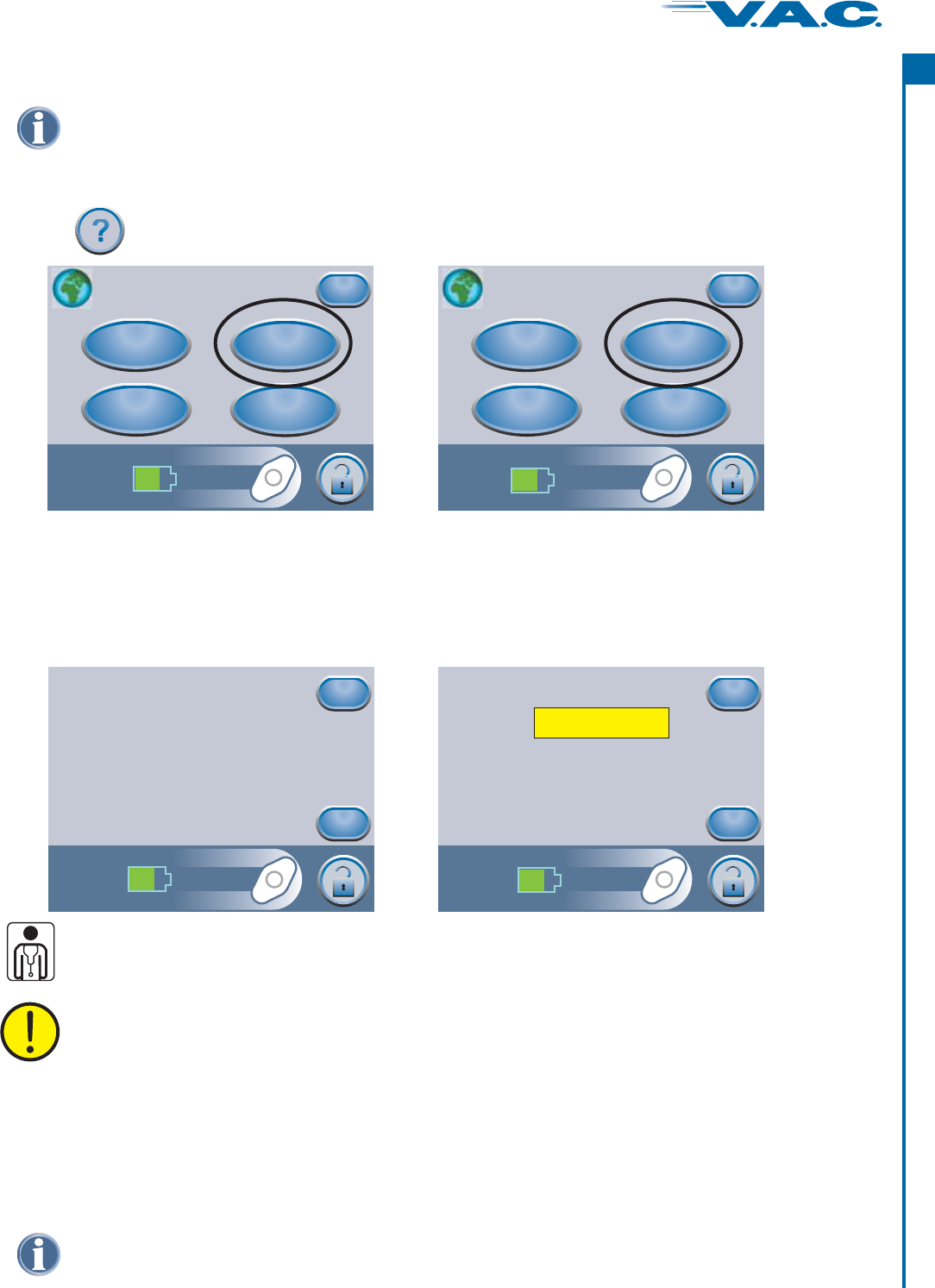
To access the Clinician Help Menu, the unit must be in Clinician Mode.
Changing to Patient or Clinician Mode
Press ‘ ’ to go to ‘Patient Mode’. Press to go to ‘Clinician Mode’.Patient Mode ‘Clinician Mode’
One of these confirmation screens will appear, depending on which mode is being accessed.
Press ‘ ’ to proceed to ‘ ’ Press and hold for at least 5 seconds to
proceed to
OK Patient Mode . ‘OK’
‘Clinician Mode’.
Help Menu
Operating
Instructions
Contact
Information
About
Exit
Patient
Mode
Press
to access the ‘ ’.Help Menu
Clinician Help Menu
Press to return to the respective screen.‘Cancel’ Help Menu
Help Menu
Operating
Instructions
Contact
Information
About
Exit
Clinician
Mode
Only authorized caregivers should access Clinician Mode. Select Cancel unless
authorized.
WARNING: Patients should not attempt to perform a change of settings and/or
therapy application without the express permission of the treating physician
and/or under the supervision of a trained clinical caregiver.
Patient Mode
Press OK to change the
system to Patient Mode
Cancel
OK
Clinician Mode
For safe and effective therapy, only
authorized caregivers should continue.
Select CANCEL unless authorized.
Cancel
OK
STOP
How to access On-screen Operating Instructions and Changing Languages are in the
Help Menu section of this manual.
37
®
A
c
t
I
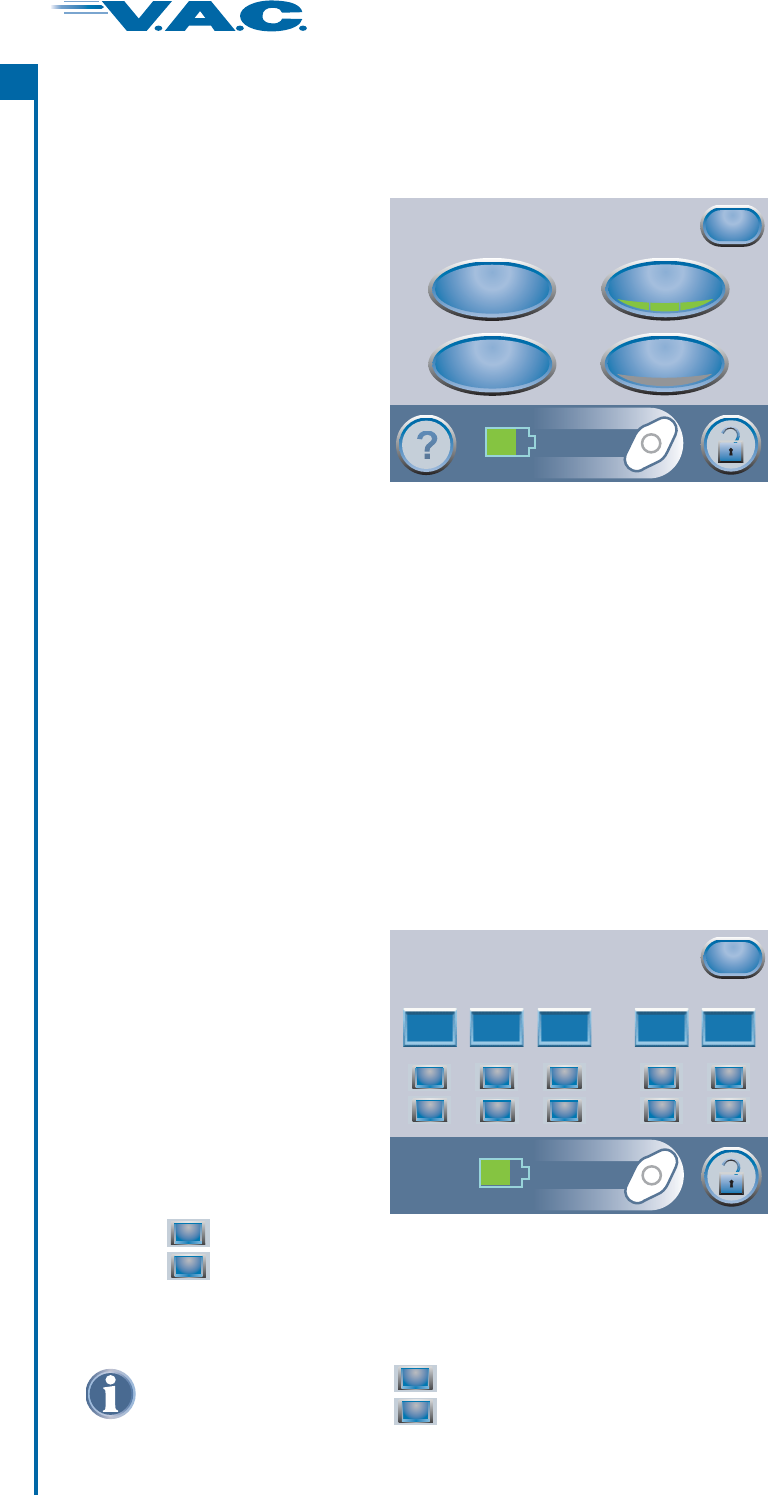
From the Clinician Mode Home screen, press ‘ ’ to access this screen.Utilities
Clinician Utilities
From this ‘ ’ screen the clinician can
Select to set the ‘Time/Date’ to current time and calendar date
Turn the ‘ ’ On and Off.
Utilities :
‘Time/Date’ .
AC Light
·
·
·
Select ‘ ’ to set the displayed ‘ ’ and set the ‘ ’.
Set the display ‘ ’ of the Touch Screen User Interface.
Region Settings Pressure Unit Date Format
Brightness·
Utilities
Time/Date
Region
Settings
AC Light
Exit
Brightness
From the Clinician Mode Home screen, press then press ‘ ’ to access this
screen.
‘Utilities’ Time/Date
Changing Time and Date
Press ‘ ’ to return to the screen.Exit ‘Utilities’
Use the buttons to set current time and calendar date.
+
-
+
-
Set Time/Date
Year
Month Day
Hour(24)
Minute
Exit
+
+
+
+
+
-
--
-
-
Holding these b will rapidly scroll through available selections.uttons
Press ‘ ’ to return to the Clinician Home screen.Exit
38
®
A
c
t
I
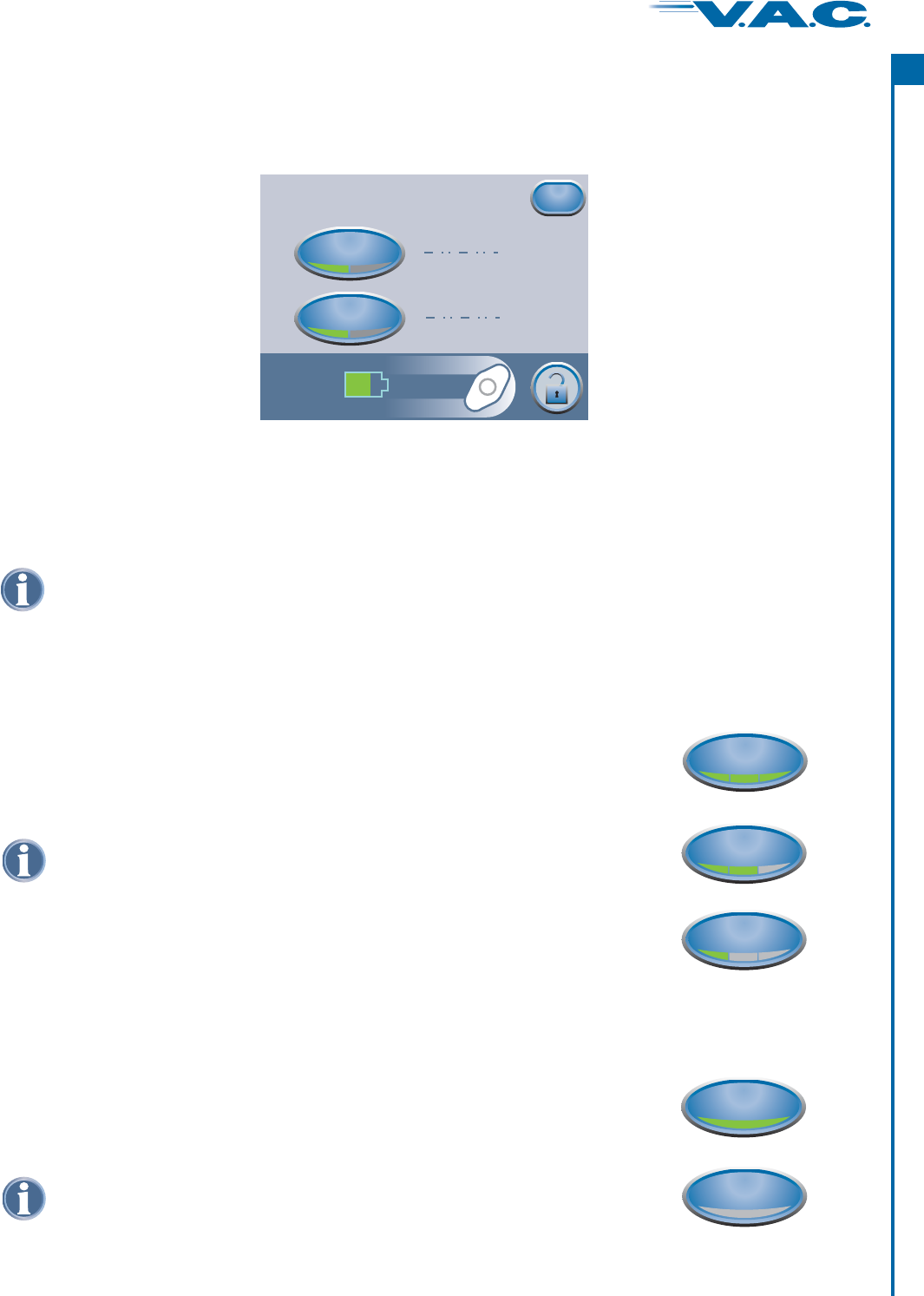
Press ‘ ’ to return to the screen.Exit ‘Utilities’
Changing Screen Brightness
Changing AC Light
AC Light
AC Light
Brightness
Brightness
Brightness
Pressing ‘ ’ switches between three levels of display screen
brightness.
Brightness
Pressing ‘ ’ prevents the display backlight from dimming when
the unit is properly connected to the ActiV.A.C. Power Supply.
AC Light
®
D setting is: Onefault
From the Clinician Mode Home screen, ‘ ’Region Settingspress then press to access
this screen.
‘Utilities’
Clinician Utilities (cont.)
Changing Pressure Units and Date Format
Pressing ‘ ’ switches between (millimeters of Mercury) and kPa (kilo-
Pascals) units of measurement.
Pressing ‘ ’ switches between displaying DD MM YY (Day-Month-Year) and MM
DD YY (Month-Day-Year) formats.
Pressure Unit
Date Format
mmHg
Regional Settings
Pressure Unit
Date Format
Exit
kPa
DD MM YY
MM DD YY
mmHg
D settings are: mmHg and MM DD YYefault
D setting is: Highefault
High
Medium
Low
On
Off
39
®
A
c
t
I
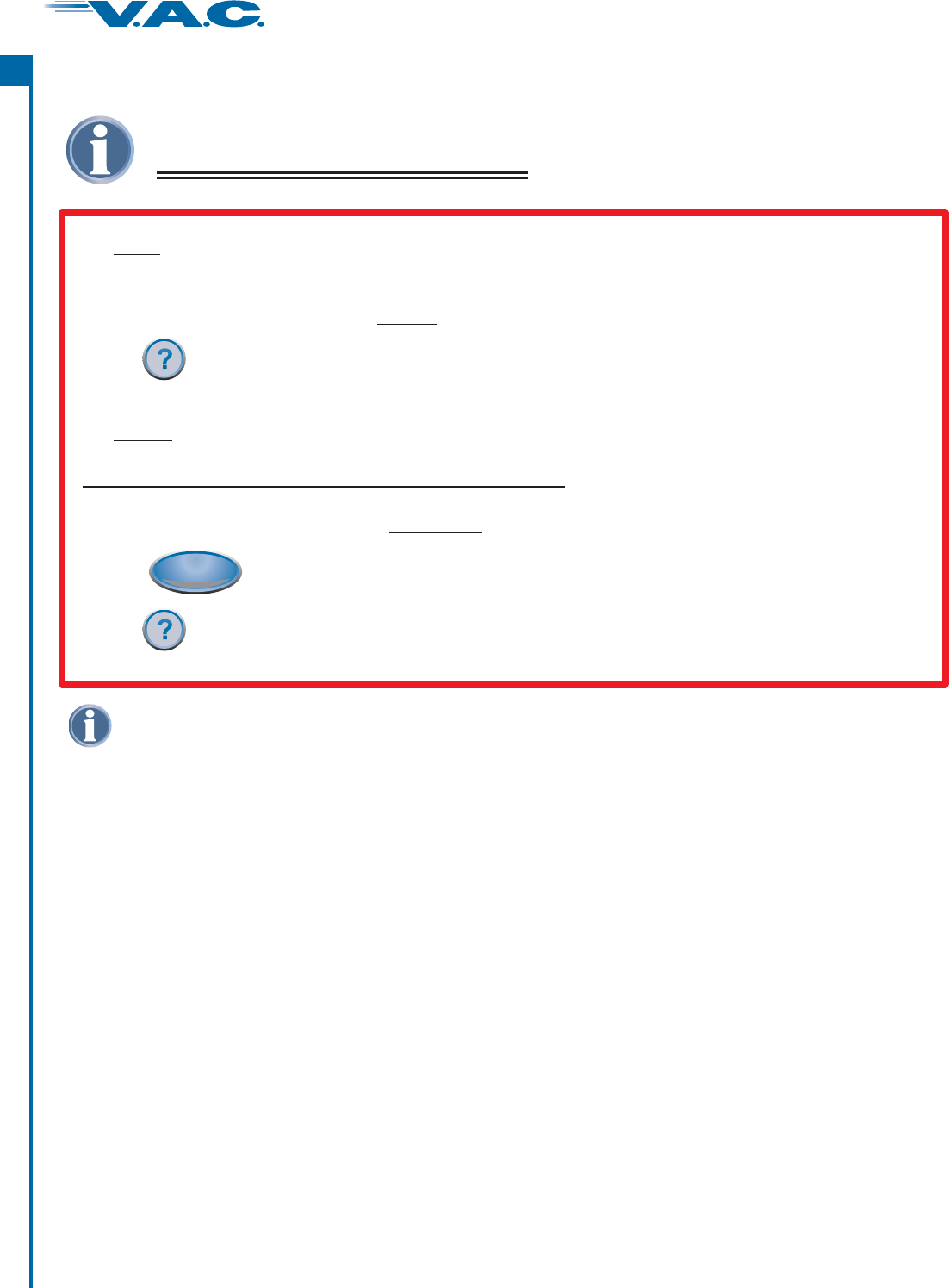
Alerts and Alarms
Battery Low Alert ......................41
Battery Critical Alarm.....................41
Canister Full Therapy Interrupted Alarm ...............42
Canister Not Engaged Alarm ..................43
Leak Alarm .......................44
Seal Check™ ......................44
Leak Alarm Therapy Interrupted .................45
Blockage Alert ......................46
Blockage Alarm Therapy Interrupted ................46
Low Pressure Alert .....................47
Low Pressure Alarm Therapy Interrupted ...............47
Therapy Inactive Alarm ....................48
System Error Therapy Interrupted Alarm ...............48
Service Timer Expired Alert ...................49
An will be displayed on the Touch Screen User Interface when the ActiV.A.C. Therapy
Unit detects a condition that requires patient or caregiver attention.
Alerts will be accompanied by a audible tone.
Press for more information.
An will be displayed on the Touch Screen User Interface when the ActiV.A.C. Therapy
Unit detects a condition that
Alarms will be accompanied by a audible tone.
Press to silence the audible tone for 2 minutes.
Press for more information.
Alert
Alarm
®
®
single
requires immediate patient or caregiver attention in order to
ensure the prescribed therapy is being delivered.
repeating
Audio Pause
If alarm conditions cannot be resolved, contact KCI. See back cover of this
User Manual for country specific contact information.
Index of Alerts and Alarms
ATTENTION:
Important Information
about Alerts and Alarms
40
®
A
c
t
I
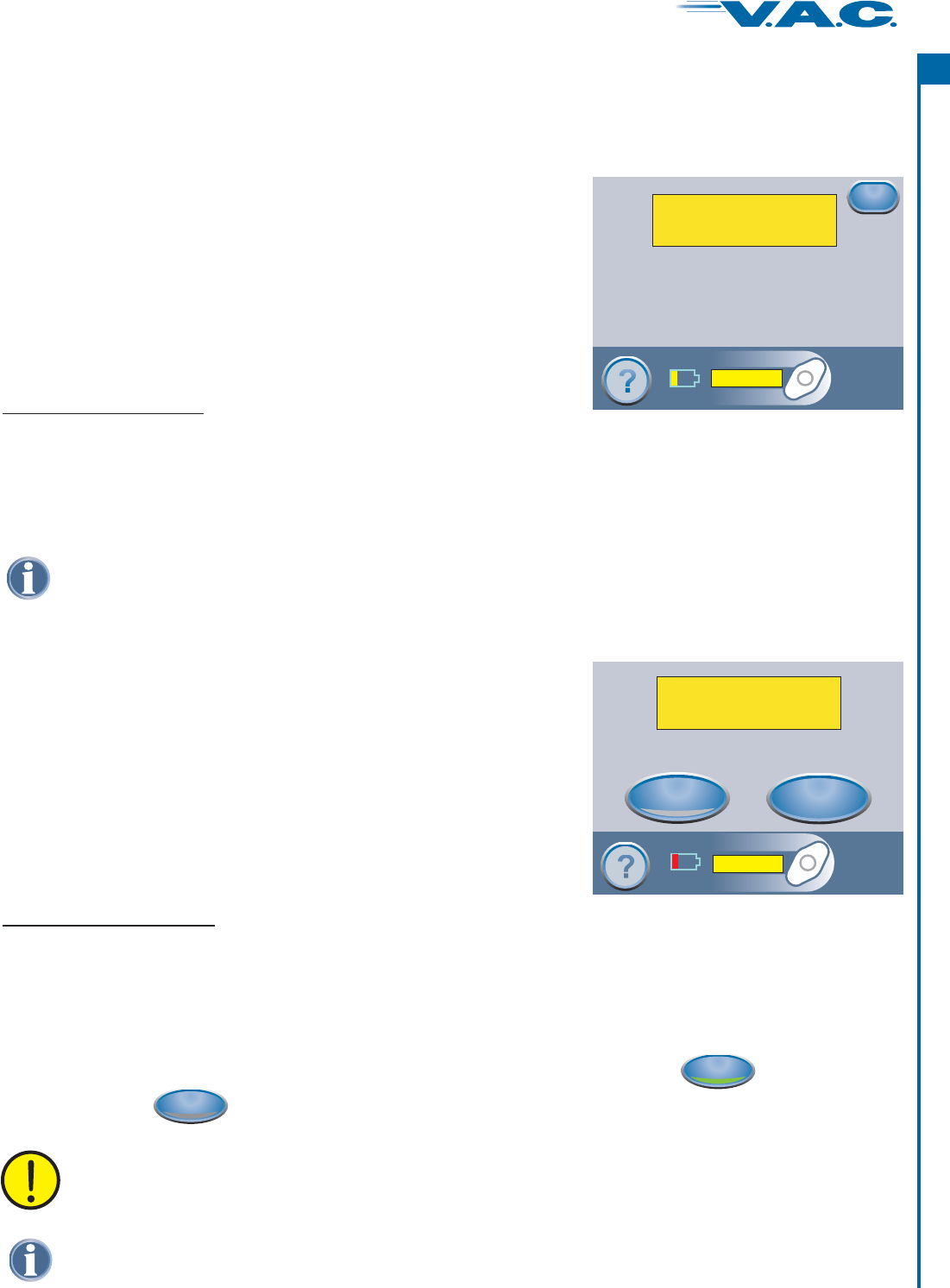
Battery Low Alert
To resolve this alert:
1. Connect therapy unit to wall outlet using ActiV.A.C. Power Supply to recharge battery. An
light next to the bottom-left of the Touch Screen User Interface will indicate charging is
underway. Refer to the Battery Charging section of this manual for more information.
2. Press on this screen to return to the ‘Home Screen’.
®
Amber
‘Exit’
This alert screen appears approximately two (2) hours before
the battery power level is too low to support continued operation
of the ActiV.A.C. Therapy Unit.
This alert will be accompanied by a single audible tone.
®
Battery Low; charging required
Battery Low Alert
Battery Low
Continuous
0 mmHg
Exit
This alarm screen appears approximately minutes
before the battery power level is too low to support continued
operation of the
thirty (30)
ActiV.A.C. Therapy Unit.
This alarm will be accompanied by a repeating audible tone.
This alarm may be silenced for two (2) minutes during
troubleshooting by pressing .
®
‘Audio Pause’
Battery Critical Alarm
On/Off
On/Off
If not, press to restart therapy.
To resolve this alarm:
1. Connect therapy unit to wall outlet using ActiV.A.C. Power Supply to recharge battery. An
light next to the bottom-left of the Touch Screen User Interface will indicate charging is
underway. Refer to the Battery Charging section of this manual for more information.
2. Press ‘ ’ on this screen to return to the ‘Home Screen’.
®
Amber
Reset
3. Ensure therapy is on by confirming that the green crescent is lit on the button.
Audio Pause
Reset
Battery Critical
Battery critically low, charge immediately
Battery Low
V.A.C. Therapy continues; however, if this alarm is not resolved within thirty (30) minutes,
therapy will be interrupted.
®
WARNING: Under clinician supervision, replace V.A.C. Dressing with alternate
dressing if therapy is interrupted for more than two hours.
®
V.A.C. Therapy continues.
®
Alerts and Alarms (cont.)
41
®
A
c
t
I
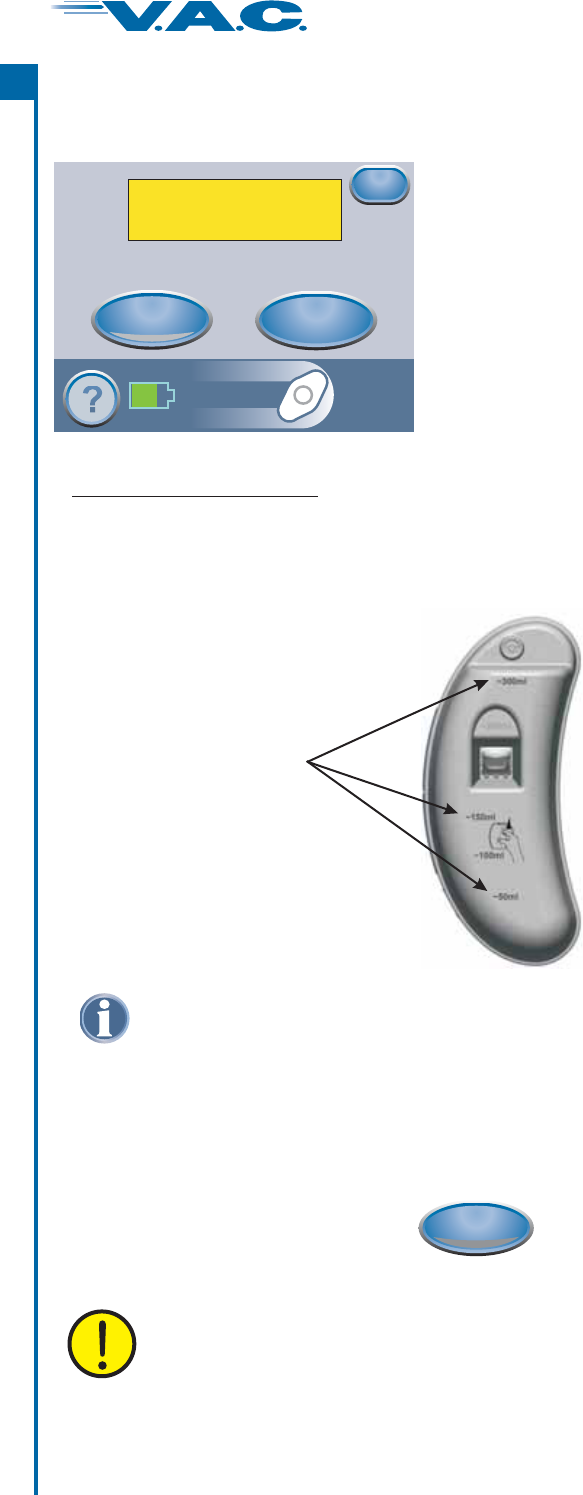
On/Off
4. Restart therapy by pressing .
2. If canister is not full, press “Cancel”.
3. If canister is full, change canister and press ‘ ’ on this screen to return to the ‘Home
Screen’. See the section of this manual for additional information.
Reset
Canister Change
To resolve this alarm:
1. Check fluid level of canister by holding the therapy unit so that the Graduated Marks on the
canister are level and parallel to the floor.
This alarm screen appears when the ActiV.A.C. Therapy Unit
detects that the canister is full and should be replaced.
This alarm will be accompanied by a repeating audible tone.
This alarm may be silenced for two (2) minutes during
troubleshooting by pressing .
®
‘Audio Pause’
Alerts and Alarms (cont.)
Canister Full Therapy Interrupted Alarm
Reset
Canister Full
Therapy Interrupted
WARNING: If Canister is full, replace and press ‘Reset’.
If not full, press ‘Cancel’. Press ‘?’ for more information
Cancel
Audio Pause
WARNING: Under clinician supervision, replace V.A.C. Dressing with alternate
dressing if therapy is interrupted for more than two hours.
®
Graduated Marks
A full canister is approximately 300 ml.
42
®
A
c
t
I

Alerts and Alarms (cont.)
This alarm screen appears when the ActiV.A.C. Therapy Unit
detects that the canister is not fully seated and properly latched.
®
This alarm will be accompanied by a repeating audible tone.
This alarm may be silenced for two (2) minutes during
troubleshooting by pressing .‘Audio Pause’
To resolve this alarm:
1. Remove the canister by pressing the Canister Latch Release on the canister.
2. Inspect the canister and ActiV.A.C. Therapy Unit to ensure no foreign objects or debris
interfere with the canister and therapy unit’s mating surfaces.
3. Ensure both Silicone Seals and both Canister Stabilization Bumpers are present.
®
4. Re-attach the canister to the ActiV.A.C. Therapy Unit ensuring that the canister is fully
engaged and latched. An audible “click” should be heard when canister is properly installed.
5. Press ‘ ’ on this screen to return to the ‘Home Screen’.
®
Reset
WARNING: Under clinician supervision, replace V.A.C. Dressing with alternate
dressing if therapy is interrupted for more than two hours.
®
On/Off
6. Restart therapy by pressing .
7. If this alarm continues to appear, repeat steps 1 through 6 with a new canister. If alarm
condition cannot be resolved, contact KCI. See back cover of this User Manual for country
specific contact information.
Audio Pause
Reset
Canister Not Engaged
WARNING: Ensure canister is in place.
Press’?’ for more information.
Canister Not Engaged Alarm
Silicone Seals
If Silicone Seals or Canister
Bumpers are missing or damaged, contact KCI.
Stabilization
See back cover of this User Manual for country
specific contact information.
Canister Stabilization Bumpers
43
®
A
c
t
I
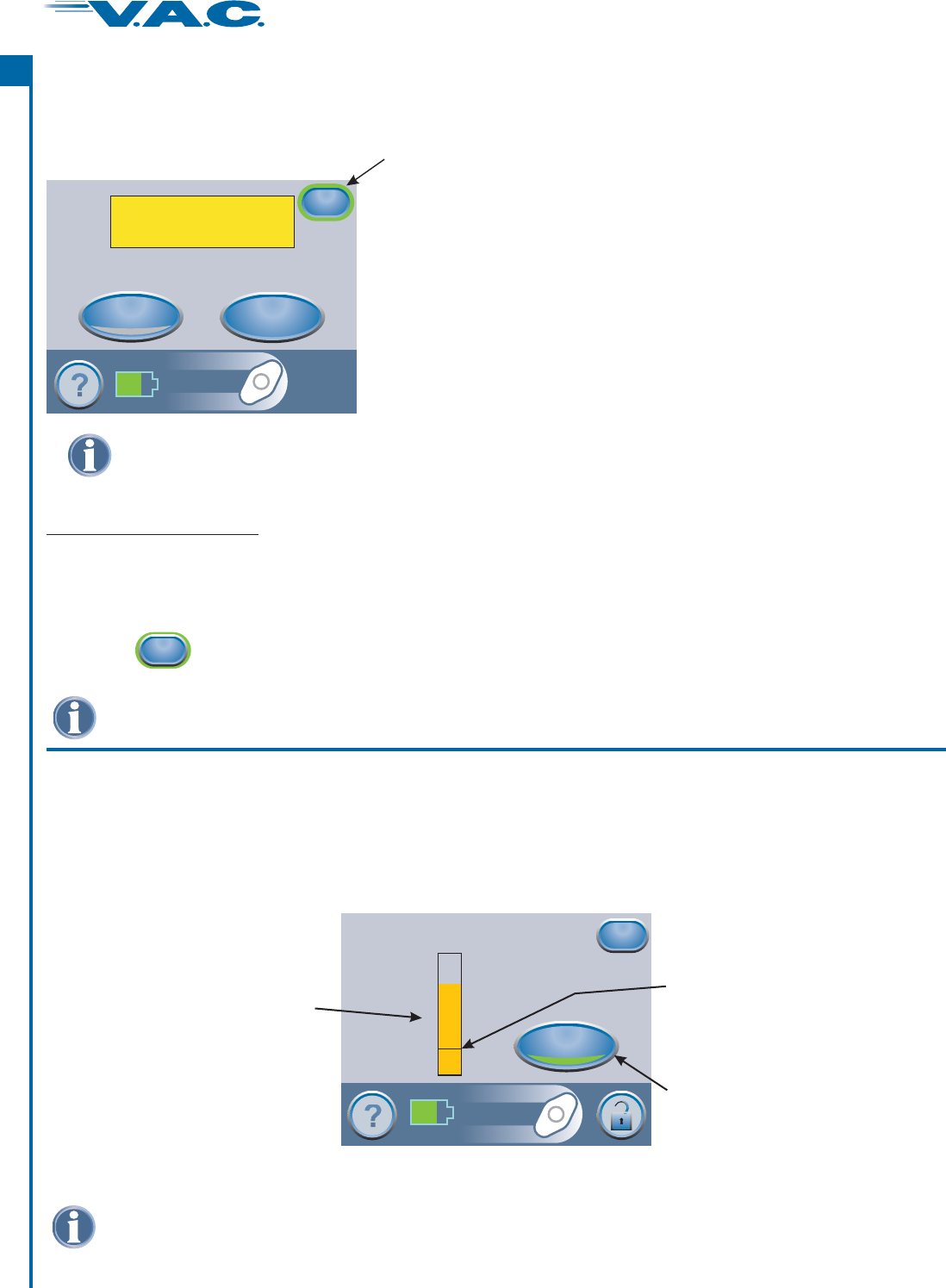
44
®
A
c
t
I
This alarm screen appears when the ActiV.A.C. Therapy Unit
detects a significant air leak.
If this alarm is not resolved in three (3) minutes, therapy will be
interrupted.
This alarm will be accompanied by a repeating audible tone.
This alarm may be silenced for two (2) minutes during
troubleshooting by pressing .
®
‘Audio Pause’
To resolve this alarm:
1. Ensure connector between dressing tubing and canister tubing is properly locked.
2. Ensure canister is fully engaged. (See Canister Not Engaged Alarm.)
3. Press to use the Tool to help identify leaks in dressing.Seal Check
™
Leak Alarm
Seal
Check
™
Alerts and Alarms (cont.)
Audio Pause
Reset
Leak Alarm
Press ‘Seal Check™’ or ‘?’ for more information
Seal
Check
™
If this alarm is resolved within 3 minutes without using , the
automatically reset and the ‘Home’ screen will be displayed.
the Seal Check Tool
ActiV.A.C. Therapy Unit will
Pressing on this screen to return to the ‘Home’ screen.
™
®
‘Reset’
Flashing ovalgreen
The patient’s only access to the Seal Check Tool is through this Leak Alarm screen.
™
The feature provides an audible tone and bar graph to assist in finding leaks.
The frequency of the audible tone and the height of the bar graph will reflect the leak rate.
The audible tone frequency slows down and the bar graph decreases in height as the leak is
found.
Seal Check
™
·
·
·
·
Orange bar graph
indicates a significant leak.
Green bar graph indicates
that the ActiV.A.C.
Therapy System is
operating normally.
®
Finding the Leak
Seal Check
™
Press to turn the Seal Audio
tone on or Off.
Line on bar graph is the
transition point from green
to orange and vice-versa.
Most leaks occur:
where the drape meets the skin.
where the SensaT.R.A.C. Pad is attached to the drape.
at tubing connections.
·
·
·
®
Seal Check™
About
Exit
Leak Rate
Low
High
Seal Audio
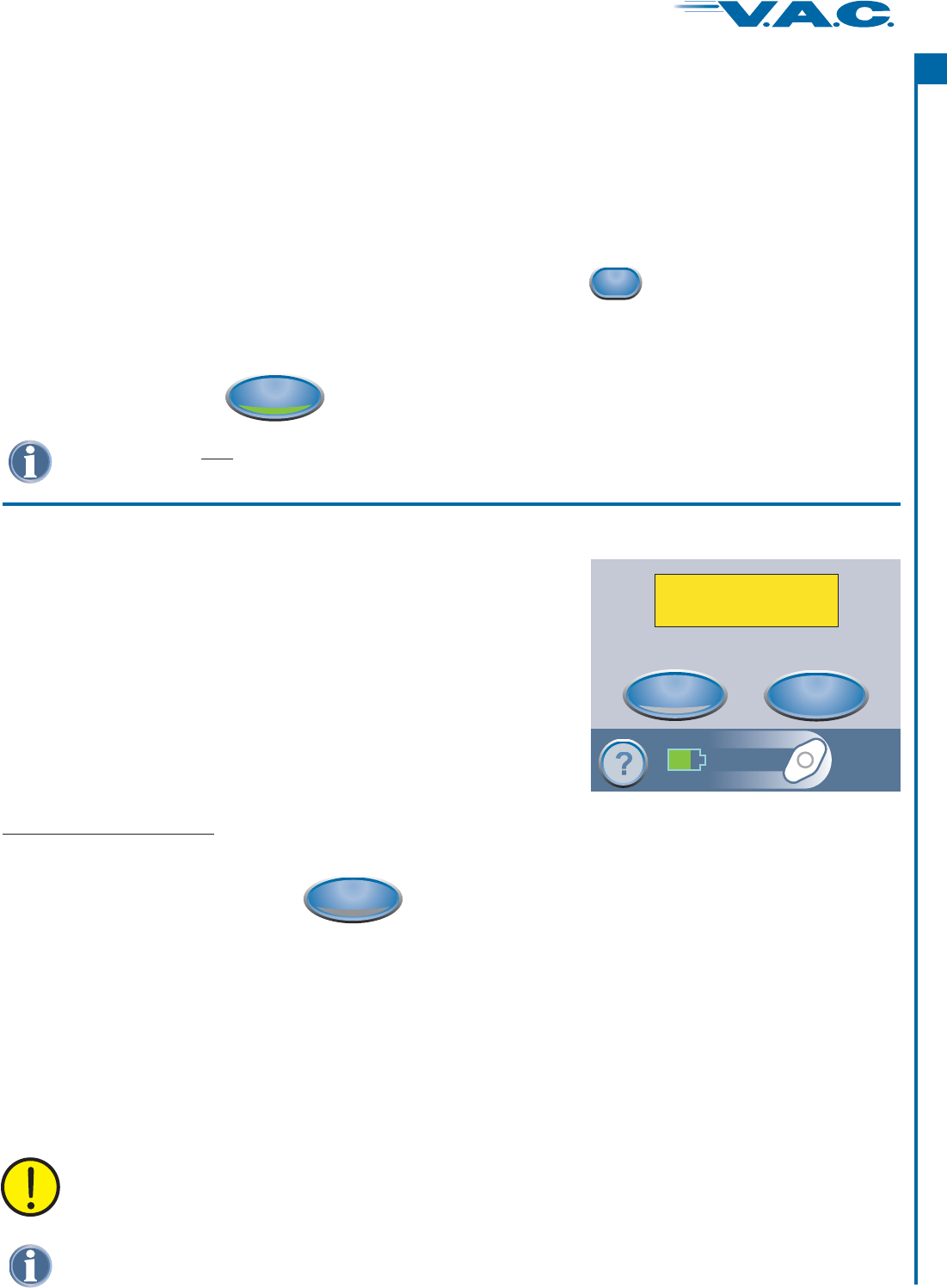
45
®
A
c
t
I
5. Refer to the provided with V.A.C. Dressings
for information on using excess V.A.C. Drape material to seal the leak area.
6. Once the leak is resolved using the Seal Check Tool, press on the Seal Check
screen to return to the ‘Home’ screen.
Dressing Application Instructions for Use
®
®
™ ™
Exit
WARNING: Under clinician supervision, replace V.A.C. Dressing with alternate
dressing if therapy is interrupted for more than two hours.
®
If alarm condition cannot be resolved, contact KCI. See back cover of this User Manual
for country specific contact information.
This alarm screen appears when the ActiV.A.C. Therapy Unit
has detected a leak that has not been resolved and therapy
has been interrupted.
This alarm will be accompanied by a repeating audible tone.
This alarm may be silenced for two (2) minutes during
troubleshooting by pressing .
®
‘Audio Pause’
To resolve this alarm:
1. Press ‘ ’ on this screen to return to the ‘ .Reset Home Screen’
If the leak condition was not resolved, the ActiV.A.C. Therapy Unit will take several minutes to re-
identify that a leak exists before the will reappear and provide the opportunity to
continue troubleshooting a leak using the Tool.
The patient’s only access to the Seal Check Tool is through the Leak Alarm screen.
Should the leak not be resolved within three minutes, this screen will once again appear and
therapy will stop.
®
™
Leak Alarm
Seal Check
™
Audio Pause
Reset
Leak Alarm
Therapy Interrupted
WARNING: Press ? For more information
Leak Alarm Therapy Interrupted
Alerts and Alarms (cont.)
On/Off
2. Restart therapy by pressing .
4. While therapy is on and using light pressure, move your hand and fingers slowly around the
edges of the drape and the SensaT.R.A.C. Pad. The bar graph will lower and the audible tone (if
is on) will slow down when the leak is found.
®
Seal Audio
7. Once the leak is resolved, ensure that V.A.C. Therapy is on by observing that the green
crescent is lit on the button and the icon is rotating on the ‘Home’ screen.
®
On/Off
If this alarm is resolved within 3 minutes, the alarm
will appear and therapy will stop.
not Leak Alarm Therapy Interrupted
Leak Alarm (cont.)
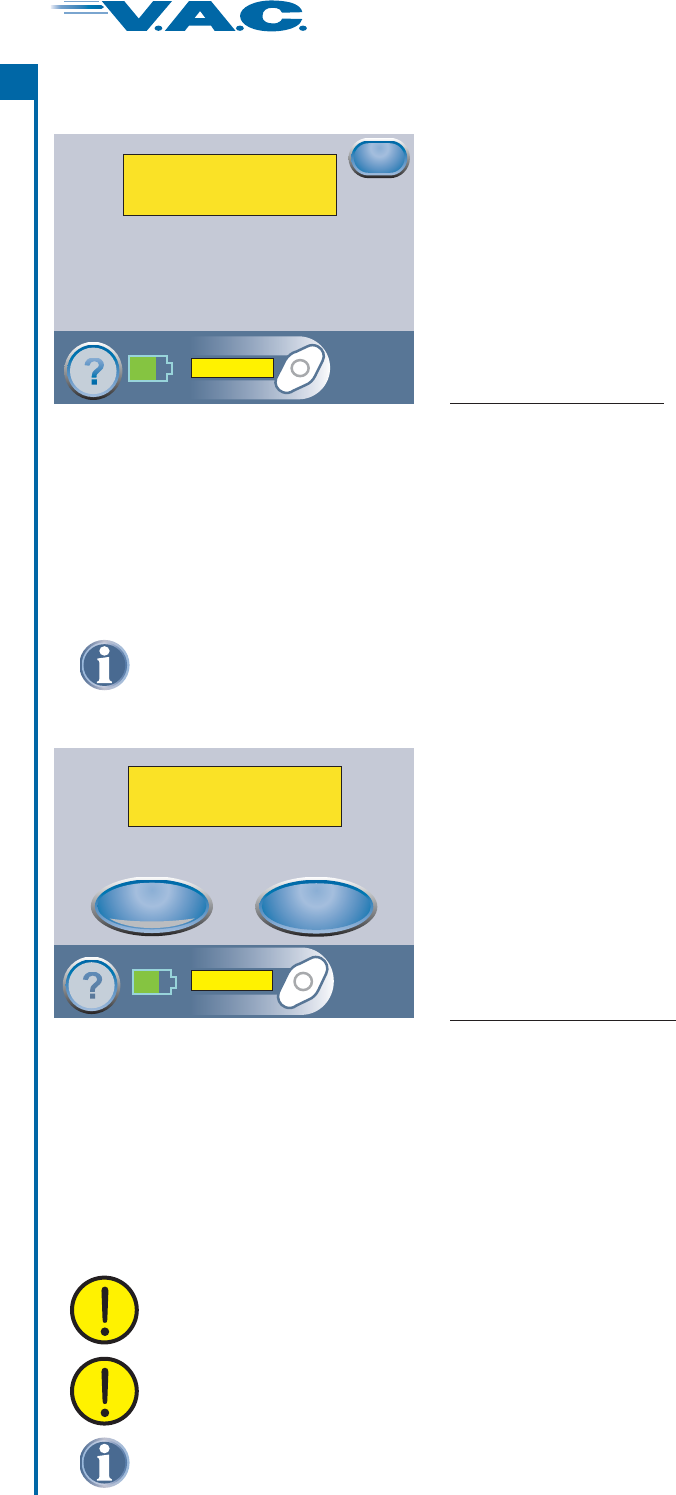
Audio Pause
Reset
Blockage Alarm
Therapy Interrupted
WARNING: Unit may be running, but therapy
is interrupted. Press ‘?’ for more information.
Blockage
Potential Blockage detected
Blockage Alert
Blockage
Continuous
0 mmHg
Exit
Press ‘?’ for more information
1. Ensure both clamps on the dressing and canister tubing are open.
2. Ensure that the tubing is not kinked, crimped or blocked in any way.
3. If the Blockage Alert remains after completing steps 1 and 2, lowering the therapy unit and tubing to the
same level as, or below, the wound site may resolve this alert. If the alert is cleared by lowering the
unit, normal use may resume.
4. Press ‘ ’ on this screen to return to the ‘ .
To resolve this alarm:
Reset Home Screen’
This alarm screen appears when the ActiV.A.C. Therapy Unit has
determined that a blockage is present.
This alarm will be accompanied by a repeating audible tone.
This alarm may be silenced for two (2) minutes during
troubleshooting by pressing .
®
‘Audio Pause’
WARNING: Under clinician supervision, replace V.A.C. Dressing with alternate
dressing if therapy is interrupted for more than two hours.
®
Blockage Alarm Therapy Interrupted
Blockage Alert
1. Ensure both clamps on the dressing and canister tubing are open.
2. Ensure that the tubing is not kinked, crimped or blocked in any way.
3. If the Blockage Alert remains after completing steps 1 and 2, lowering the therapy unit and tubing to the
same level as, or below, the wound site may resolve this alert. If the alert is cleared by lowering the
unit, normal use may resume.
4. Press to return to the screen.
To resolve this alert:
‘Exit’ ‘Home”
This al screen appears when theert ActiV.A.C. Therapy Unit has
detected a potential blockage and is working to determine if a
Blockage Alarm needs to be displayed.
This alert will be accompanied by a single audible tone.
®
Alerts and Alarms (cont.)
The ActiV.A.C. Therapy Unit continues to attempt to apply therapy.
®
If alarm condition cannot be resolved, contact KCI. See back cover of this User Manual
for country specific contact information.
WARNING: Therapy unit remains on; however, negative pressure at the wound
may be below set pressure, potentially compromising therapeutic benefits.
46
®
A
c
t
I
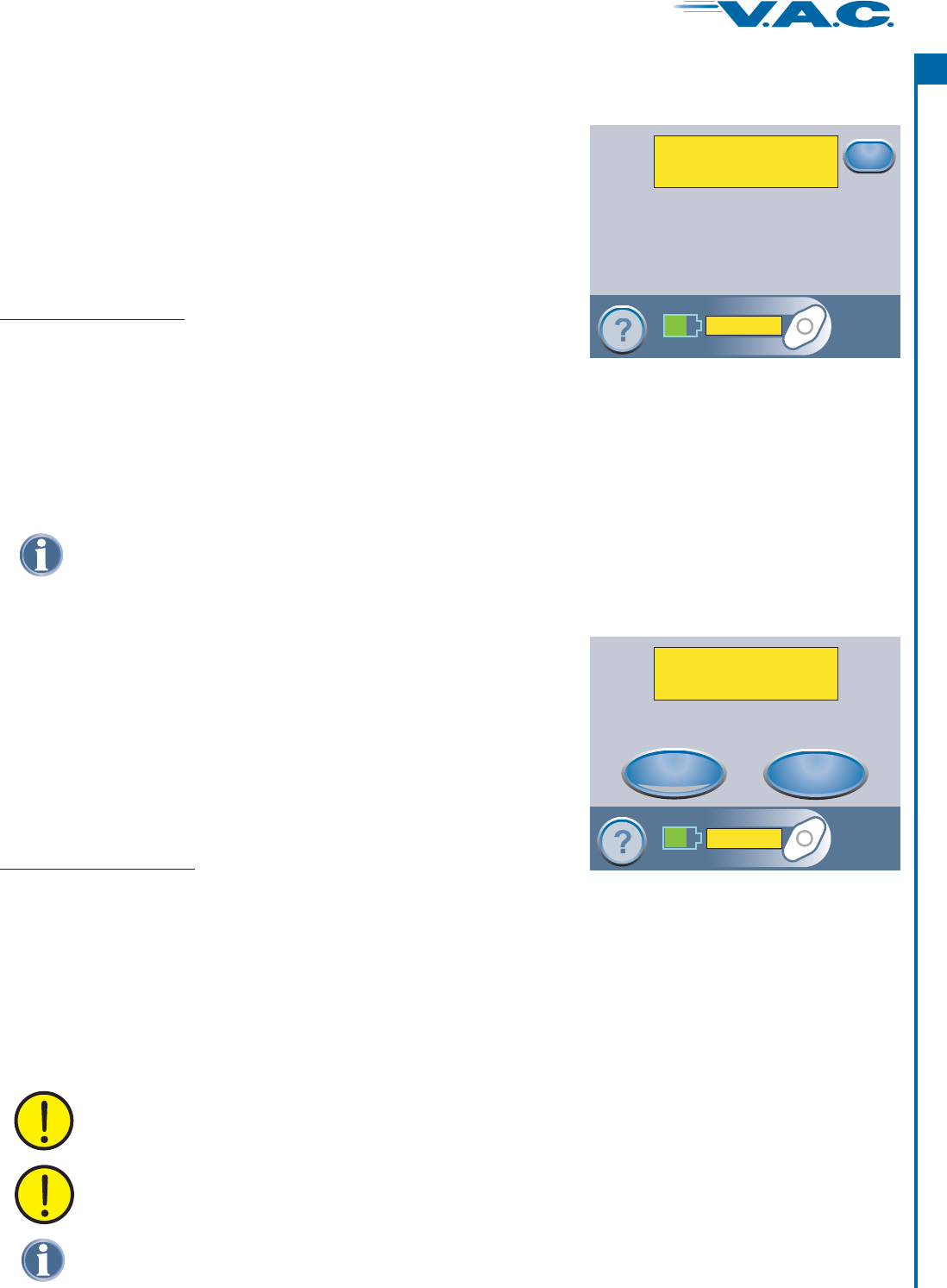
To resolve this alarm:
1. Ensure both clamps on the dressing and canister tubing are open.
2. Ensure that the tubing is not kinked, crimped or blocked in any way.
3. If the Low Pressure Alarm Therapy Interrupted remains after completing steps 1 and 2, lowering the
therapy unit and tubing to be level with or below the wound site may resolve this alarm. If the alert is
cleared by lowering the unit, normal use may resume.
4. Press ‘ ’ on this screen to return to the ‘ .Reset Home Screen’
WARNING: Therapy unit remains on; however, negative pressure at the wound
may be below set pressure, potentially compromising therapeutic benefits.
WARNING: Under clinician supervision, replace V.A.C. Dressing with alternate
dressing if therapy is interrupted for more than two hours.
®
To resolve this alert:
1. Ensure both clamps on the dressing and canister tubing are open.
2. Ensure that the tubing is not kinked, crimped or blocked in any way.
3. If the Low Pressure Alert remains after completing steps 1 and 2, lowering the therapy unit and tubing
to be level with or below the wound site may resolve this alert. If the alert is cleared by lowering the
unit, normal use may resume.
4. Press to return to the screen.‘Exit’ ‘Home”
This al r screen appears when thee t ActiV.A.C. Therapy Unit has not
reached the selected therapy set pressure.
This alert will be accompanied by a single audible tone.
®
Low Pressure Alert
Low Pressure Alarm Therapy Interrupted
Alerts and Alarms (cont.)
This alarm screen appears when the ActiV.A.C. Therapy Unit has
not reached the selected therapy set pressure and negative
pressure at the wound
This alarm will be accompanied by a repeating audible tone.
This alarm may be silenced for two (2) minutes during
troubleshooting by pressing .
®
may be below set pressure, potentially
compromising therapeutic benefits.
‘Audio Pause’
Low Pressure
Low Pressure
Alert
The measured wound pressure is
below the set pressure.
Press ‘?’ For more information
Exit
Audio Pause
Reset
Low Pressure
Low Pressure Alarm
Therapy Interrupted
WARNING: Unit may be running, but therapy is
interrupted. Press ‘?’ For more information
V.A.C. Therapy, at a lower than selected pressure, is still being applied.
®
If alarm condition cannot be resolved, contact KCI. See back cover of this User Manual
for country specific contact information.
47
®
A
c
t
I
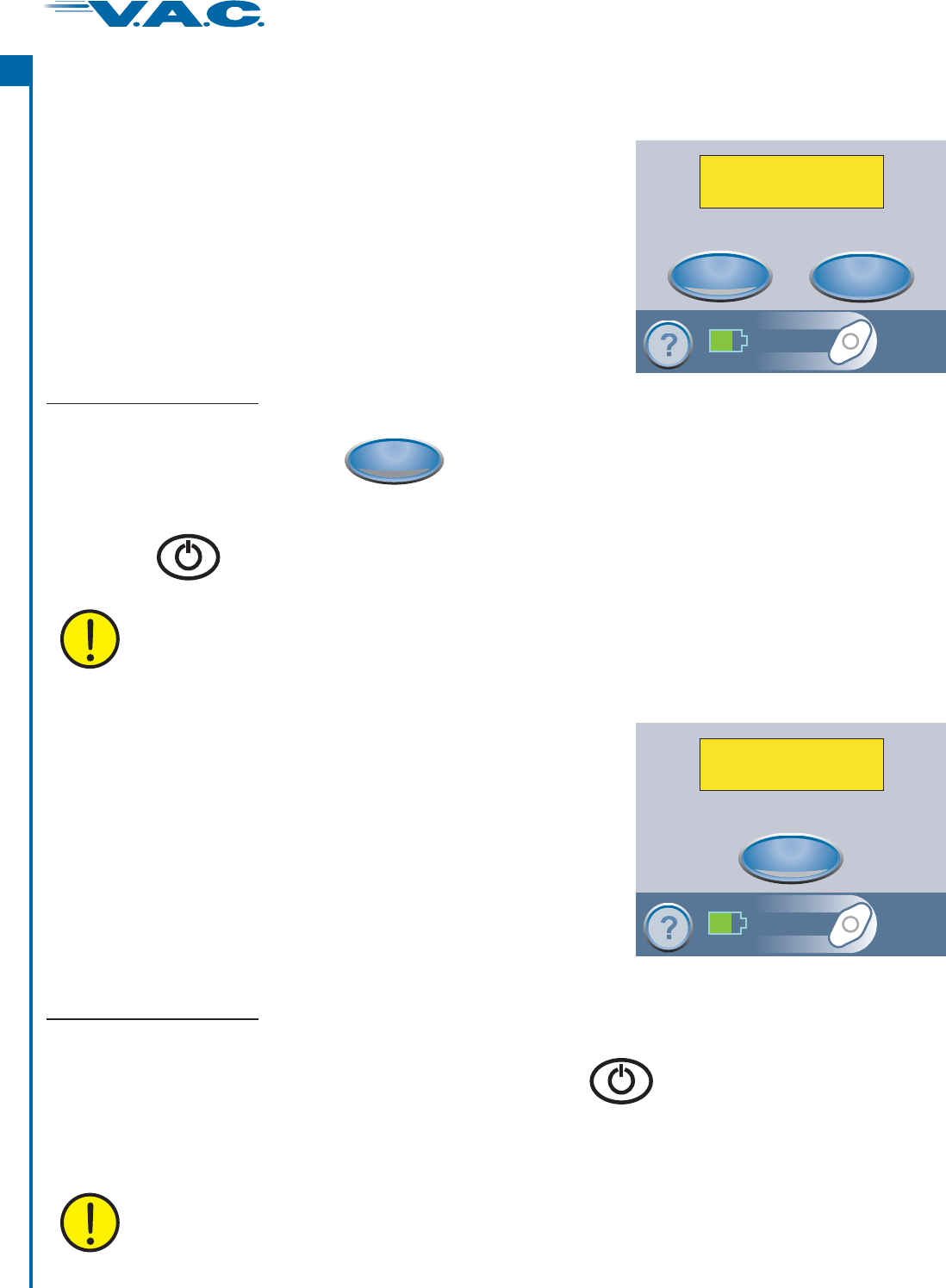
Alerts and Alarms (cont.)
WARNING: Under clinician supervision, replace V.A.C. Dressing with alternate
dressing if therapy is interrupted for more than two hours.
®
This alarm screen appears when the ActiV.A.C. Therapy Unit
has detected that V.A.C. Therapy has been off for fifteen (15)
minutes (with the unit powered on) without the Touch Screen
User Interface being touched.
This alarm will be accompanied by a repeating audible tone.
This alarm may be silenced for two (2) minutes during
troubleshooting by pressing .
®
®
‘Audio Pause’
Audio
Pause
Reset
Therapy Inactive
WARNING: Press ‘Reset’ and Restart Therapy
Press ? For more information
Therapy Inactive Alarm
Audio Pause
System Error
Therapy Interrupted
WARNING: Turn therapy unit off then on if error
continues, contact KCI. Press ‘?’ for more information.
This alarm screen appears when there is a technical fault
within the ActiV.A.C. Therapy Unit.
Several different types of system errors may occur. A number
will appear in the yellow alarm box that represents the
diagnostic code of the technical fault.
This alarm will be accompanied by a repeating audible tone.
This alarm may be silenced for two (2) minutes during
troubleshooting by pressing .
®
‘Audio Pause’
System Error Therapy Interrupted Alarm
WARNING: Under clinician supervision, replace V.A.C. Dressing with alternate
dressing if therapy is interrupted for more than two hours.
®
To resolve this alarm:
1. Press ‘ ’ on this screen to return to the ‘ .
3. If V.A.C. Therapy is not desired, turn the ActiV.A.C. Therapy Unit off by using the
button on the front of the unit.
Reset Home Screen’
Power
On/Off
® ®
On/Off
2. Restart therapy by pressing .
To resolve this alarm:
1. Record the error number.
2. Power the unit off and then on using the button on the front of the unit.
3. If error persists, contact KCI. See back cover of this User Manual for country specific contact
information.
Power On/Off
48
®
A
c
t
I

To resolve this alert:
1. Contact KCI to obtain a new Service Timer code. See back cover of this User Manual for
country specific contact information.
2. Press to enter the code obtained from KCI.‘Enter Code’
This al screen appears when theert ActiV.A.C. Therapy Unit
has reached its service time limit.
Once the Service Timer has expired, this alert will appear
every time the unit is powered up.
When ‘Days Left’ reaches (0) zero, this alert will reappear
periodically during therapy.
®
Enter Code
Continue
Service Timer Expired
Contact KCI Days Left (3)
Service Timer Expired Alert
Alerts and Alarms (cont.)
49
®
A
c
t
I

ActiV.A.C. Frequently Asked Questions
®
Q: How much does the ActiV.A.C. Therapy Unit weigh?
A:
Q: How long does it take to charge the battery and how long will a fully charged
battery last?
A:
Q. The ActiV.A.C. Therapy Unit is sometimes noisy. Why is this?
A.
Q: How do I know if the ActiV.A.C. Therapy Unit is working properly?
A:
Q: What if I do not hear an audible click when installing a canister onto the ActiV.A.C.
Therapy Unit?
A:
Q: Is the ActiV.A.C. Canister specific to the ActiV.A.C. Therapy Unit?
A:
Q: What languages are available in the ActiV.A.C. Therapy Unit?
A:
Q: Is the ActiV.A.C. Therapy Unit allowed in flight?
A:
The ActiV.A.C. Therapy Unit weighs ( with an empty canister installed.
It takes approximately 6 hours to fully charge the battery. The ActiV.A.C. battery can maintain
a charge up to 14 hours.
During normal operation it may be possible to hear the therapy unit stopping and starting
(therapy on/off). This is to ensure accurate delivery of pressure.
The Therapy Status Bar at the bottom of the Touch Screen User Interface indicates specific
therapy information. The rotating icon, also found in the Therapy Status Bar, indicates the
ActiV.A.C. Therapy Unit is applying negative pressure. Wound fluid may or may not be seen
moving in the tubing.
An audible click should be heard when installing a new canister. Occasionally, you may not
hear an audible click. If the canister is properly installed, the canister cannot be removed by
gently pulling the canister directly away from the unit.
Yes, the 300 ml canister is specifically designed to be used with the ActiV.A.C. Therapy Unit.
When fully implemented, the therapy unit is pre-programmed with the following languages:
English, Spanish, Swedish, Dutch, German, Italian, French, and Danish.
Commercial airlines will allow the ActiV.A.C. Therapy Unit to be carried onboard with
documentation from a physician, typically in the form of a doctor's prescription. The User
Manual should also be available for presentation, and not in checked baggage. The label on
the therapy unit and the User Manual identify the ActiV.A.C. Therapy Unit as a medical
device.
The security check point can be handled in one of two ways:
®
®
®
®
® ®
®
®
®
®
®
®
®
®
~1.08 kg ~2.4 lbs)
·
·
The canister tubing and dressing tubing can be clamped and disconnected from each
other. This will allow the therapy unit and canister to go through security detection in a
bin, while the patient moves through the security scanner with the dressing in place.
Alternatively, the patient can keep the dressing attached to the therapy unit, and have the
security personnel hand-wand the patient and therapy device
WARNING: Languages should only be selected according to local regulatory
requirements.
50
®
A
c
t
I
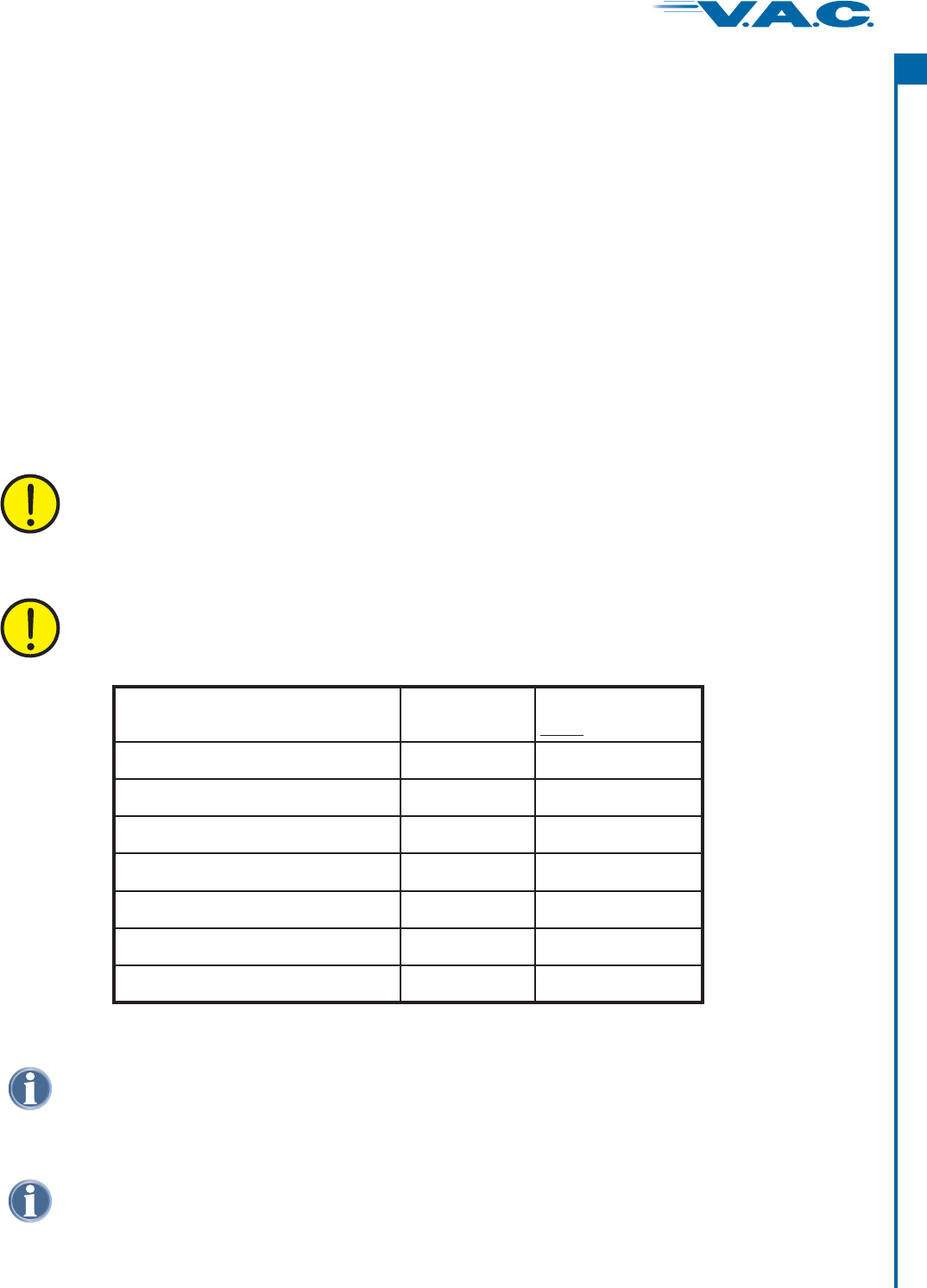
All airline rules and regulations regarding electronic equipment must be followed when
traveling by air. The device should be turned off, in keeping with other electronic devices
(during take off and landing). If the unit is off longer than 2 hours, the V.A.C. Dressing
should be removed and replaced with an alternate dressing.
®
ActiV.A.C. Frequently Asked Questions (cont.)
®
Q: Are there any recommendations to note when traveling?
A:
Q: Can the ActiV.A.C. Therapy System be used when undergoing diagnostic procedures?
A:
It is recommended that the patient travel with a fully charged battery, an alternate dressing,
extra ActiV.A.C. Canister and the User Manual. Consult your clinician prior to traveling for
patient specific recommendations. A car adapter is available, for a fee, from your KCI
representative.
The chart below can be used to determine whether V.A.C. Therapy can continue during
specific procedures.
®
®
®
Diagnostic Procedures
MRI
HBO
X-Ray
CAT Scan (CT)
Dye Tests
Fluoroscopy
Ultrasound
Therapy Unit
Compatible
Therapy Unit
CompatibleNOT
X
X
X
X
X
X
X
WARNING: It is important to note that the ActiV.A.C. Therapy Unit cannot be taken
into the Magnetic Resonance Imaging (MRI) suite or the Hyperbaric Oxygen Therapy
(HBO) chamber.
®
See the V.A.C. Therapy General Safety Information Sheet that
accompanies the ActiV.A.C. Therapy Unit for specific instructions concerning MRI
and HBO therapy.
®
®
WARNING: Under clinician supervision, replace V.A.C. Dressing with alternate
dressing if therapy is interrupted for more than two hours.
®
There is a possibility of shadow casting in the area of the wound if the V.A.C. Dressing is
left in place for the diagnostic procedures that are indicated Therapy Unit Compatible. The
decision to keep the V.A.C. Dressing in place or not should be made by the radiologist,
radiology technician and/or the wound care practitioner.
To help provide safe and effective use, V.A.C. Dressings are only to be used
with V.A.C. Therapy Units.
®
®
®
®
Please note:
51
®
A
c
t
I

Standard Precautions
The following are the KCI recommended daily and weekly cleaning and infection control procedures
for the ActiV.A.C. Therapy Unit.
®
Always follow Standard Precautions.
Standard Precautions are designed to reduce the risk of transmission of microorganisms from both
known and unknown sources of infection. These precautions can be applied to all patients,
regardless of their diagnosis or presumed infection status. Standard Precautions should be used
when contact is anticipated with blood and all body fluids. This also includes secretions and
excretions, except sweat, regardless of whether blood is visible or not, non-intact skin (i.e., open
wounds) and mucous membranes.
Proper hand washing is the most important step in preventing the spread of infection. Follow these
steps to properly wash hands:
Wet hands with warm, running water and apply liquid or clean bar soap. Lather well.
Rub hands together vigorously for at least 15 seconds.
Scrub all surfaces, including the backs of hands, wrist, between fingers and under fingernails.
Rinse well.
Dry hands with a clean or disposable towel.
Use a towel to turn off the faucet.
Alcohol based hand sanitizers are a good alternative when soap and water are not available. They
have been shown to be more effective than soap and water in decreasing the number of bacteria
and viruses. Use only 'alcohol based' products since the hand sanitizers without alcohol do not have
the same effect. To properly use an alcohol based sanitizer, follow these steps:
Apply about ½ teaspoon of the product to the palm of the hand.
Rub hands together, covering all surfaces of the hands, until they are dry.
If hands are visibly dirty, however, wash with soap and water rather than a sanitizer.
Wash hands before and after direct contact with the patient. When using gloves, wash hands
immediately after gloves are removed, between patient contacts and when necessary to avoid
transfer of microorganisms to other patients or environments. It may be necessary to wash hands
between tasks and procedures on the same patient to prevent cross-contamination of different body
sites.
Wear medical gloves when touching blood, body fluids, secretions, excretions and contaminated
items. Medical gloves may be clean and non-sterile, latex or latex-free. Put clean gloves on just
before touching moist areas, such as mucous membranes and non-intact skin. Change gloves
between tasks and procedures on the same patient when gloves become contaminated or soiled.
Remove gloves promptly after use, before touching non-contaminated items and environmental
surfaces. Gloves do not provide complete protection against hand contamination. Hands should be
washed immediately after completed tasks or procedures to avoid transfer of microorganisms to
other people or environments.
Wear a mask and eye protection or a face shield to protect the mucous membranes of the eyes,
nose and mouth during procedures, and patient care activities that are likely to generate splashes or
sprays of blood, body fluids, secretions and excretions.
Hand Washing
Gloves
Mask, Eye Protection, Face Shield
·
·
·
·
·
·
·
·
52
®
A
c
t
I
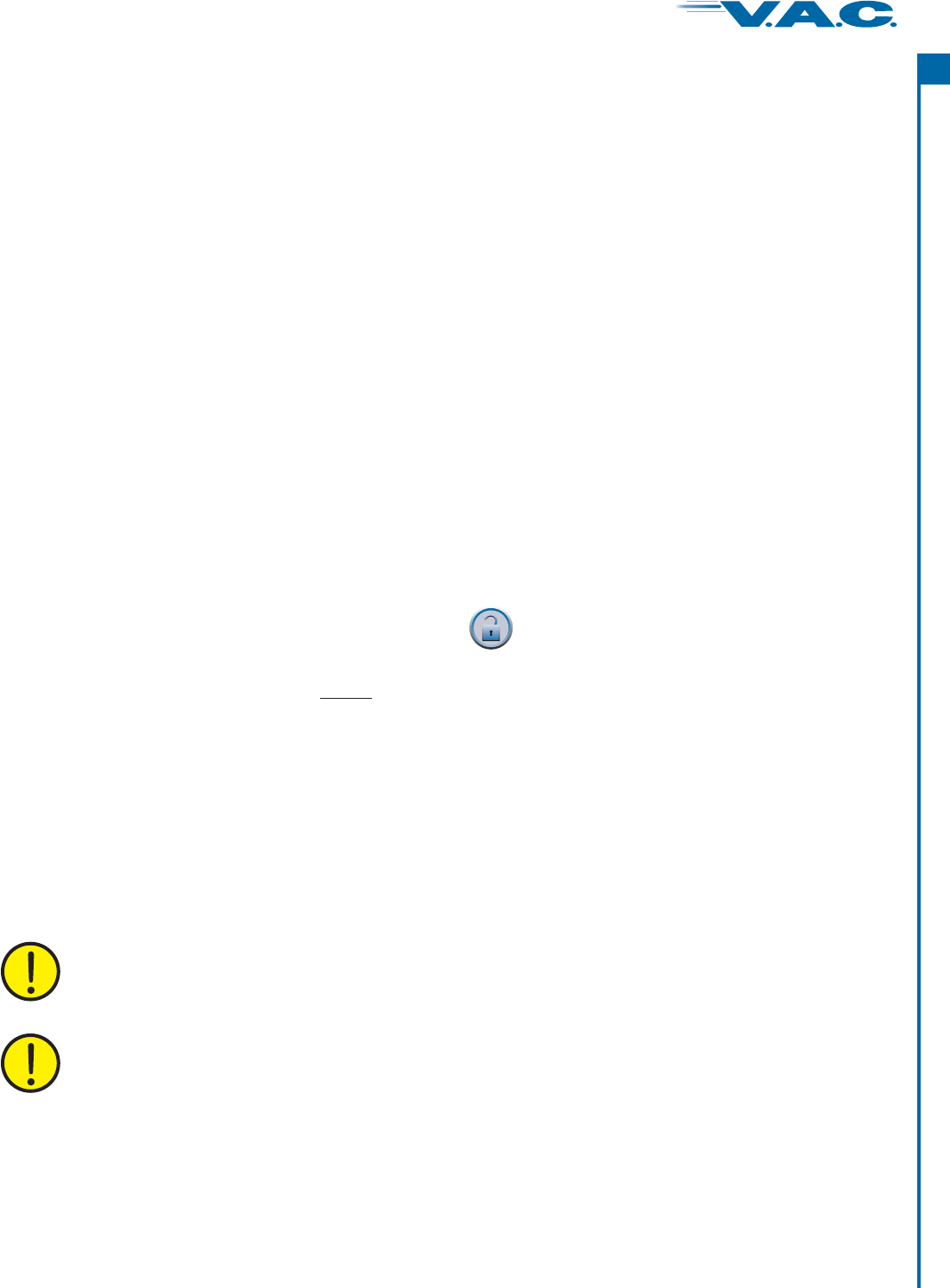
Gown
Patient Care Equipment
Linen
Waste Disposal
Wear a gown (a clean, non-sterile gown is adequate) to protect skin and to prevent soiling of clothing
during procedures and patient care activities that are likely to generate splashes or sprays of blood,
body fluids, secretions or excretions. Select a gown that is appropriate for the activity and amount of
fluid likely to be encountered. Remove a soiled gown as promptly as possible, and wash hands to
avoid transfer of microorganisms to other people or environments.
Handle used patient care equipment soiled with blood, body fluids, secretions and excretions in a
manner that prevents skin and mucous membrane exposures, contamination of clothing and transfer
of microorganisms to other patients or environments.
Handle, transport and process used linen soiled with blood, body fluids, secretions and excretions in
a manner that prevents skin and mucous membrane exposures and contamination of clothing and
that avoids transfer of microorganisms to other people, patients and environments.
Discard all disposable items (all tubing, connectors, clamps, used canister, used dressings, etc.) in
accordance with local medical waste disposal regulations.
Standard Precautions (cont.)
Care and Cleaning
Cleaning the Touch Screen User Interface
Daily Care and Cleaning
Alerts and Alarms
Weekly Care and Cleaning
·
·
·
Lock the Touch Screen User Interface by pressing . Follow on screen instructions to unlock.
Do not use any liquid to clean the Touch Screen User Interface.
Use a soft, non-abrasive cloth to clean the Touch Screen User Interface. Pressing too hard
may damage the Touch Screen User Interface.
Perform a visual inspection of the unit. Check for any sign of contamination and ensure that the unit is
functioning properly. If there are signs of contamination or the unit appears dirty, follow the Weekly
Care and Cleaning instructions below.
If the unit is not operating properly refer to the section of this manual or contact your
healthcare provider or KCI.
Avoid spilling liquid on any part of the ActiV.A.C. Therapy Unit. Liquids remaining on
electronic controls can cause corrosion which can cause the electronic components to fail.
Component failure may cause the ActiV.A.C. Therapy Unit to operate erratically, possibly
causing a potential hazard to patient or care providers.
Particular care must be taken when handling undiluted chlorine bleach, including proper
shielding of eyes. Always mix solution by adding the concentrated chlorine bleach to the
water.
To help reduce risk of infection and contact with blood and body fluids wear protective equipment when
cleaning the ActiV.A.C. Therapy Unit.
At least once per week, the ActiV.A.C. Therapy Unit should be wiped with a diluted solution of 5
milliliters bleach in 1 liter (1 teaspoon bleach in 1 quart) of warm water. Use a soft cloth and wring out
excess solution until the cloth is damp and not dripping. Other cleaning solutions should not be used as
they may damage the ActiV.A.C. Therapy Unit.
gently
®
®
®
®
®
53
®
A
c
t
I

This page left intentionally blank
54
®
A
c
t
I
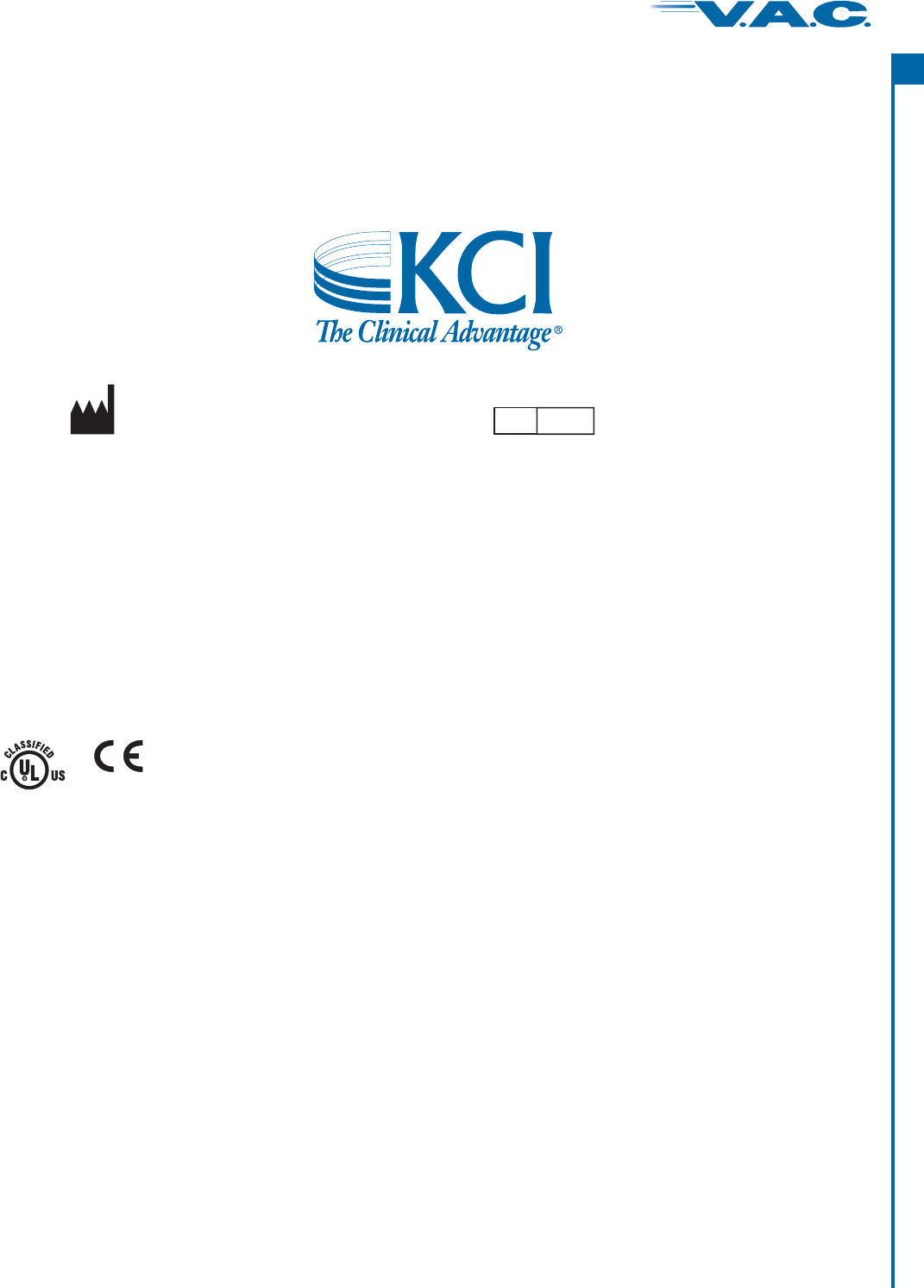
0473
5KA5
© 2007 KCI Licensing, Inc. All Rights Reserved. All trademarks designated herein are property of KCI Licensing,
Inc, its affiliates and licensors. Those KCI trademarks designated with the "®" symbol are registered and those
designated with "TM" are considered to be proprietary trademarks or are pending trademark applications in at
least one country where this product/work is commercialized. Most KCI products referred to herein are subject to
patents or patent applications.
For additional information concerning the System,
contact your local KCI Representative or:
ActiV.A.C. Therapy
®
KCI USA, INC.
San Antonio, Texas 78219 USA
www.kci1.com
Manufacturer Information
Manufacturer
REPEC
KCI Medical Products (UK), Ltd.
Wimborne, Dorset
BH21 7SH
United Kingdom
www.kci-medical.com
55
®
A
c
t
I
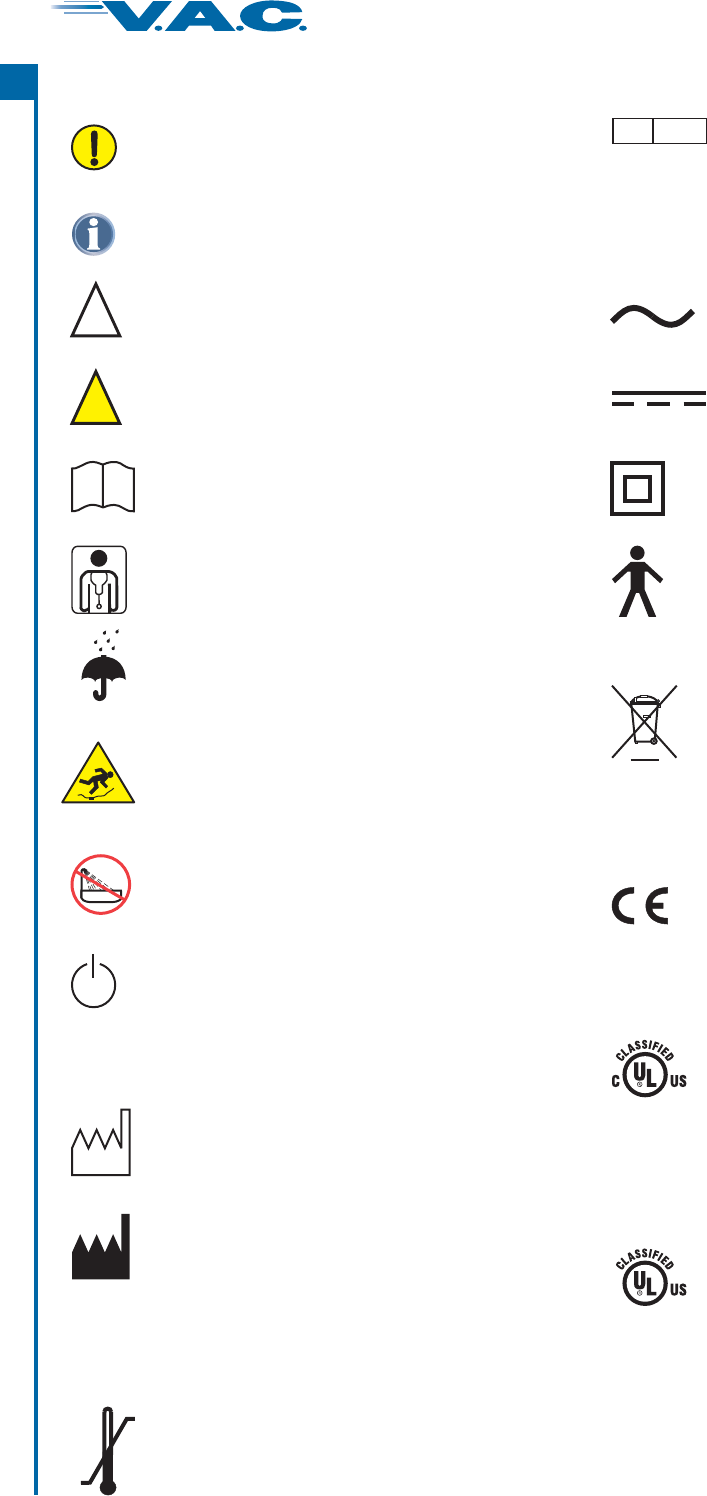
5KA5
Medical Equipment classified with
respect to Electrical Shock, Fire
and Mechanical Hazards Only in
accordance with UL 60601-1
Standards, including JIS amendment
by Underwriters Laboratory Inc.
Explanation of Symbols Used
Type B, Applied Part
IPX0
Not protected against harmful
effects of water
Class II
Alternating Current
!
Caution: Consult Accompanying
Documents
!
WARNING: Consult Accompanying
Documents
Conforms with the Waste Electrical
and Electronic Equipment Directive
(2002/96/EC). At the end of useful life,
dispose of all waste according to local
requirements, or contact your local
KCI subsidiary or agent for advice.
Medical Equipment classified with
respect to Electrical Shock, Fire
and Mechanical Hazards Only in
accordance with UL 60601-1 and to
CAN/CSA C22.2 No. 601.1
Standards, including JIS amendment
by Underwriters Laboratory Inc.
Tripping Hazard
Warning or Caution statement of
possible hazard to system, patient
or staff
Important Operational Information
Direct Current
0473
5KA5
No Bathing or Showering
Date of Manufacture
Manufacturer
SN
Serial Number
Power On/Off
Consult Instructions For Use
i
Conforms with the Medical Device
Directive (93/42/EEC) and has
been subject to the conformity
procedures laid down in the council
directive.
Temperature Limits Symbol
Approximate symbol
~
Keep Dry
Clinician Use Only
REPEC
Authorized Representative in the
European Community
Refer to Explanation of Symbols Used if
symbols appear on the product or
accompanying documentation.
56
®
A
c
t
I

Specifications*
Dimensions:
Weight (with empty canister attached): ~1.08 kg
Pressure Options: 25 to 200 mmHg
(3.3 to 26.6 kPa)
Therapy Delivery Modes: Continuous or Intermittent
Canister Volume: ~300 ml
Battery Run Life: Approximately 14 hours,
depending on settings.
Battery Charge Time: Approximately 6 hours from
a fully discharged state.
External Power Supply Output: 12V, 3.3 A
Patient & Enclosure Leakage Current: <100 Microamps
Storage Conditions
Temperature Range: (-4°F) to 140°F)
Relative Humidity Range: 0-95% non-condensing
Operating Conditions
Temperature Range: 41°F) to (104°F)
5
IEC Classification
Medical Equipment
Equipment not suitable for use in presence of flammable anesthetic mixture with
air, oxygen or nitrous oxide.
Type B, Applied Part
Class II
IPX0
*Specifications subject to change without notice.
19.3 x 15.2 x 6.4 cm
(7.6” W x 6” H x 2.5” D)
(~2.4 lbs)
External Power Supply Input: 100-240VAC .72A @ 115VAC
47-63 Hz
-20°C 60°C (
5°C ( 40°C
Relative Humidity Range: 0-9 % non-condensing
Altitude Range: 0 to 4267 m (0 to 14,000 feet)
Optimum Performance: 0 to 2438 m (0 to 8,000 feet)
Electrical:
Environmental Conditions:
57
®
A
c
t
I

®
A
c
t
I
Customer Contact Information
July 2007
340076 Rev B
Australia
KCI Medical Australia Pty. Ltd.
T: +61 (0) 2 9630 8877
Orders: 1300 KCI VAC (1300 524 822)
F: +61 (0) 2 9630 8855
Orders Fax: 1800 KCI VAC (1800 524 822)
E-mail: [email protected]
Enquiries: 1800 815 529
Austria
KCI Austria GmbH
T: +43 (0)1 86 330
F: +43 (0)1 86 330 6
E-mail: [email protected]
Belgium
KCI Medical Belgium bvba
T (free): 0800 73411
T: +31 (0)30 635 58 85
F (free): 0800 73415
F: +31 (0)30 259 96 91
E-mail: [email protected]
Canada
KCI Medical Canada, Inc.
T: +1 905 565 7187
T (free): 1 800 668 5403
F: +1 905 565 7270
E-mail: [email protected]
Denmark
KCI Medical ApS
T: +45 3990 0180
F: +45 3990 1498
E-mail: [email protected]
Norway
KCI Medical AS
T: +47 (0) 6684 5100
F: +47 (0) 6684 5099
Visitor's address: Nye Vakåsvei 12NO-1395
Hvalstad
Netherlands
KCI Medical B.V.
T: +31 (0)30 635 58 85
F: +31 (0)30 637 76 90
E-mail: [email protected]
France
KCI Medical Sarl
T:+33(0)169747171
T (free): 0 800 47 83 47
F:+33(0)169747172
E-mail: [email protected]
Germany
KCI Medizinprodukte GmbH
24h Hotline: 0800 783 3524
T: +49 (0)611 33544-0
freefax: 0800 329 3524
F: +49 (0)611-33544-759
E-mail: [email protected]
Ireland
KCI Medical Ltd.
T: +353 (0)14659510
T (free): 1800 333377
F: +353 (0)14659500
E-mail: [email protected]
Italy
KCI Medical Srl
T: +39 02 457 1741
F: +39 02 457 1742 10
E-mail: [email protected]
Japan
KCI KK
Tel: +81-3-3230-3854
Fax: +81-3-3230-3856
Latin America
KCI International
T (free): 1 800 531 5396, extension 6335
T: +1 210 255 6335
F: +1 210 255 6991
E-mail: [email protected]
South Africa
KCI Medical South Africa (Pty.) Ltd.
T: +27 (0)11 315 0445
F: +27 (0)11 315 1757
E-mail: [email protected]
Middle East (Rep. Office)
KCI Medical Middle East
T: +971 4 20 454 20
F: +971 4 20 454 16
E-mail: [email protected]
Spain
KCI Clinic Spain, S. L.
T: +34 902 100 835
F: +34 902 200 835
E-mail: [email protected]
Sweden
KCI Medical AB
T: +46 (0)8 544 996 90
F: +46 (0)8 544 996 91
E-mail: [email protected]
0473
5KA5
Singapore
KCI Medical Asia Pte. Ltd.
T: +65 6742 6686
F: +65 6749 6686
E-mail: [email protected]
Switzerland
KCI Medical GmbH
T: 0848 848 900
T: +41 (0)43 455 3000
F: 0848 848 901
F: +41 (0)43 455 3020
E-mail: [email protected]
United Kingdom
KCI Medical Ltd.
24h Hotline: +44 (0)800 980 8880
T: +44 (0)1865 840 600
F: +44 (0)1865 840 626
E-mail: [email protected]
International
KCI Europe Holding B.V.
The Netherlands
T: +31 (0)20 426 0000
F: +31 (0)20 426 0099
E-mail: [email protected]
www.kci-medical.com
